So my talk is called “Creativity cannot be computed”.
Slide 1
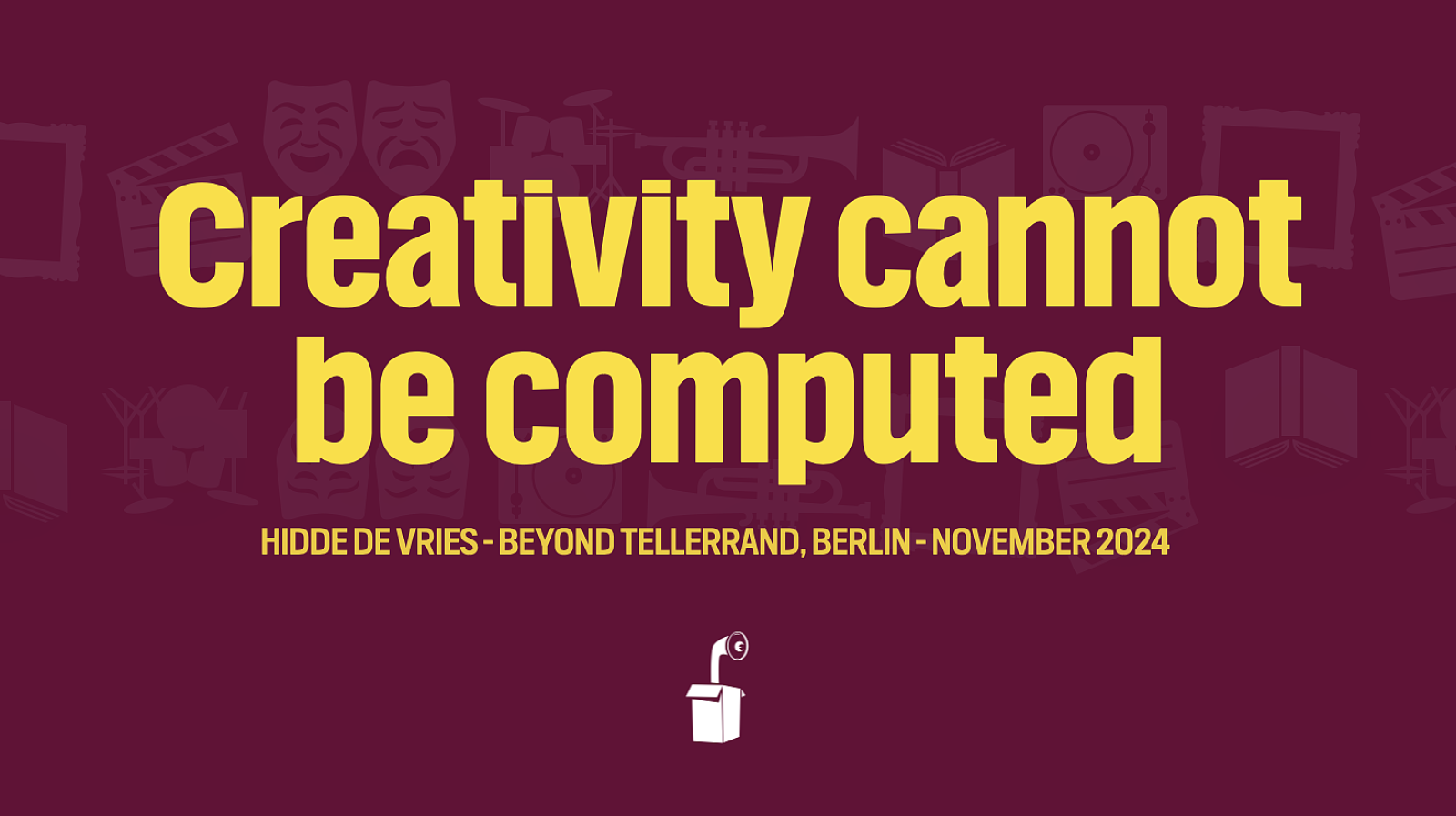
Slide 2

And let me be clear, I’m not against computers, I love them. I’ve got one in my hand right now, I could not function without it. It takes me places, I get to stay in touch with loved ones, photograph my live… yeah… computers are very useful.
Slide 3

but we tend to overestimate their power.
Slide 4

we tend to overestimate how quickly tech can progress.
Slide 5

In 2013, a man whose hubris needs no introduction, Elon Musk, said he would build a “hyperloop” connection between two US cities, and said it would take him three to four years to build the prototype.
Slide 6

Adding, if it was his top priority, he could get it done in one or two years. Note that was 10 years ago.
Slide 7

We tend to overestimate computing…
Slide 8

… while underestimating creative work.
When Facebook CEO Mark Zuckerberg was asked why he wouldn’t pay writers more for the work he uses to train his data sets…
Slide 9

he said creators tend to overestimate the value of their conttent.
Slide 10

Sam Altman of OpenAI, the company that makes tools that can generate text and images, he said “Creativity has been easier for AI than people thought”. This was in response to what he said the year before: that it would be hard.
What changed, I wondered when I heard that, what exactly has been easier?
Slide 11

And he continued, “you can see Dall-E generate amazing images, write creative stories with GTP-4”… aah… ok, I thought.
Slide 12

Of course he would say that, these are products his company makes and sells.
I don’t know, I think this warrants a deeper look at both creativity and computing…
Slide 13

So what is computing?
Slide 14

Computing is the manipulation of numbers, which was traditionally done by humans.
Slide 15

They started doing this literal millenia ago, 2000 BC in Babylonia, current-day Iraq and bits of Iran and Syria. They did geometry on clay tablets.
Slide 16

The Plimpton 322 tablet from that time, to me somewhat resembles an Excel sheet. Kidding aside, this calculates things, it’s explained on Wikipedia, I don’t know exactly what it does.
Slide 17

So computing is manipulating numbers.
Slide 18

And these days often also manipulating data.
Slide 19

And doing completing tasks automatically.
Slide 20

It often also means that we’re “throwing technology at something”.
Slide 21

Charles Babbage wanted to do this too. In the early 19th century, this mathematician worked on different “machines” to compute numbers.
Slide 22

Te first one, the Difference Engine was mostly for mathematical equations, the second was suposed to also store information, which, as programmers here will know, means it would do programming. Nice.
Note these machines at the time were mostly thought experiments, they were not actual working machines until many years later people tried to build them as described. The pictures are models that scientists built many years after the fact.
Slide 23

At a certain point, Babbage got acquainted with Ada Lovelace, a young mathematician, I understand she was about 17 at the time, who was very interested in these machines. They had a lot of conversations about it.
When at some point, she translated an Italian article about the machines to English, she added a bunch of notes, a lot of notes that put the machines in context and show off what it could do. This bascially made her the OG DevRel.
In these notes she described procedures for making the Analytical Machine do stuff, this as with punch cards, and these instructions are what we now historically see as the first algorithm.
If that’s not impressive enough, she also looked reflected on the machine itself and how it fits in the world.
Slide 24

She wrote, in Note G: ““It is desirable to guard against the possibility of exaggerated ideas that might arise as to the powers of the Analytical Engine. ””
Basically telling us not to get too excited.
Slide 25

Years later, people kept trying to solve more of the problems around mathematics.
Alan Turing famously wrote his paper “On computable numbers”. The mathematician Hilbert had written that there could be one algorithm, one way, that could tell for any mathematical equation whether it is provable or not, and in “On computable numbers”, Turing showed this isn’t the case, using the concept of turing machines in his paper to explain.
Slide 26

My summary probably doesn’t do justice what happened there, it’s fairly technical. The book Turing’s vision does an excellent job explaining exactly what Turing did there.
Slide 27

Or you can watch the slightly Hollywoodify’d version of that story, the film The Imitation Game.
Slide 28

A few years later, then assistant professor John McCarthy at Dartmouth College in the US, decided to propose a summer project on a new field that he, in that proposal, called “artificial intelligence”.
He suggested 10 men should get together, yeah, it really says ‘men’… they got together for six weeks and some didn’t even stay the full six weeks. The idea was to solve computer science and some of its major problems. They listed 7 in the proposal, the 7th being “creativity” (true story).
Slide 29

They thought they’d make a lot of progress quickly. And they made a lot of progress, it was amazing. But, McCarthy said in 2008: “AI was harder than we thought.” Of course it was, intelligence is a complex beast.
(From Melanie Mitchell’s presentation “Why AI is harder than we think”)
Slide 30

So if we look the timeline of where we’ve kind of gone with computer science… Ada Lovelace and Babbage’s work lead to the first algorithms, Turing machines were influential in programming languages in general. Then Grace Hopper invented the first programming language, COBOL, and compilers, so that we didn’t have to talk directly to computers anymore.
Other concepts got invented, like Inverse Document Frequency, that played an important part in search engine technology.
And then we got the first useful robots: robotic vacuum cleaners, and the invention of smartphones.
Slide 31

Then, moving to day… the year 2024, the year that “AI will fix all of our problems”. Finally.
I see various AI tools help people around me get things done, and that’s great, but we must see that AI will not fix all of our problems. That would be a ridiculous assumption.
Slide 32

we must, as Ada said, guard against the possibility of exaggerated ideas, let’s not get ahead of ourselves.
And that goes too, for creativity.
Slide 33

Creativity and arts
So what is creativity?
Slide 34

There are lots of ways to think about it… creativity has to do with solving problems in new, novel, innovative ways, exploring new paths.
Like how Jan designs robots… or the technical migration and dealing with people, that Sophie talked to us about.
It also requires lots of creativity to come up with a language for stylesheets, sometimes folks put in too much of it, like that percentage-based syntax Mia showed yesterday. And of course, these beautifully illustrated books that Jessica and Paddy showed are very creative.
Slide 35

To me… especially considering the purposes of this talk… it’s absence of dullness that I care about… interestingness!
Slide 36

Like this video of Dutch hip hop formation De Jeugd van Tegenwoordig, that has cats cbilling on speakers blasting beats, and playing around in letters.
Tobi can you play a beat to this?
[video plays with Tobi’s beat]
Did you see the letters made out of cat climbing poles? It’s a love song for someone Manon. For the Dutch folks… “Ik wil met jou een blokje om”
Slide 37

another great example of creativity is to create fancy letters, like the ones that Jessica showed us yesterday.
I think we all have a feel for creativity, but what does philosophy say?
Slide 38

The philosopher Immanuel Kant thought of creativity as the ability to produce works that are not only “orignal”, since, he said “there can be original nonsense” — but also “exemplary”.
Slide 39

Margaret Boden, a professor in cognitive science and AI, distinguishes three types of creativity: combinational, exploratory and transformational.
Slide 40

Combinational is when you combine two existing things that are great, to something that is even greater. Are you all familiar with espresso tonics? They’re nice, if you know you know.
Slide 41

Exploratory is when creatives really push the boundaries of what already exists… like jazz musicians do… they play and agree beforehand what to play, but also often improvise and challenge one another on stage, coming up with interesting new patterns, this is why you often see them have fun.
Slide 42

And then transformational creativity, is when the thing is ready for the history books, think steam trains.
Or to think of an art example:
Slide 43

Quincy Jones, who sadly passed away this week, had a tremendous influence on the sound of modern music, in so many different ways.
Slide 44

Creativity is loosely related to other terminology: design, art, aesthetics.
Slide 45

So creativity is about with whether something is new or interesting.
Slide 46

Design is about how it functions, does it meet some kind of functional requirement?
Slide 47

Aesthetics has to do with the philosophy of beauty, but also feelings… if you’re in an operation or at the dentist and they give you anaesthetics, that takes away all feeling… aesthetics is the opposite of that, you feel.
Slide 48

And then art… hmm… art. What makes art?
Slide 49

Art is one of the most interesting things creativity can lead to. And people define it in different ways.
Slide 50

I like to go with a broad and generous definition of what art is, let’s not be specifically pretentious about what does or does not count, life is too short for that.
I feel it includes films, books, paintings, poetry, photography, music, sculpture, performances, plays, operas, street art, comedy, literature, video games, some of your toots.
And just to note, I don’t mean the pretentious type per se, the Art with a capital A, this is about any art you happen to like.
Apart from giving examples, art is super hard to define. For a few reasons, that I’d like to go through with you.
Slide 51

One: art isn’t always easy to recognise.
Slide 52

A museum in the Dutch town of Lisse, had a work of art installed near this elevator, but unfortunately it was thrown away by the cleaners, who did not realise it was art.
Slide 53

The art in question was “All the good times we spent together” by Alexandre Lavet (2016).
Hm…
There is a whole tradition around art that doesn’t look like art, but is more about the concept of it.
The most famous is by Michel Duchamp.
Slide 54

He went to a store and purchased a porcelain urinal, wrote a name on it and submitted it to the Society of Independent Artists in New York. And now it was art. It was super radical, he was toying with the conceptions of how art is defined, right?
He had little to do with the production of this artifact, it just came from a factory, the factory workers didn’t know they were making art.
(“Fountain” by Marcel Duchamp (1917))
Slide 55

Or there’s the “Peanut butter platform” by Dutch artist Wim . Schippers (1969). It’s literally peanut butter spread out on a floor, in a rectangular shape. It smells.
A museum in Rotterdam, where I live, bought it, and what they bought is not actual peanut butter, it’s merely a certificate with the concepts explained: how much of it to apply, when to renew it, etc.
Slide 56

Another thing that makes art somewhat tricky to wrap your head around: art is legitimised.
Slide 57

This is when something ‘becomes’ art.
This could be because an artist puts it out “as art”. Or maybe because an audience wants to pay for it. Or that institutions, or specific important institution, want to display it. All of this could contribute to an art work being legitimate.
Slide 58

Another thing that makes art somewhat fuzzy is the whole world of art critique.
Slide 59

Art critics experience art and then form opinions about it, depending on the art form they usually have some sort of specific vocabulary, like they’ll say it is well executed, original, creative… talk about great ideas/concepts, find it clichéd, captivating or stunning.
Slide 60

Art is also fuzzy, because whether and how much you appreciate a specific art work, depends on specific factors.
They determine how much is resonates, or how much it can resonate.
When I was, like, twelve, I particularly liked a song called The Bad Touch by the Bloodhound Gang. At that time, I hadn’t learned English just yet, so I must have just liked it based on the tune, or the video, who knows?
Slide 61

“You and me baby ain’t nothin’ but mammals”
I had no idea what why they sang they were nothing but mammals…
Slide 62
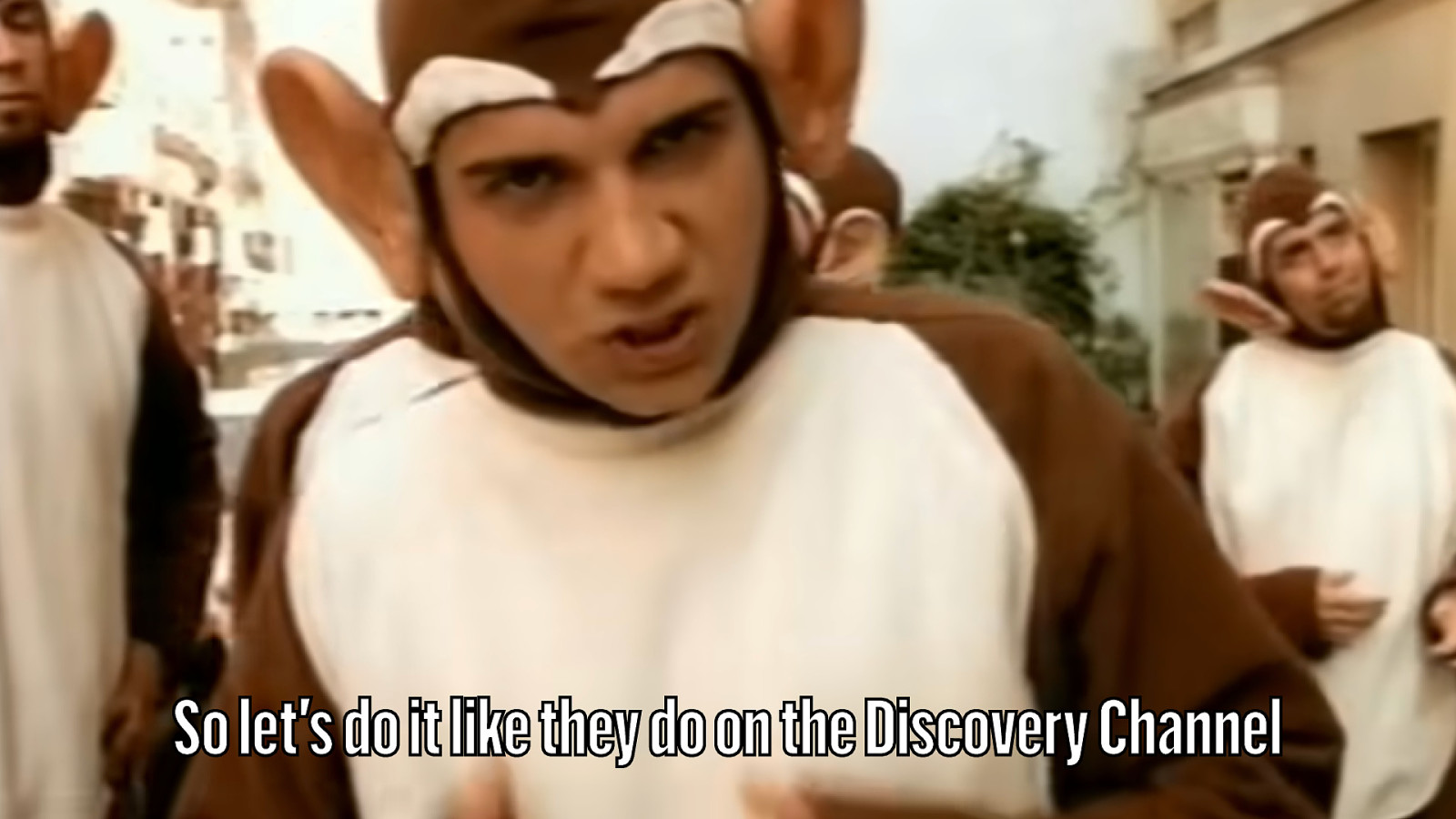
or what it means to do it like they do on the Discovery Channel… Don’t even think we had the Disovery Channel back home.
So, just the tune was what did it for me.
Slide 63

Now there are various things that determine if you like this art, if it resonates with you.
You could appreciate it differently because you had specific personal experiences, knowledge of context in history, knowledge of artist, read descriptions, or certain prerequisites (like language, in my case).
Slide 64

Appreciation is basically a continuum… and it’s not actually linear like I show here.
Your appreciation will change / be different based on if maybe you have no context, you read the biography, went through a similar struggle or are an art historian specialised in this specific genre. It’s all possible, and none of it right or wrong, of course.
That, again, makes art fuzzy.
Slide 65

Art can also be repeated.
Slide 66

You could have a children’s book that is turned into a film, a remake of the film, a musical and a remake of the musical. It’s the same art, yet different at the same time. That duality is so interesting about art, like, what constitutes the art if it can change so much?
Slide 67
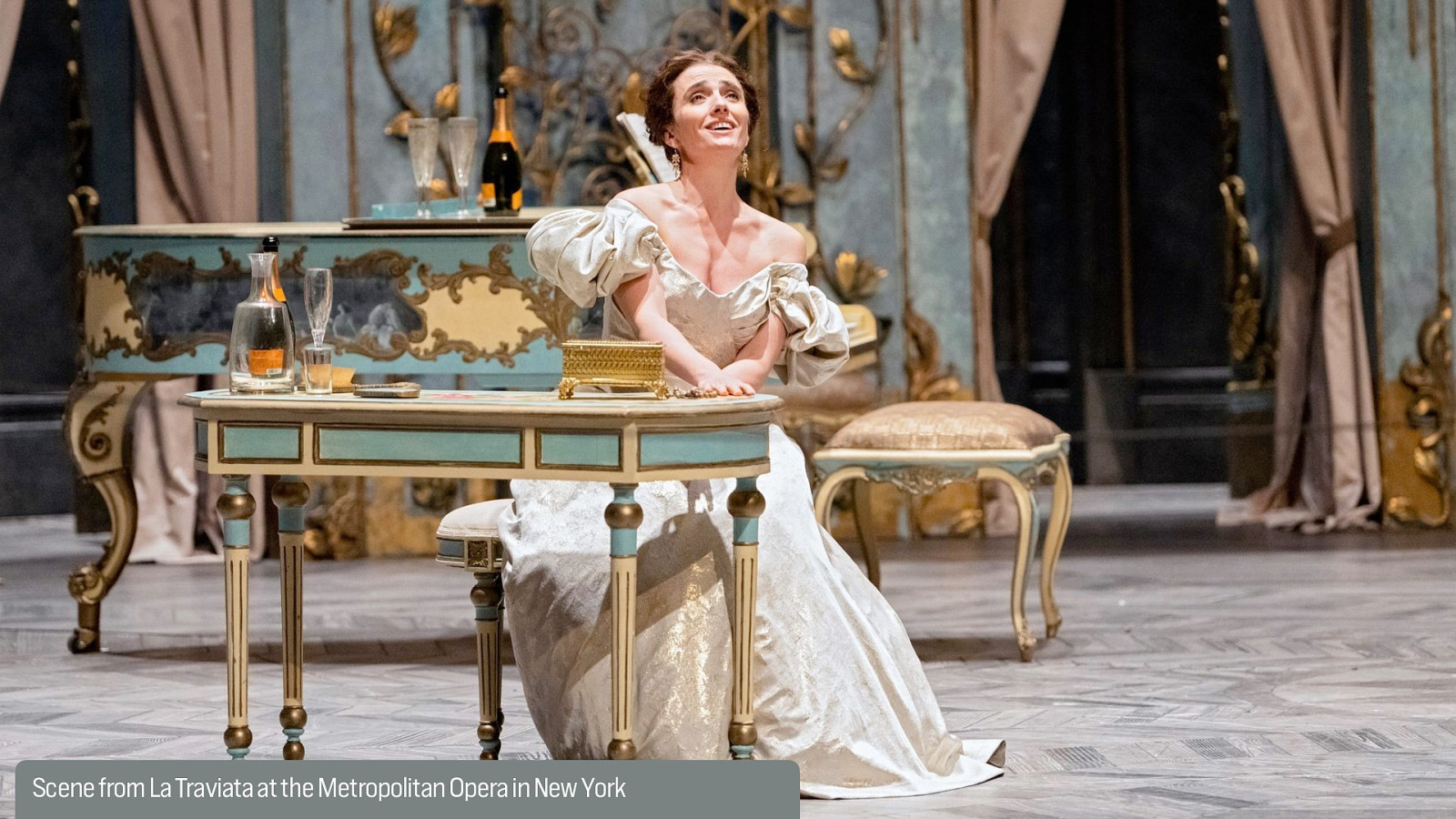
Same thing with operas… they can be performed in different places in the word, by different actors, adopted by different writers, different orchestras, in different times, with different vibes. Yet they are clearly still the same work of art.
Slide 68
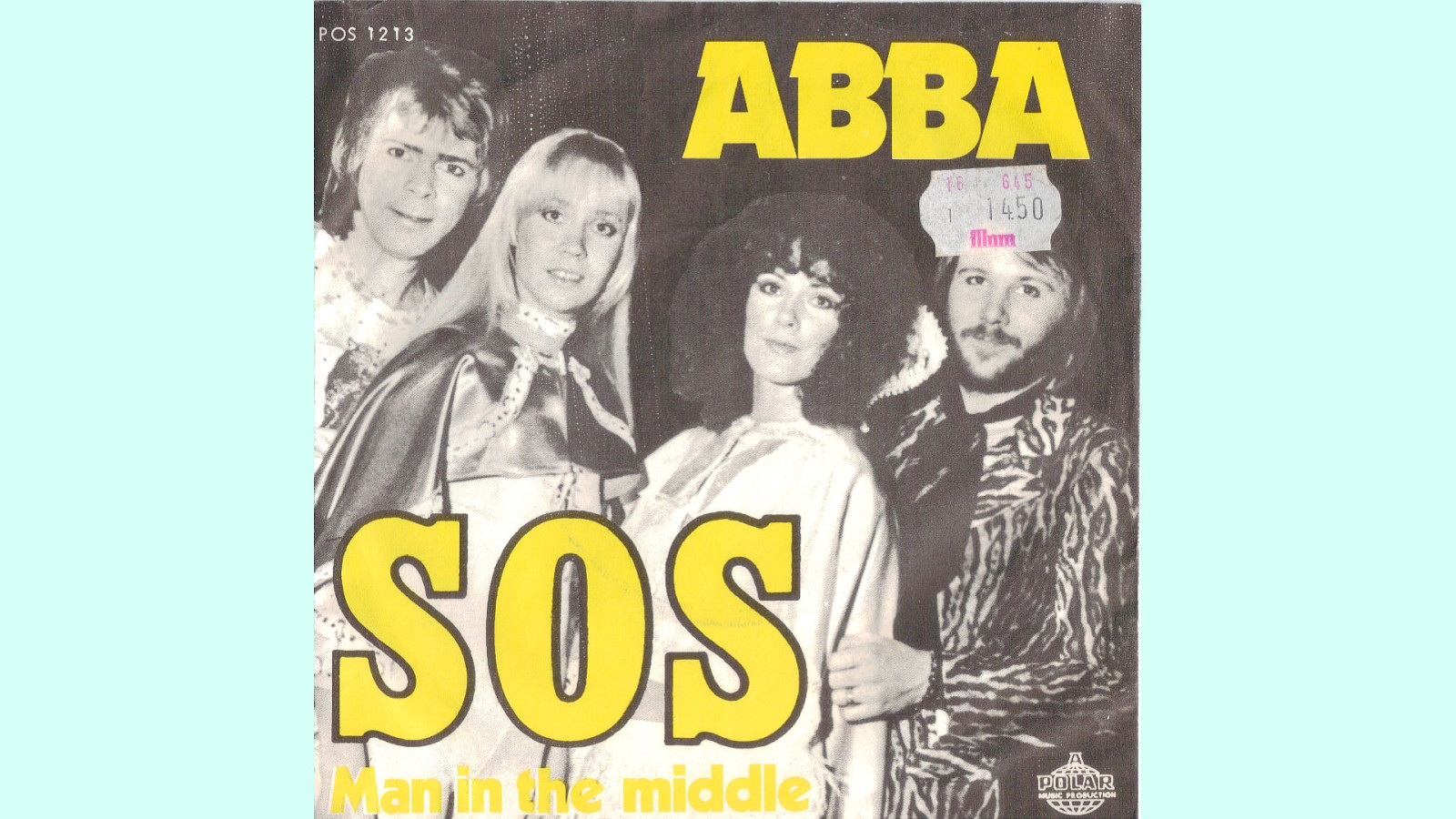
I love it when musicians cover their own music, or that of others. You’re probably all familiar with ABBA’s hit SOS?
Slide 69

Portishead did a version of this for the film High Rise, and it is the same song, but vibes are so different: it’s dark, grim, unsettling… matching the film’s narrative, about class difference in degrading society.
Slide 70

Art gets repeated in many ways. Paintings can be painted again, by others.
Slide 71

My daughter goes to this art class every week where a group of 5 to 8 year olds get shown a painting or childrens’ book, and then they get to make art based on that.
This is David Hockney’s Portrait of an Artist (Pool with two figures), note the reflections in the water, the colours and the guys in swimming clothes.
Slide 72
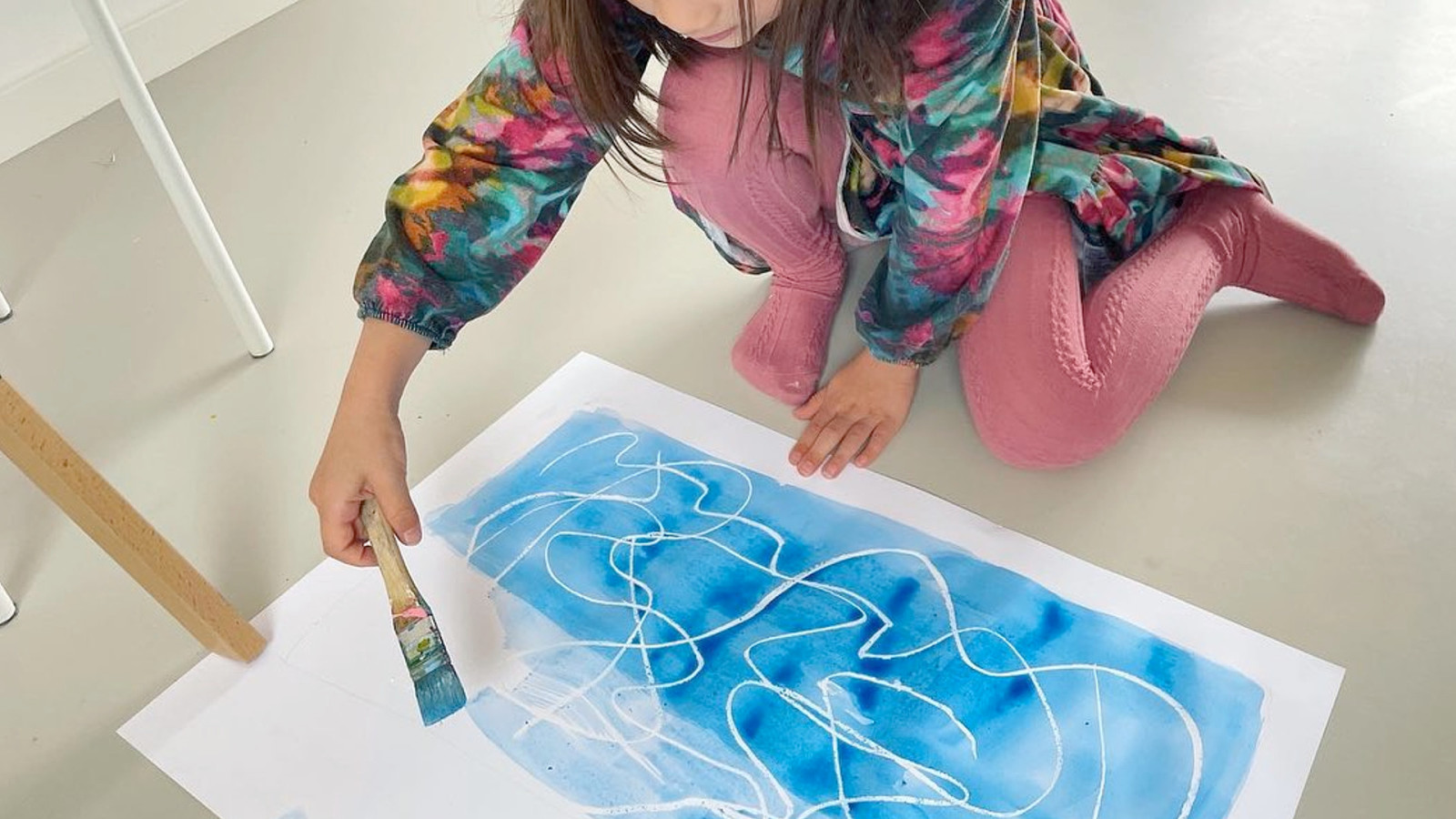
Here’s my daughter making her version of the reflections…
Slide 73

and they recreated the guys…
Slide 74
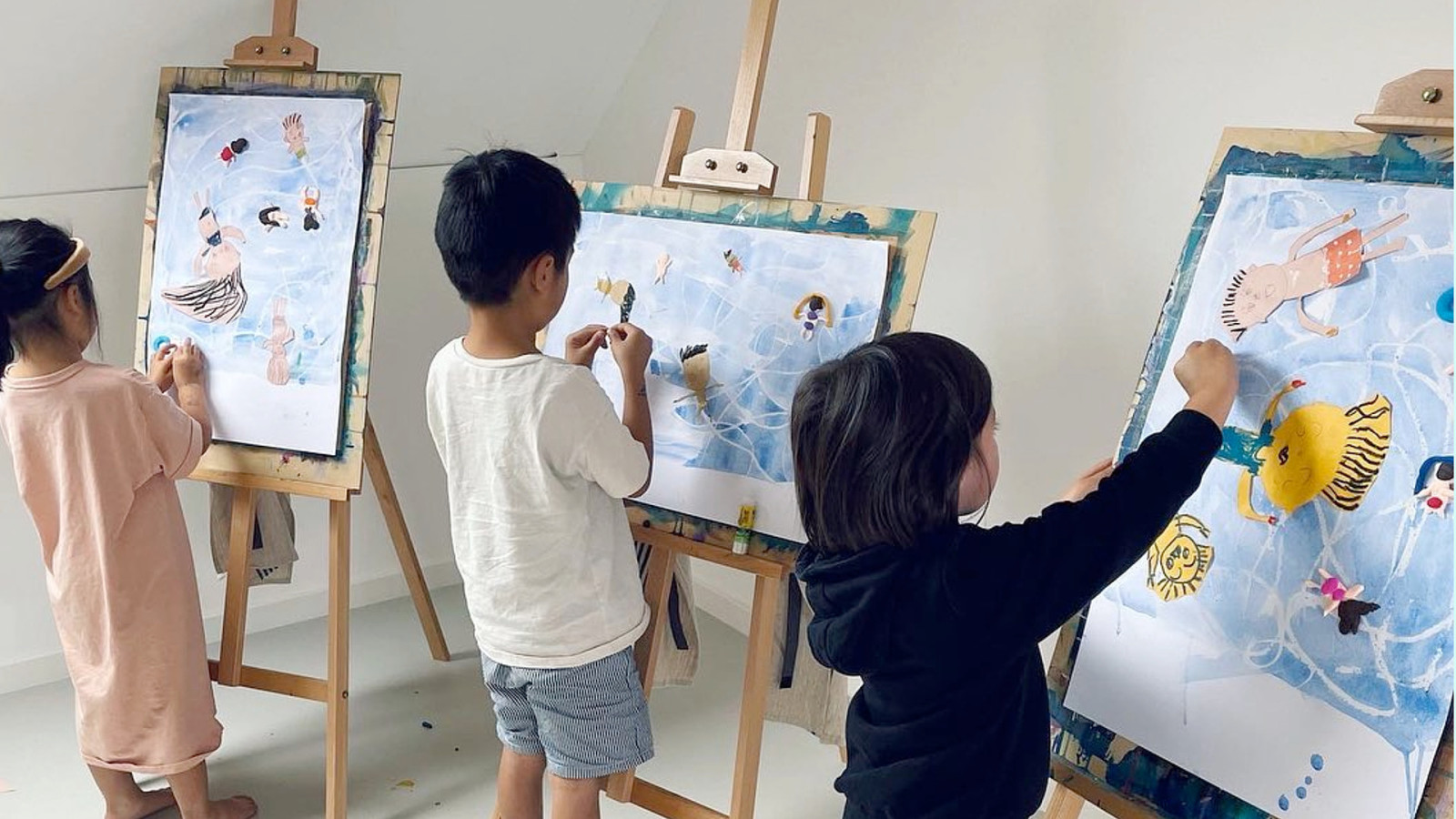
What’s so cool is that with 10 kids, you get 10 very different results, that also have lots of similarities. I don’t know how their teacher does it, but love it. Kids creativity is really something special, as saw in Linda’s talk yesterday too.
Slide 75

One more way that art is repeated… this event!
Slide 76
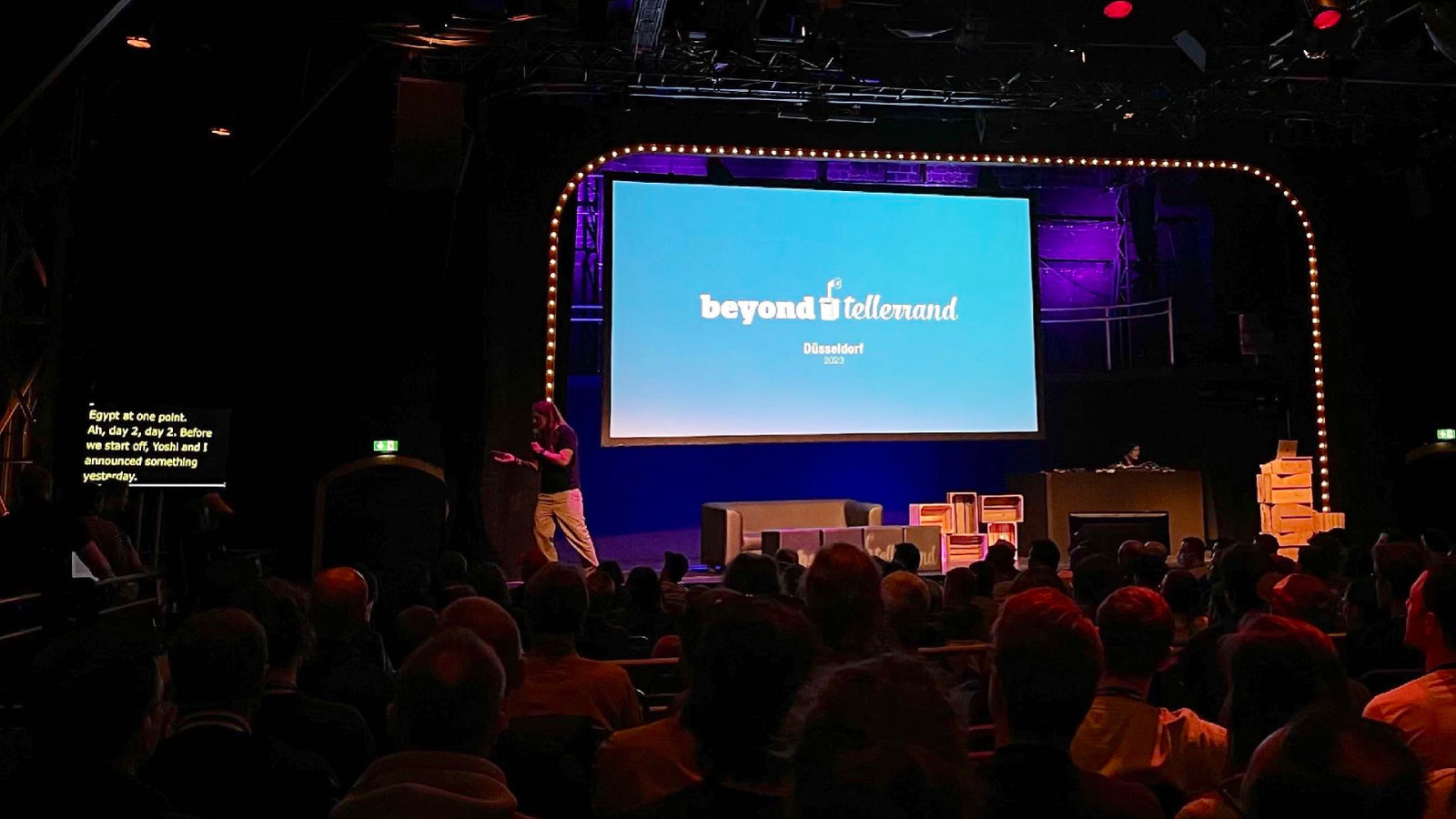
There’s the Düsseldorf version…
Slide 77
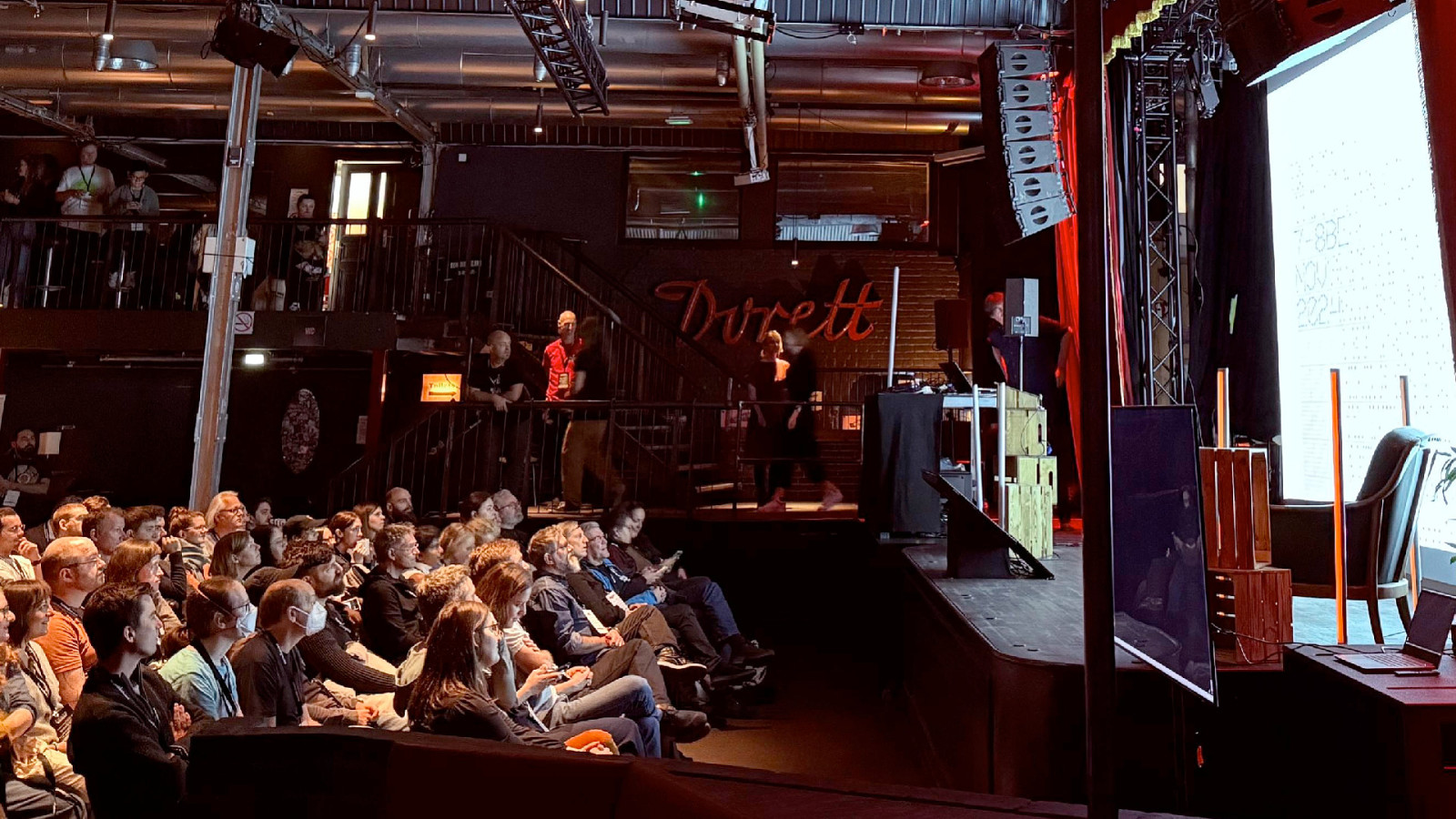
and the Berlin version… same organiser, same DJ, same light set up, so it is recognisably the same, but are also lots of differences.
Slide 78

Another cool thing about art is that it can contain intentions.
Slide 79
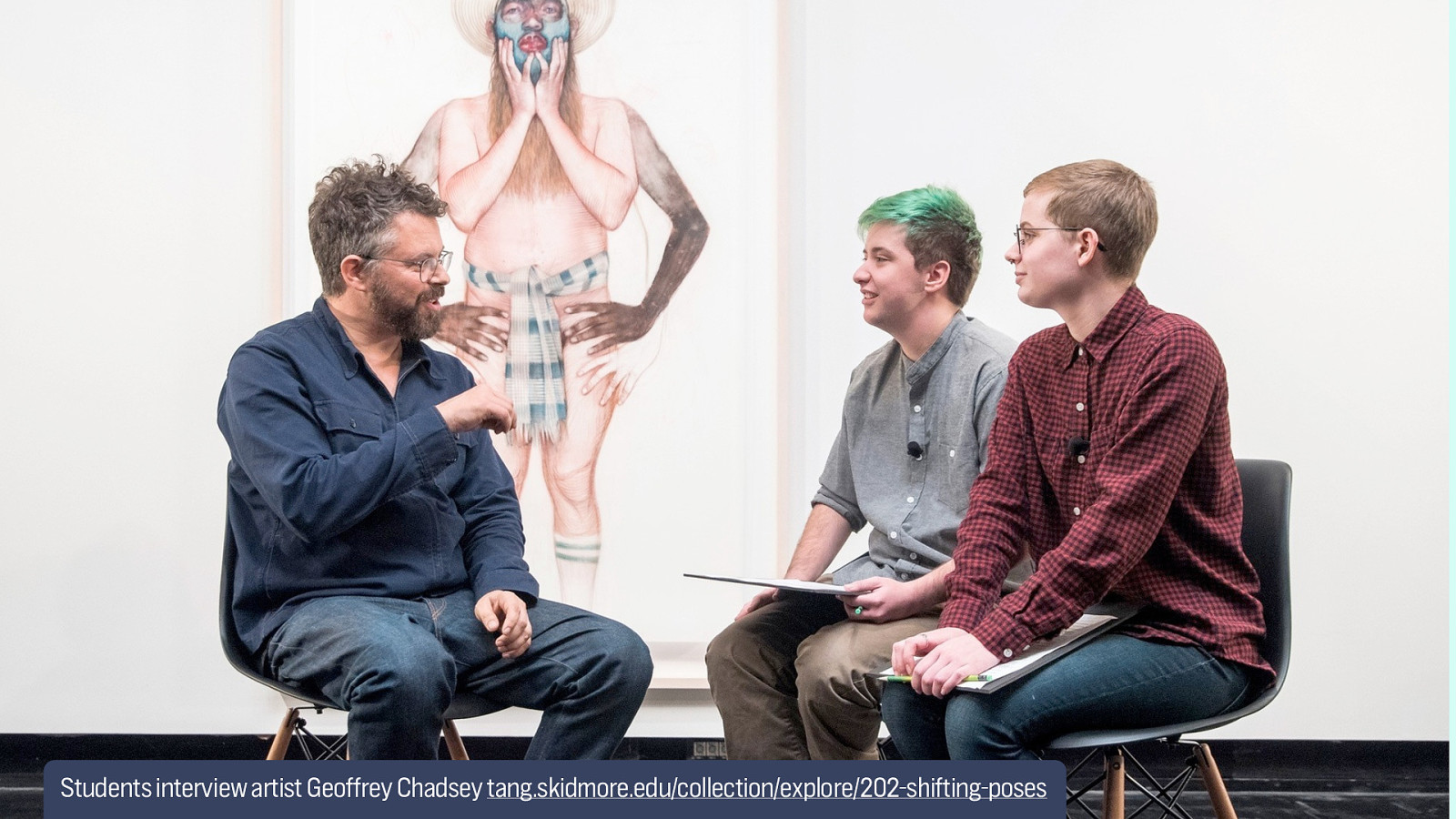
You can usually find out about them reading or listening interviews with artists… I love listening to a podcast where a singer I like talks about what they tried to do, helps me with the appreciation I mentioned earlier, I feel like it’s an opportunity to connect more with the art.
Students interview artist Geoffrey Chadsey tang.skidmore.edu/collection/explore/202-shifting-poses
Slide 80
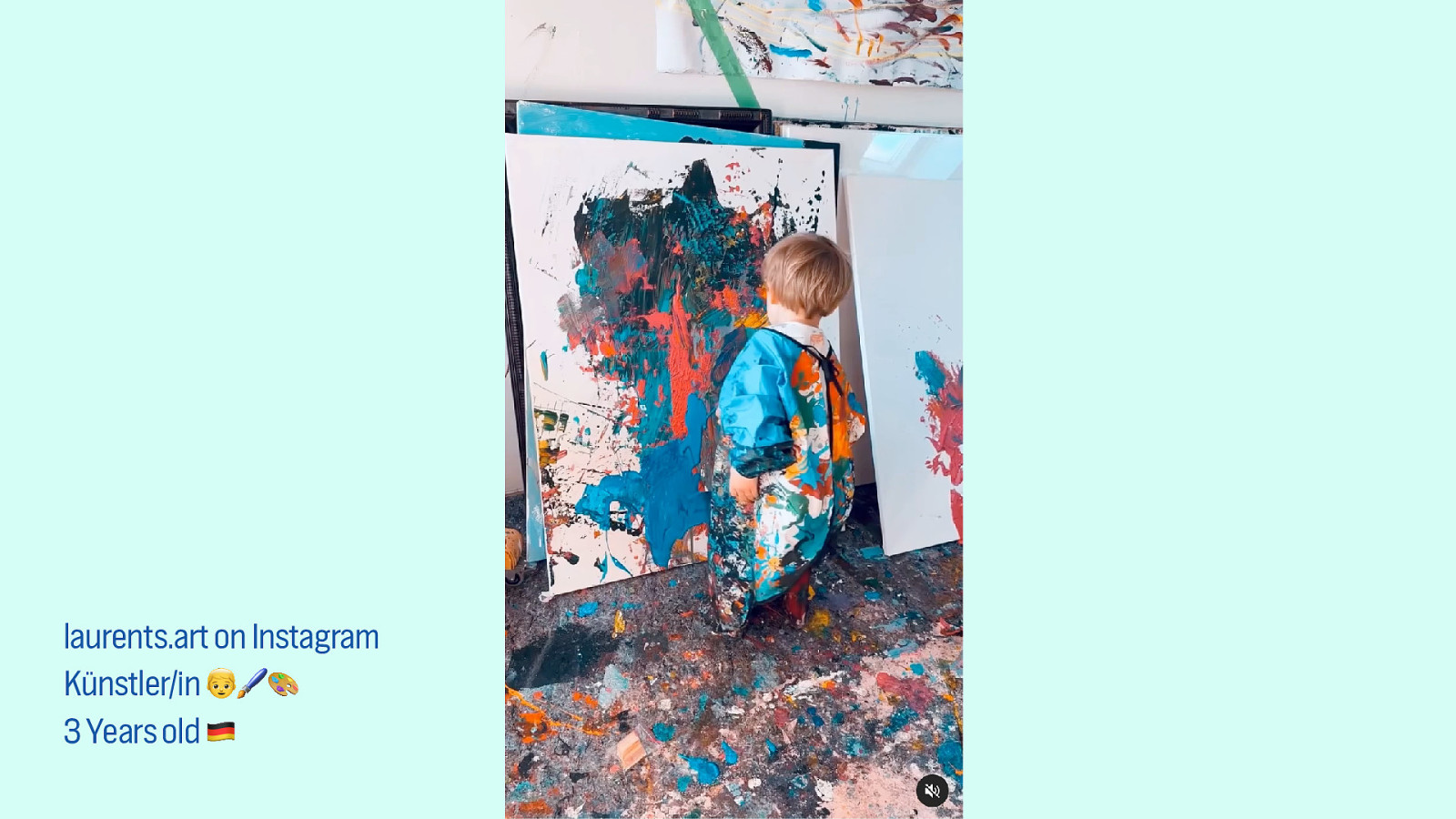
And sometimes there’s less info about intentions… there’s this 3 year old (laurents.art on Instagram) who paints in videos and you can watch his painting and then buy them.
Slide 81
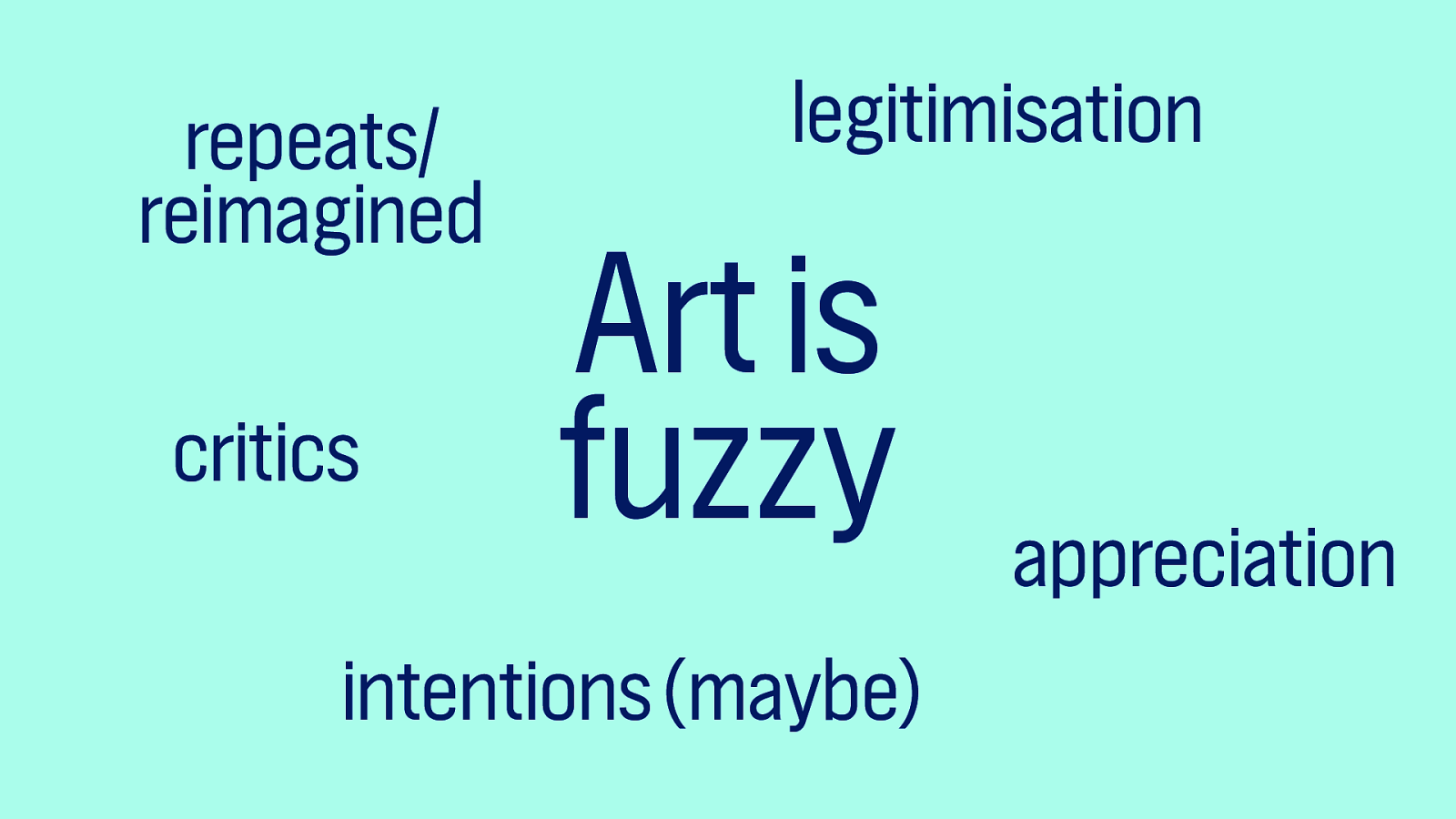
So, in summary, art is somewhat hard to grasp, it’s fuzzy, because it gets legitimised in non-linear ways, people appreciate things differently, there can be repeats that are different and the same, and there could be intentions.
This is one of the reasons I struggle with “computers will make art”: that’s not a sentence that can make sense if it’s so fuzzy what constitutes the art exactly.
Slide 82
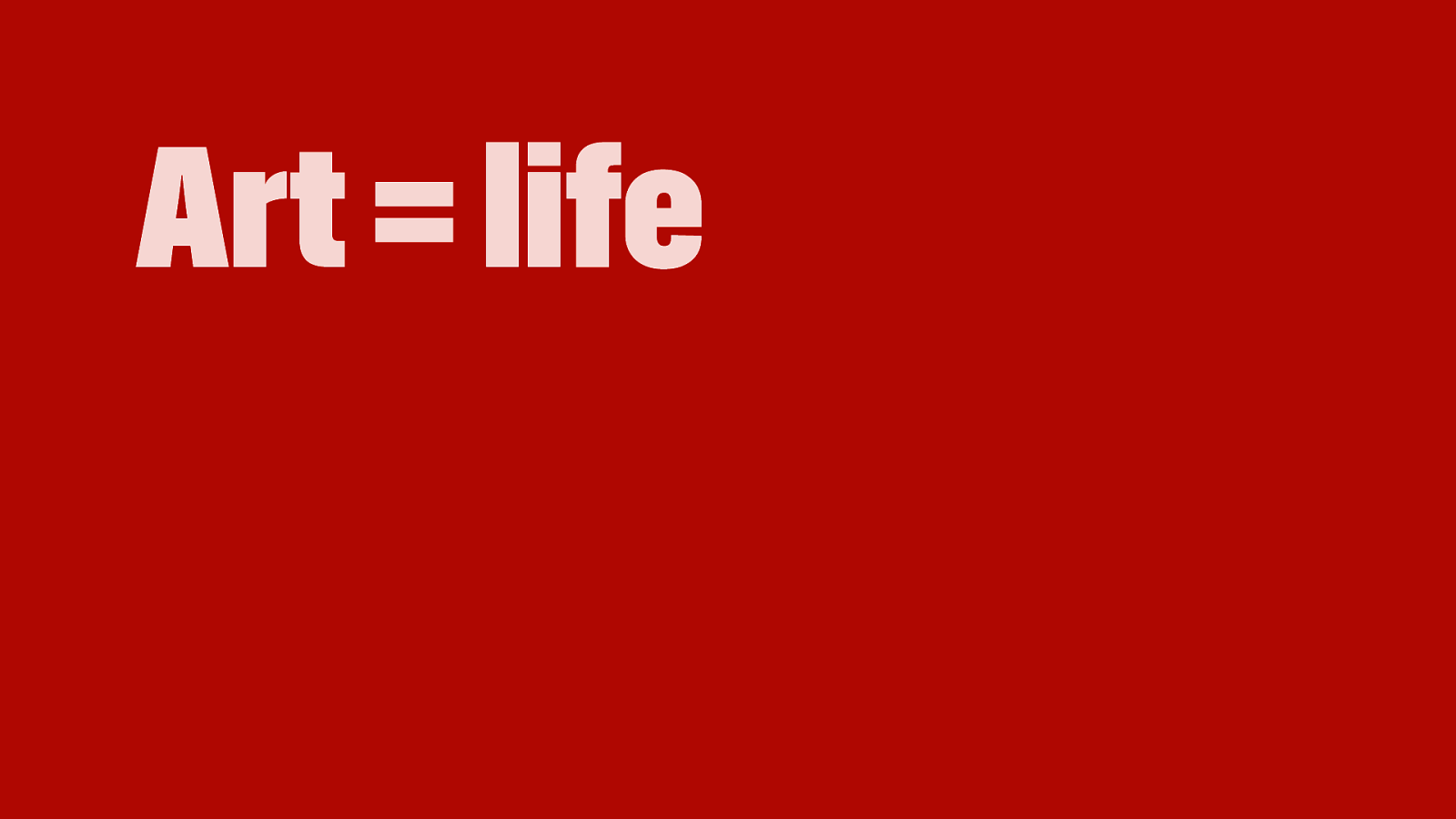
Art = life
But hey, this is what makes art is interesting, and why so many people love to have it in their lives.
Art is life: being alive means being able to feel stuff, and art is for a large part about feelings, whether put into art by artists, or caused in humans when experiencing art.
Art is life, it makes live worthwhile, but also, it does heavy lifting in our lifes and societies that no other thing can do. Including computers.
Slide 83
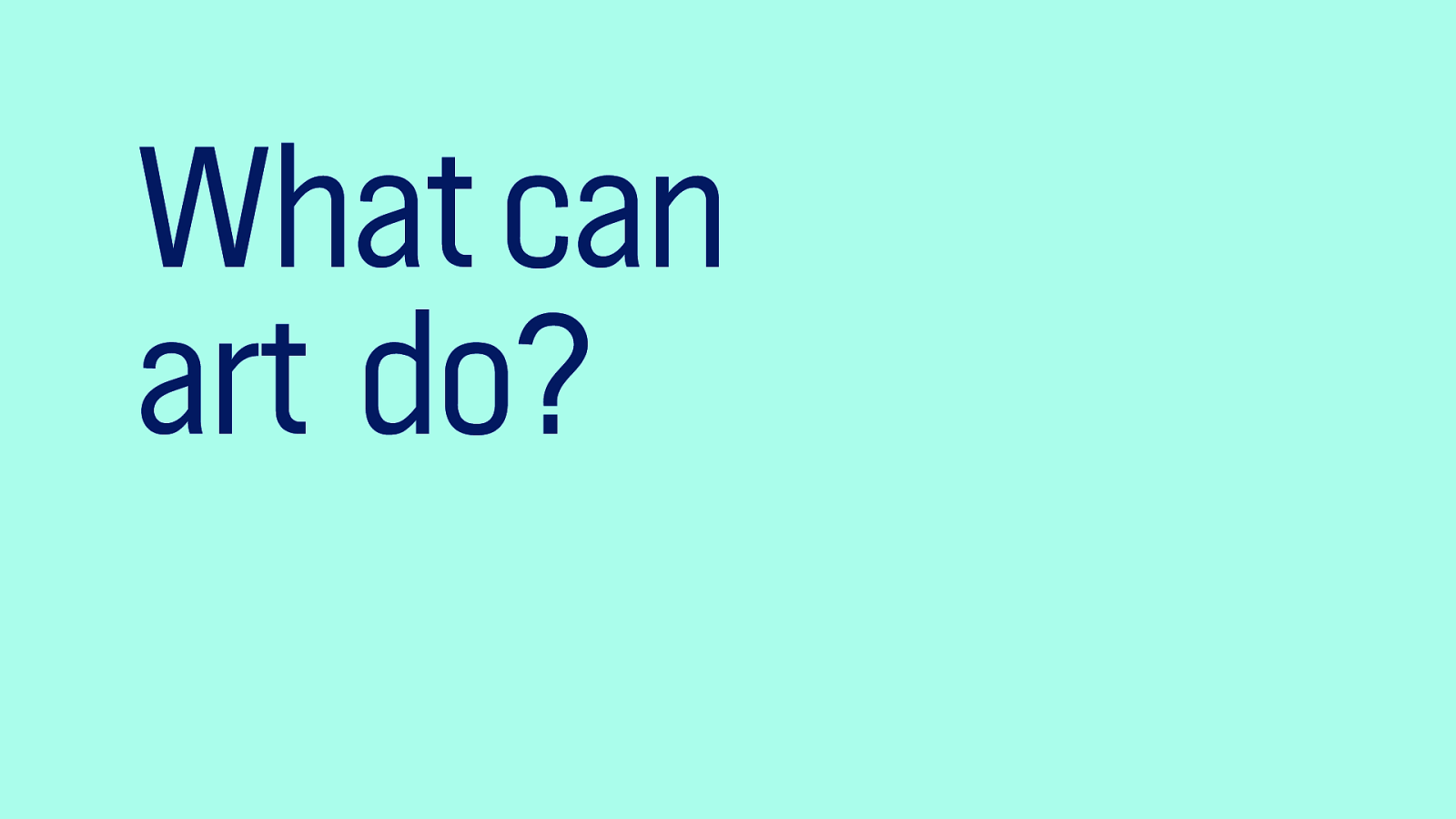
Let’s look at what art can do.
Slide 84
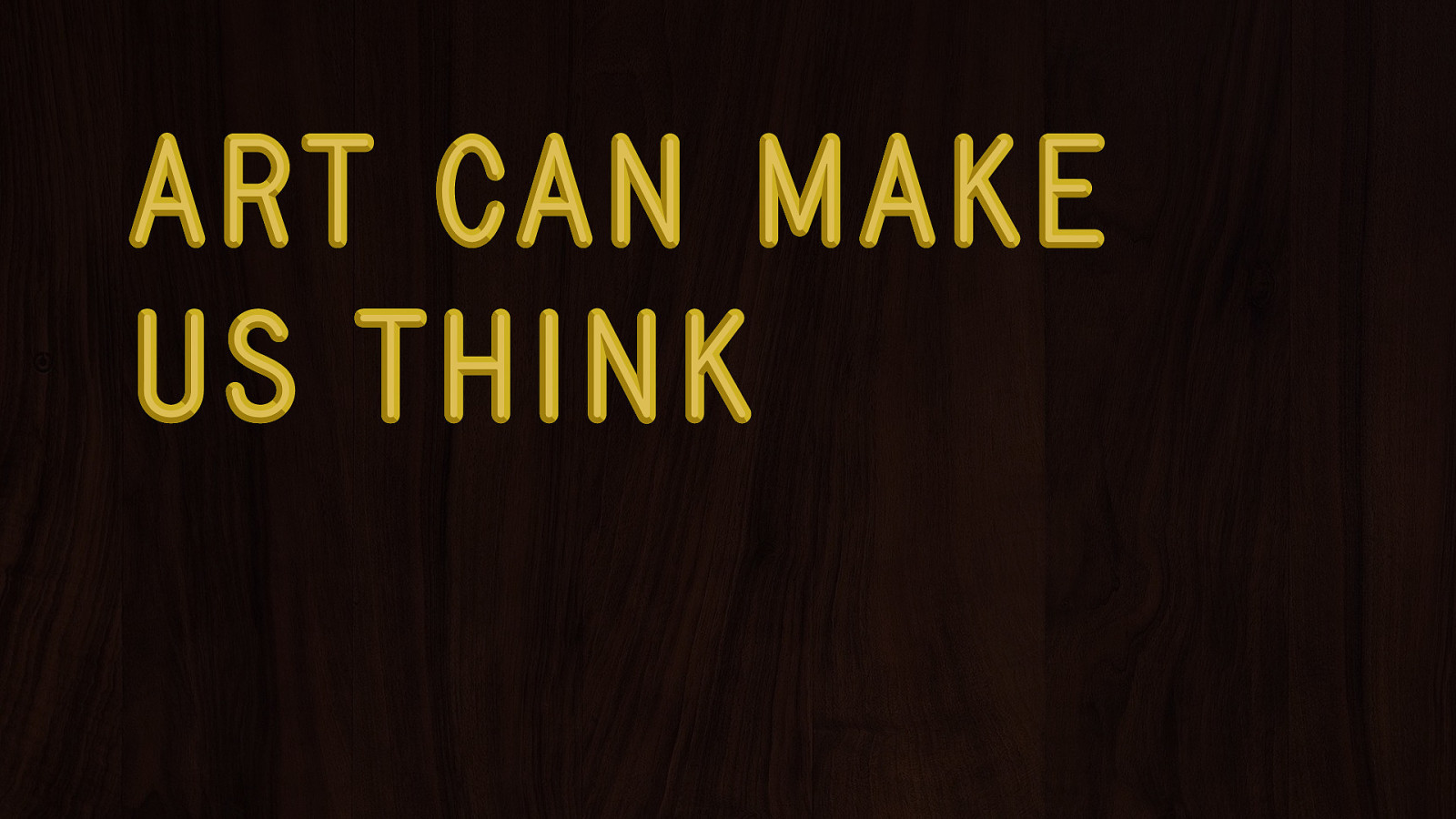
Art can make us think
Firstly, it can make us think
Slide 85

It can make the artist think.
Slide 86
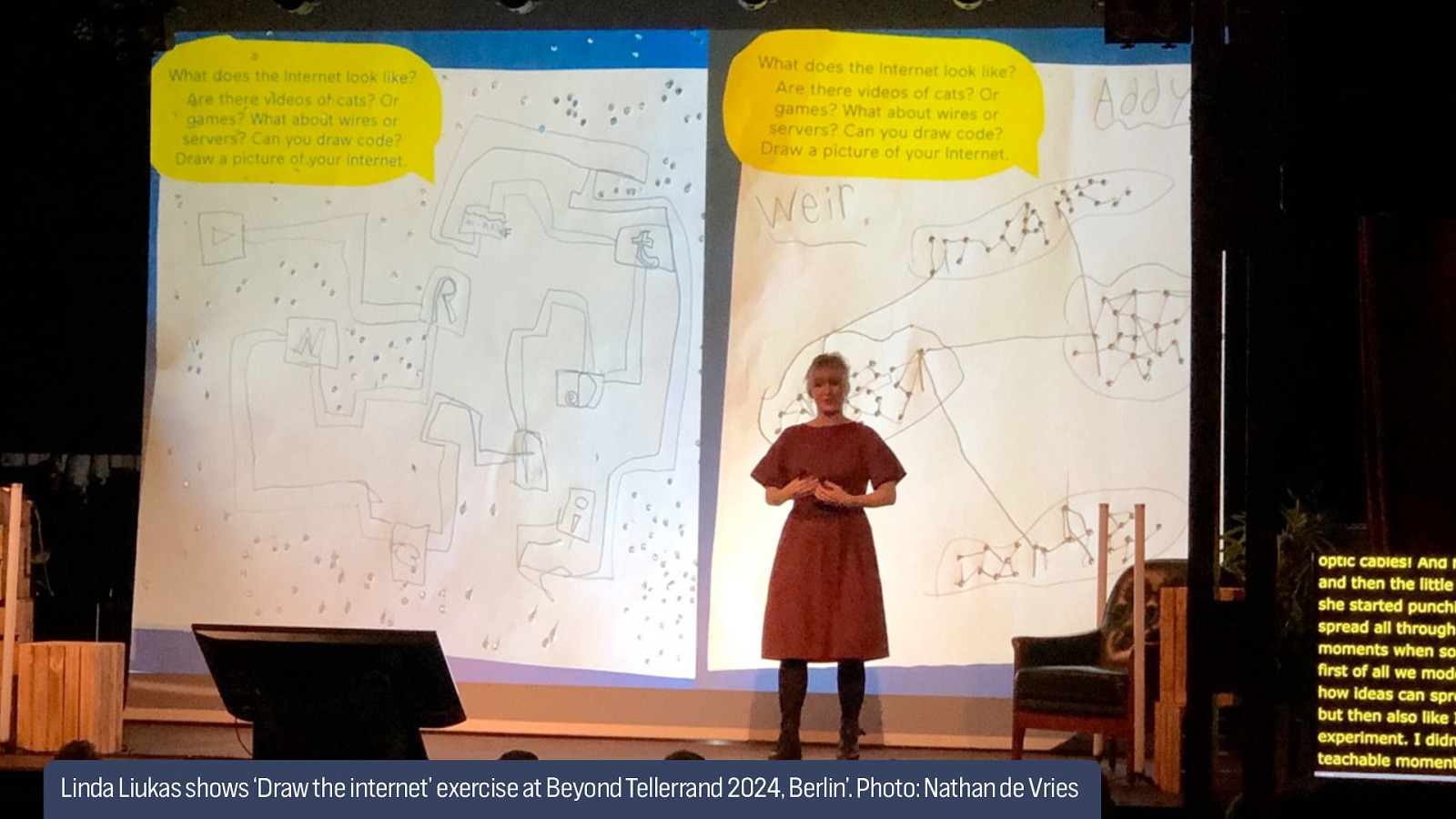
Like Linda explained yesterday: she gave kids the assignment to draw the internet and it unleashed all sorts of thinking in them.
(Linda Liukas shows ‘Draw the internet’ exercise at Beyond ellerrand 2024, Berlin’. Photo: Nathan de Vries)
Slide 87
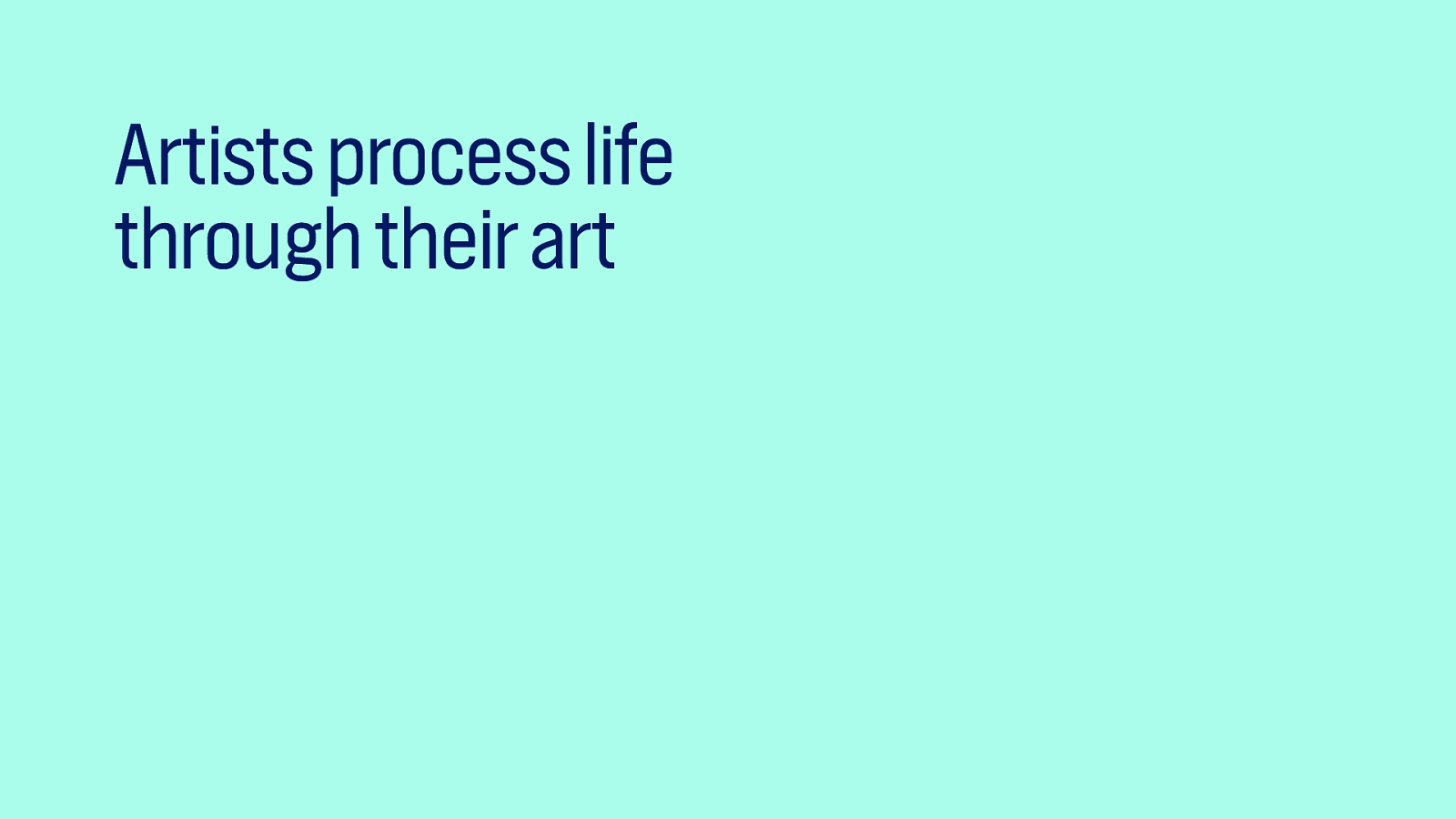
Artists also process life through their art.
Like if they don’t like certain types of sports…
Slide 88
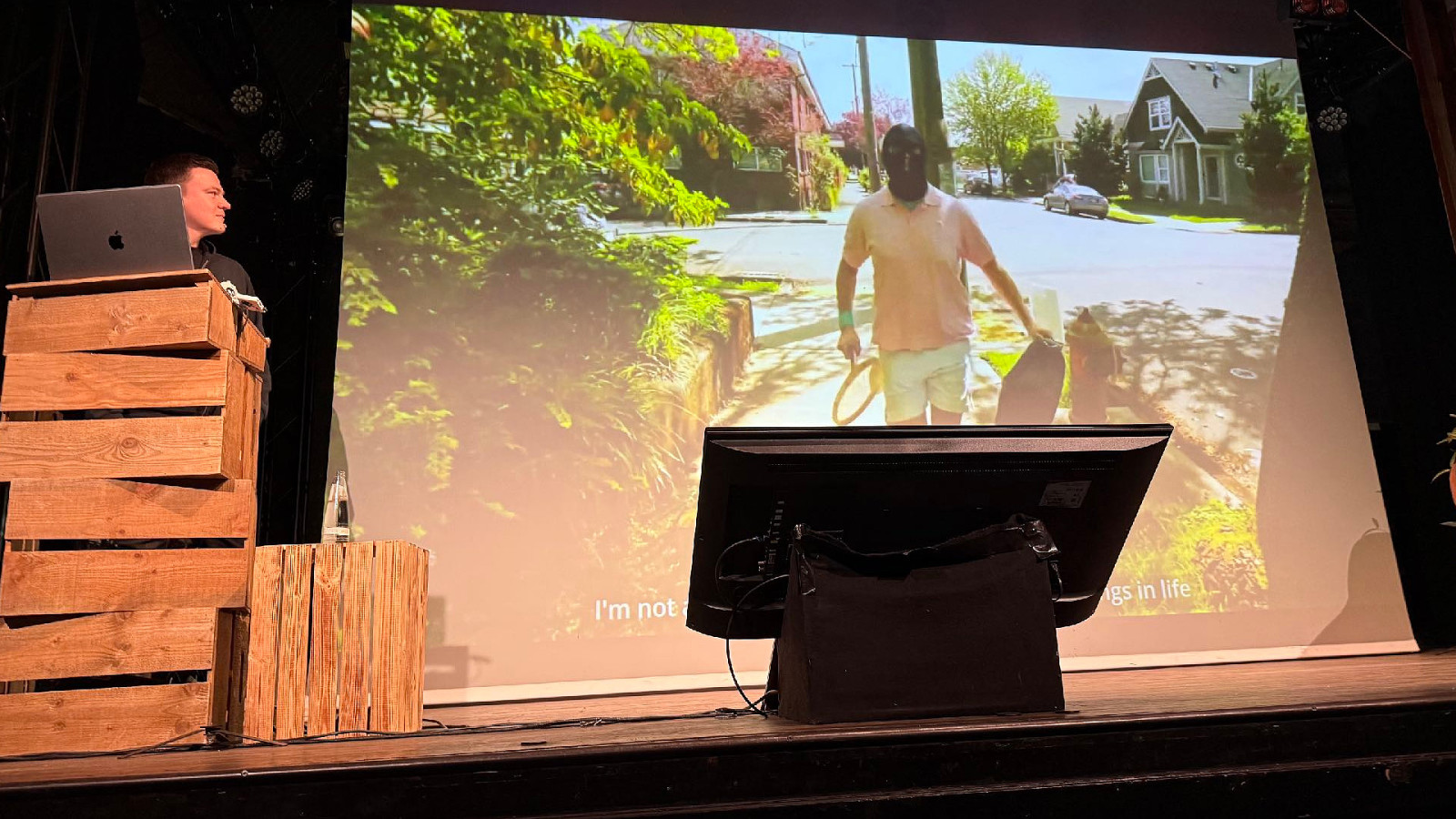
they can do a song about that, like the Eradicators did with I’m a squash man. (Thanks Manuel, great opening video you did this morning!)
Slide 89
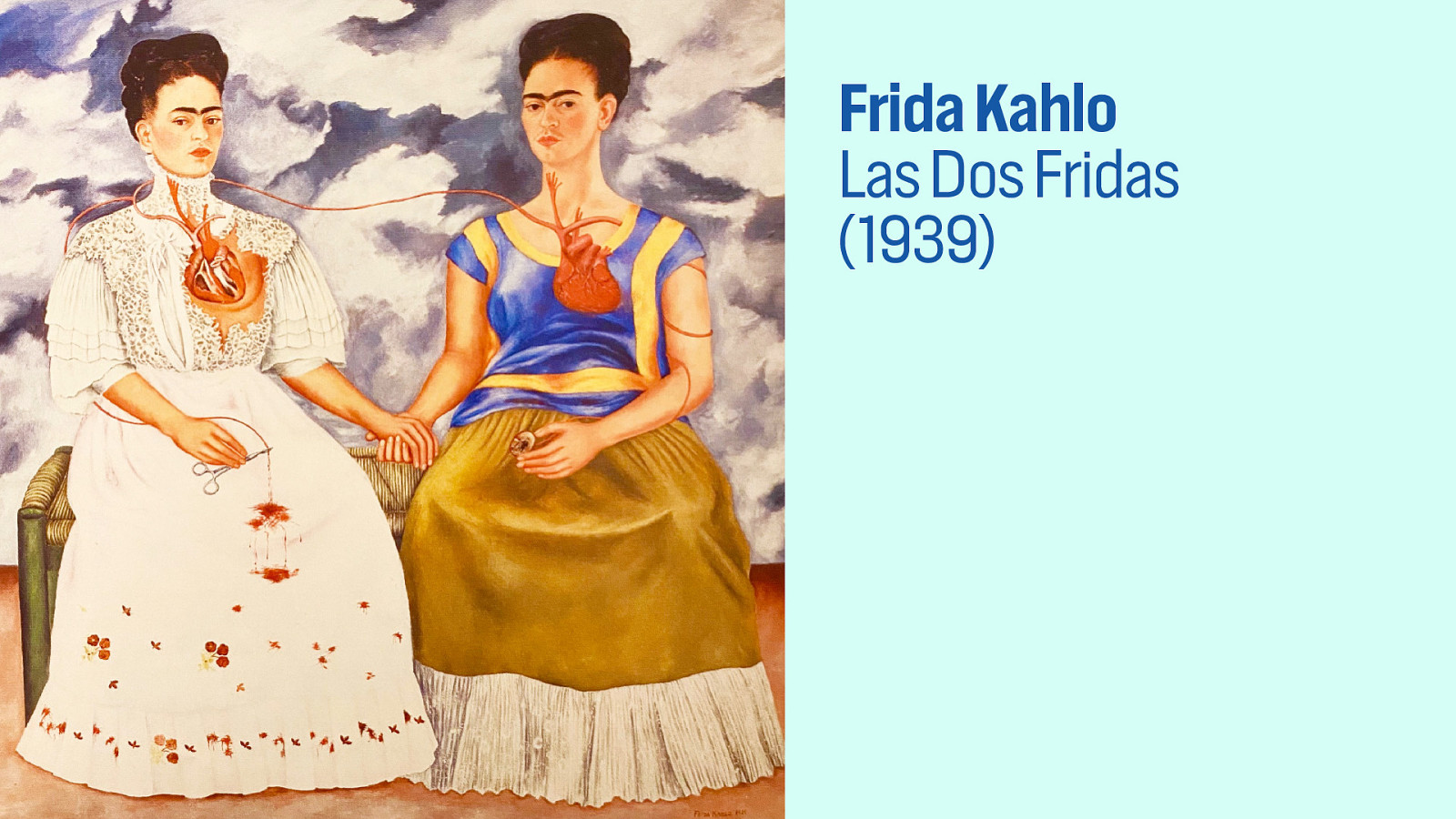
Or, in more serious art… Frida Kahlo had a German father and Mexican mother, and made this work in the year just divorced. Interpretations say the work could refer to her struggle with her double heritage and/or her ex husband look at that.
Slide 90
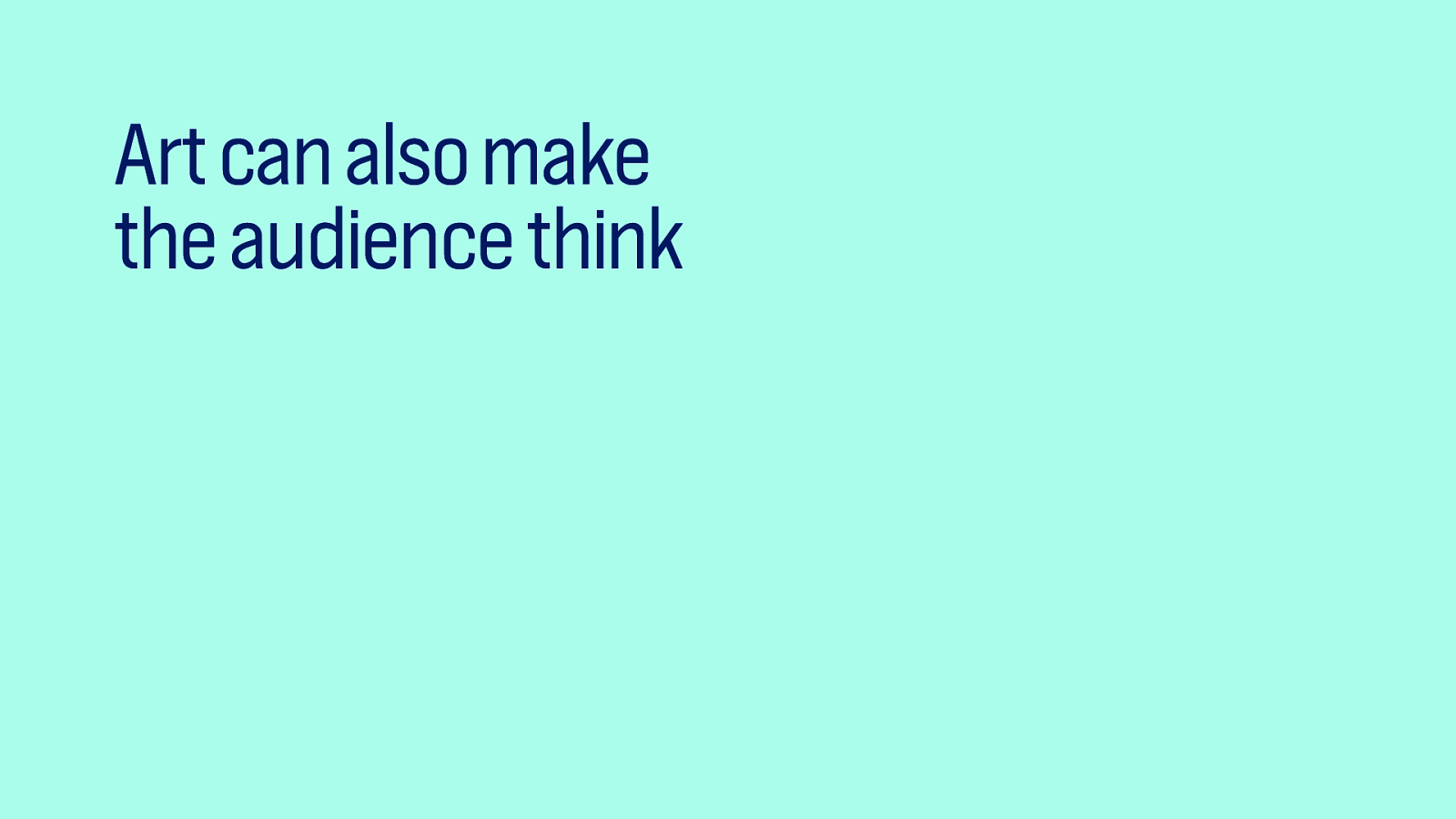
Art can also make the audience think.
Slide 91
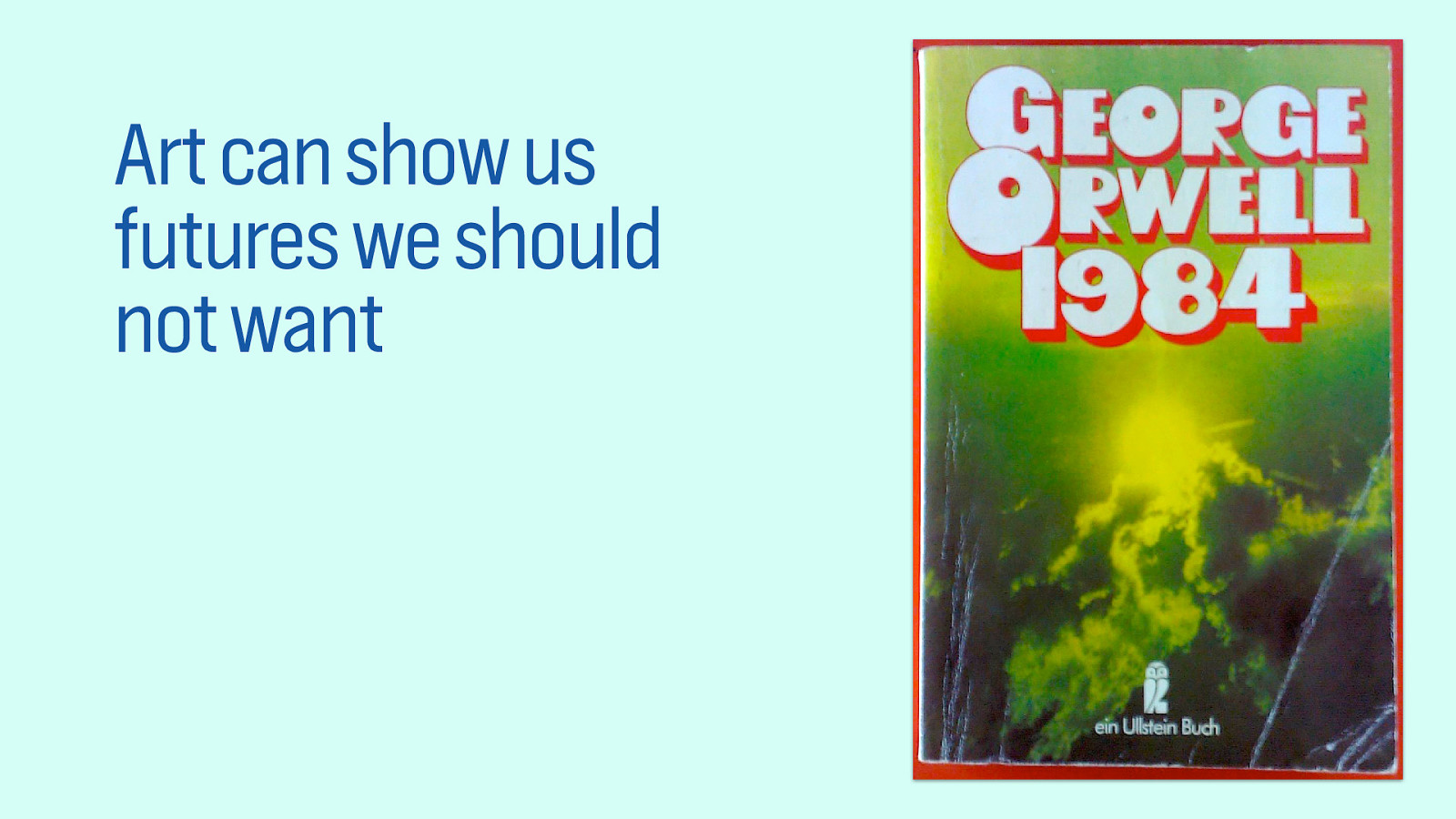
It can show us futures we should not want, like Orwell’s 1984 did. Though some will interpret it as a manual.
Slide 92
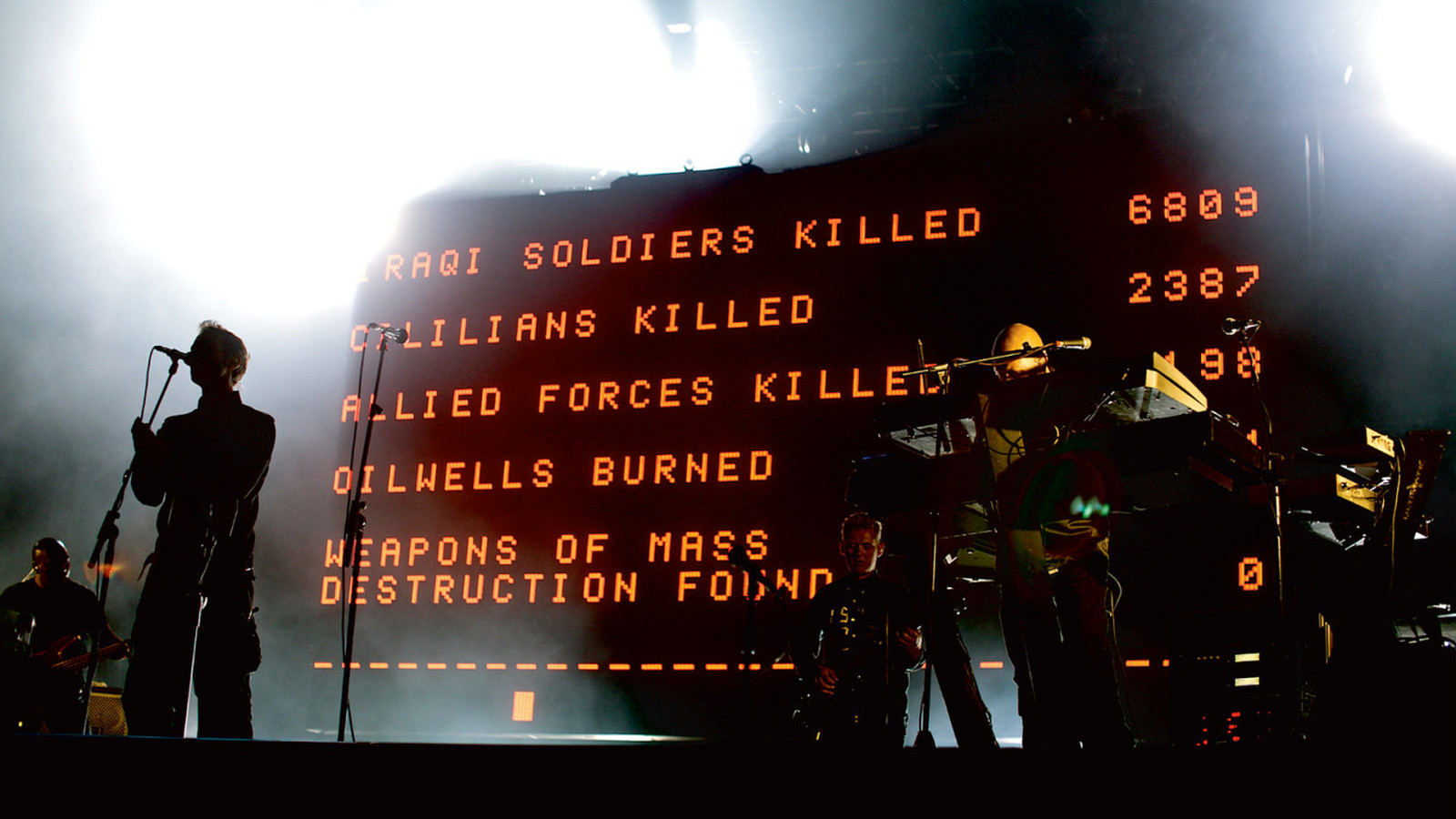
Art can also show us what’s wrong in reality: the band Massive Attack like to show stats on the screens behind them while they play, confronting the audience with information about how much governments spend on wars and how many civilians died in Gaza.
Slide 93
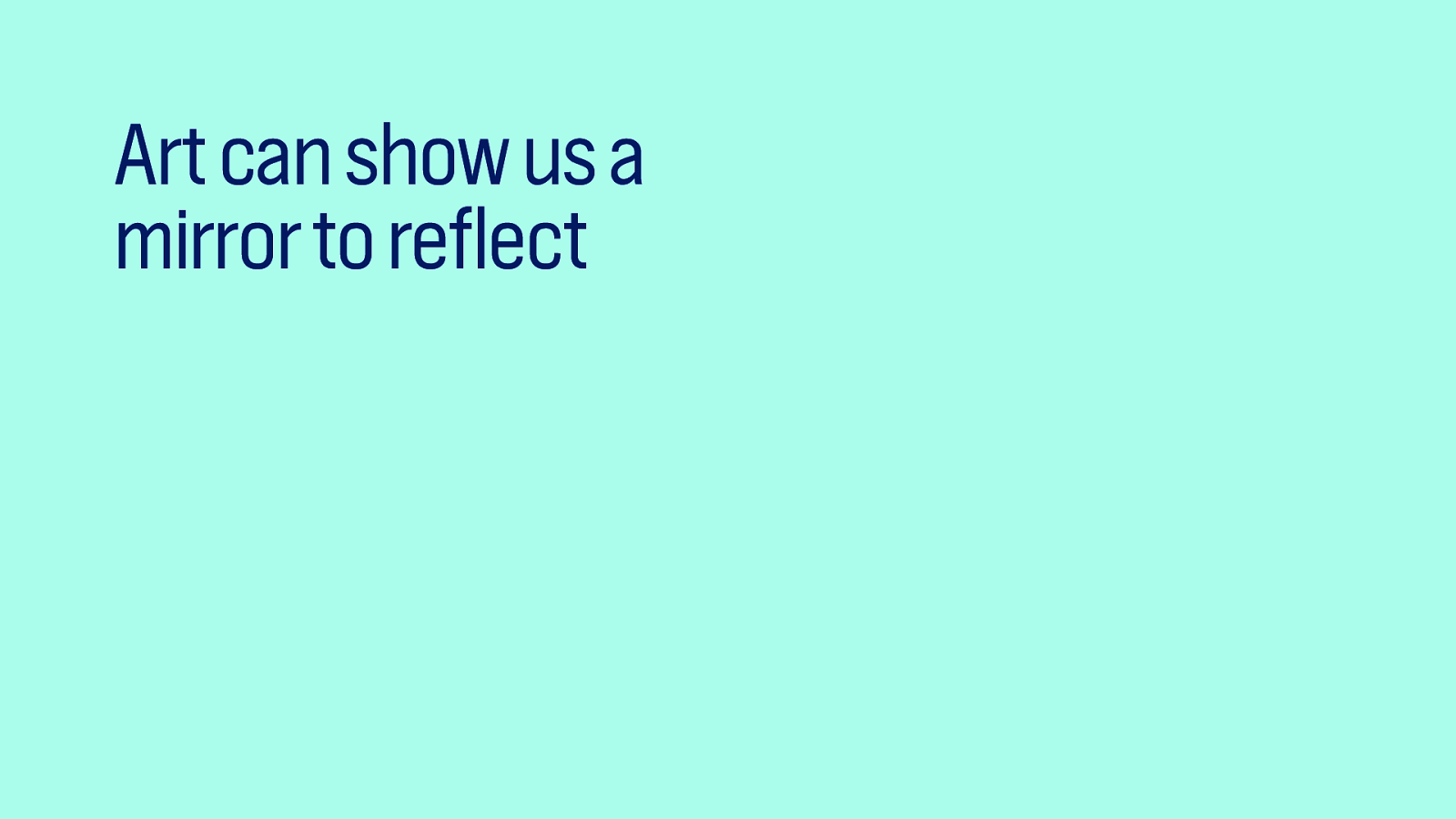
Art can show us a mirror to reflect, too.
Slide 94
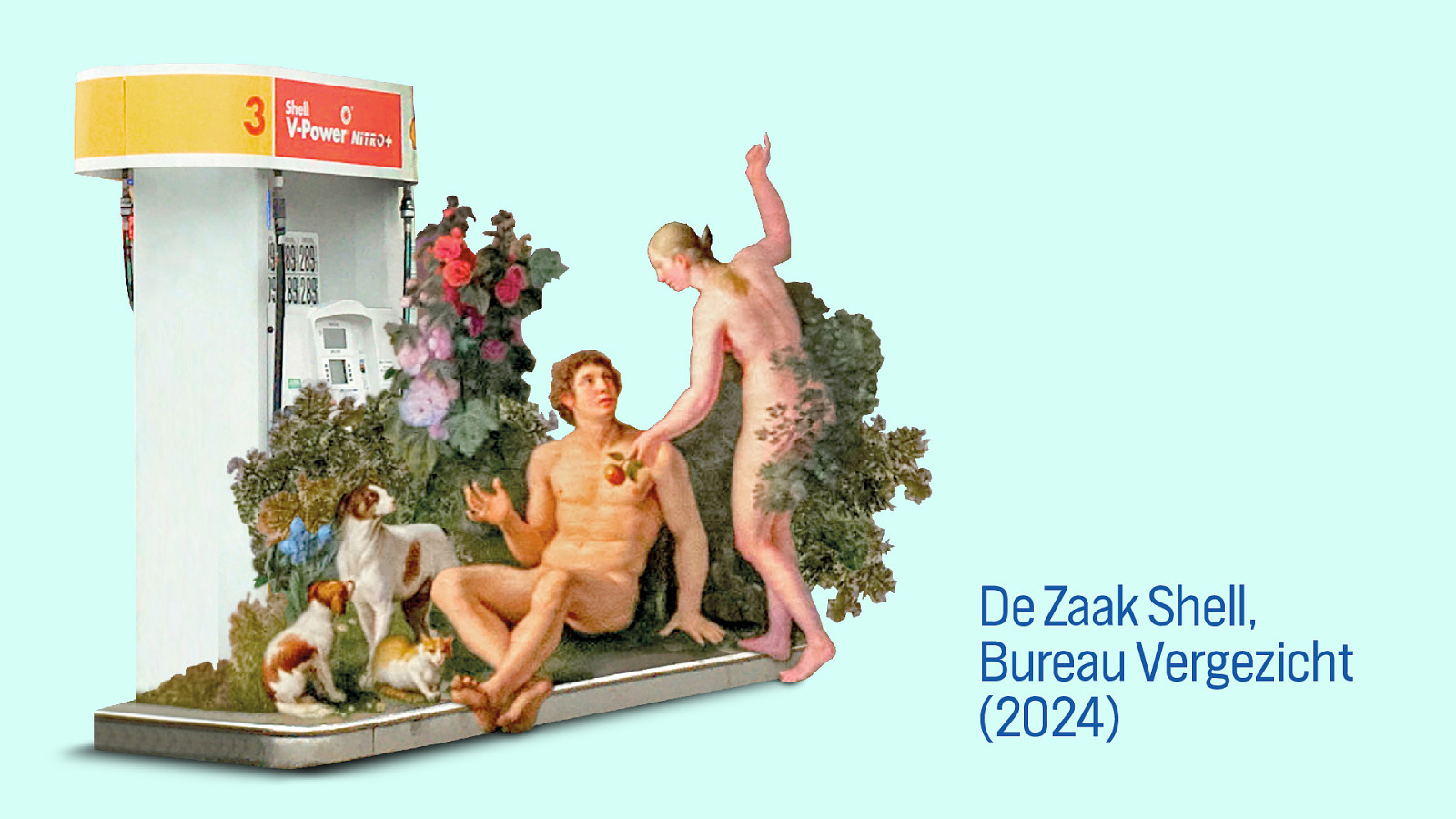
A Dutch play about the case of climate activists against the oil company Shell (by Bureau Vergezicht (2024)) contains 5 monologues, each from a specific perspective in this case: from the CEO of Shell to activists.
Watching this play, like so many plays, can help anyone understand perspectives different from their own.
Slide 95
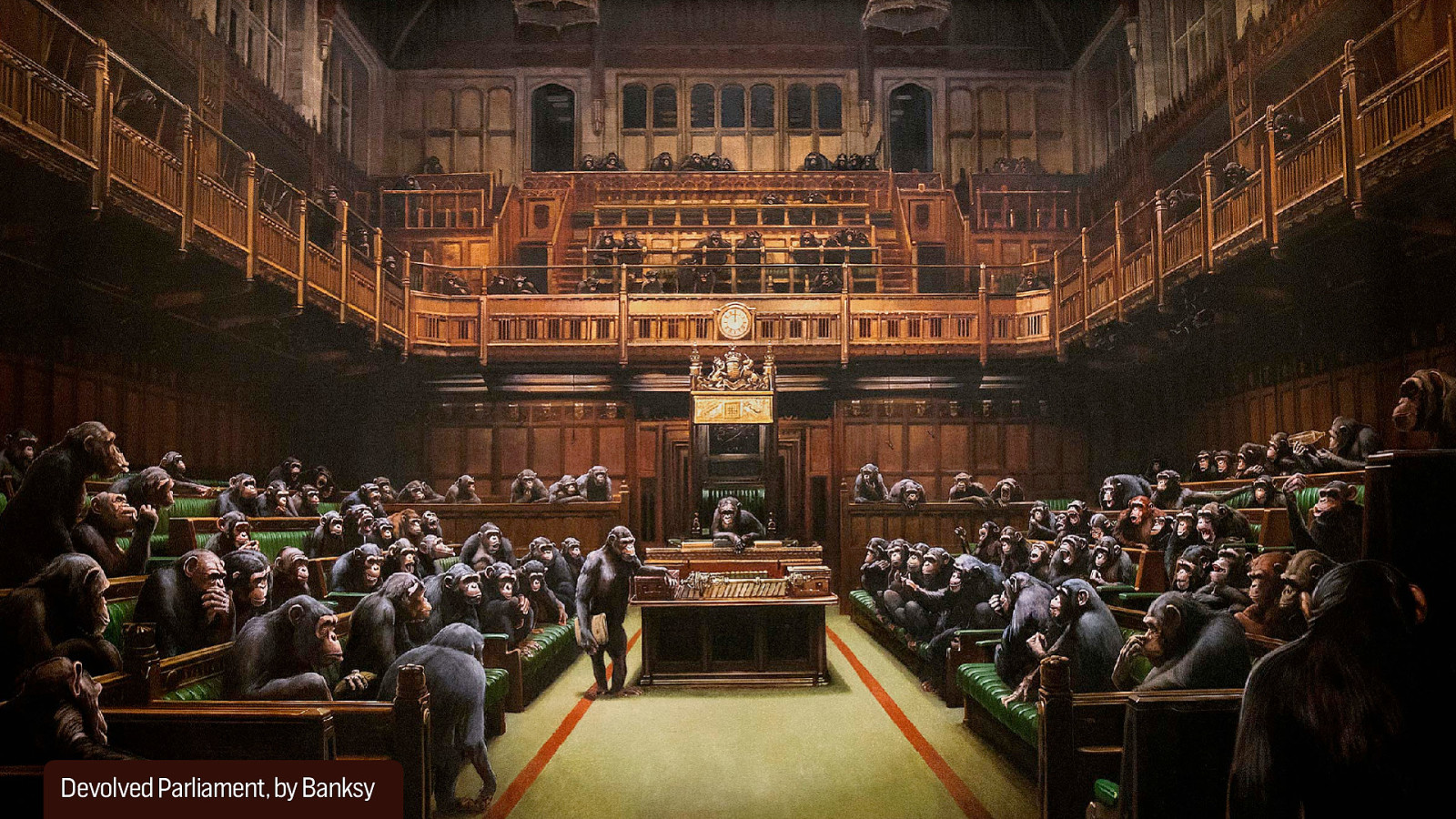
In Bristol, you can find an enormous painting called Devolved Parliament, by Banksy. It’s a painting of the UK Parliament, but all MPs are replaced by monkeys.
Slide 96
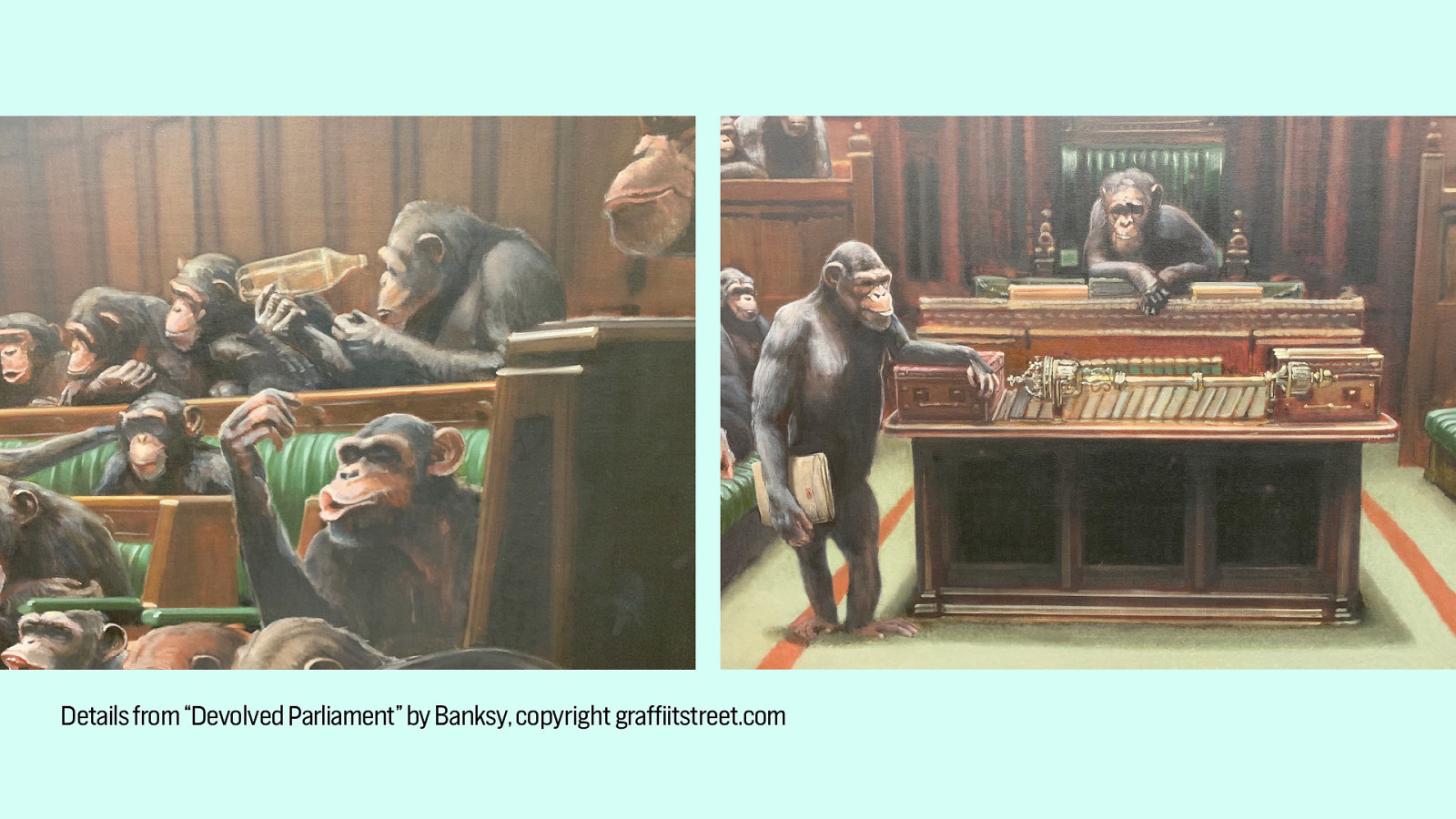
Here are some more details.
Slide 97
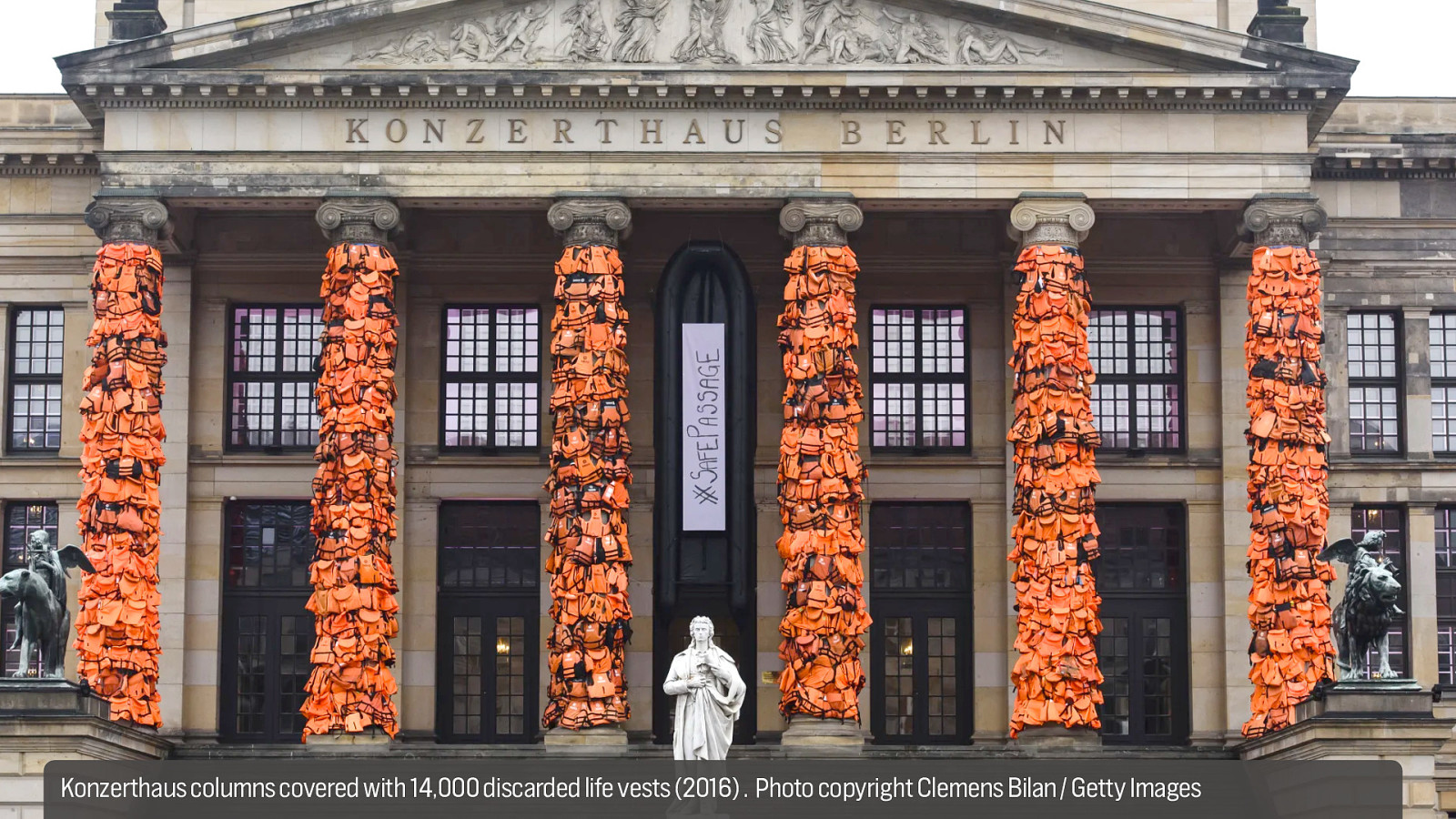
In 2016, Ai Weiwei covered the columns in front of the Berlin Konzerthaus with 14,000 life vests, that he had been given by the authorities in Lesbos, Greek. They had been used by refugees trying to get into Europe via the sea.
This kind of art gives us, voters in democracies that have border policies, an idea of the scale and impact of such policies.
Photo copyright Clemens Bilan / Getty Images
Slide 98
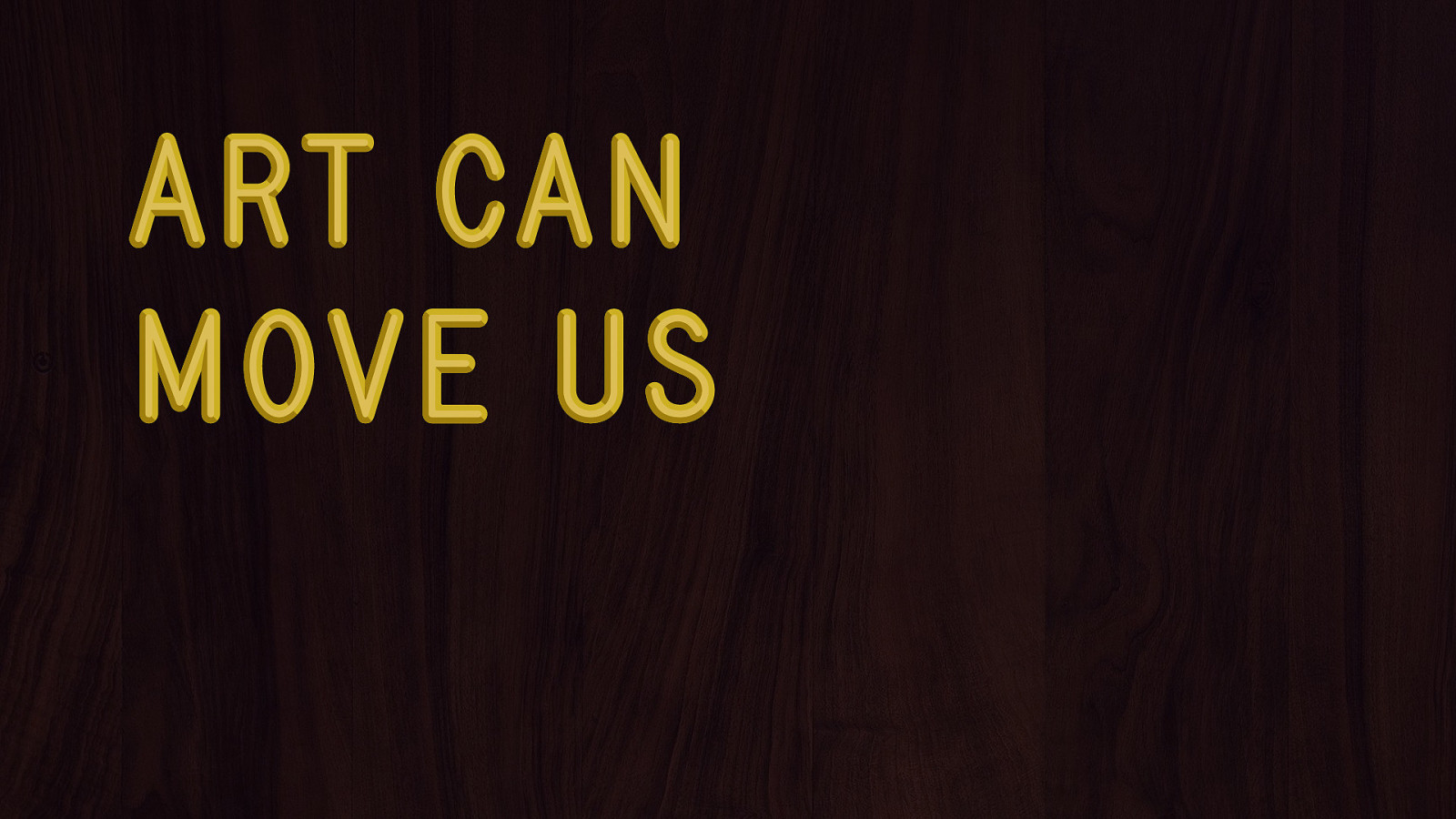
Art can move us
Art can also move us.
Slide 99
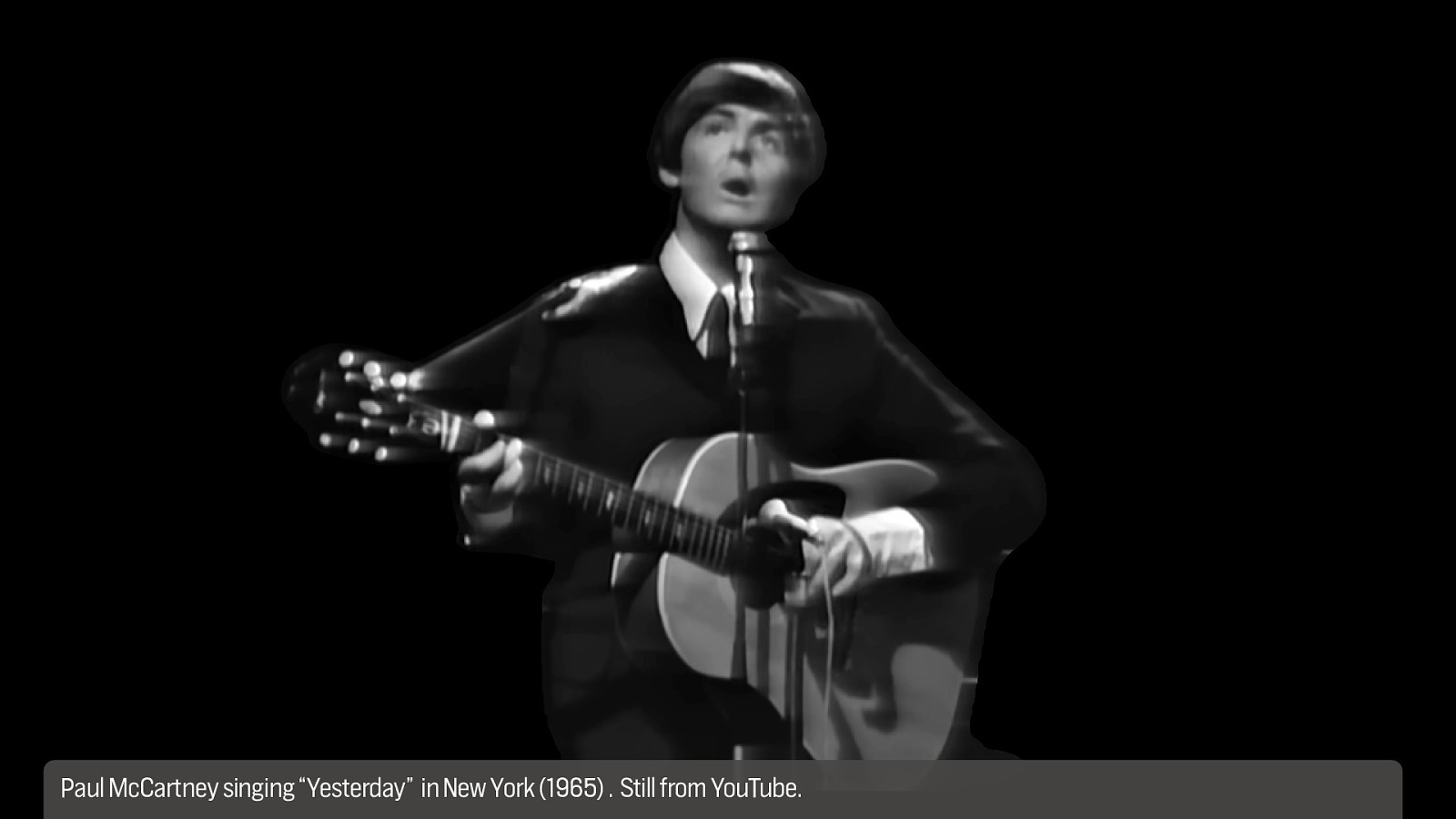
It can make us feel nostalgic, like when Paul McCartney sings “Yesterday”.
Slide 100
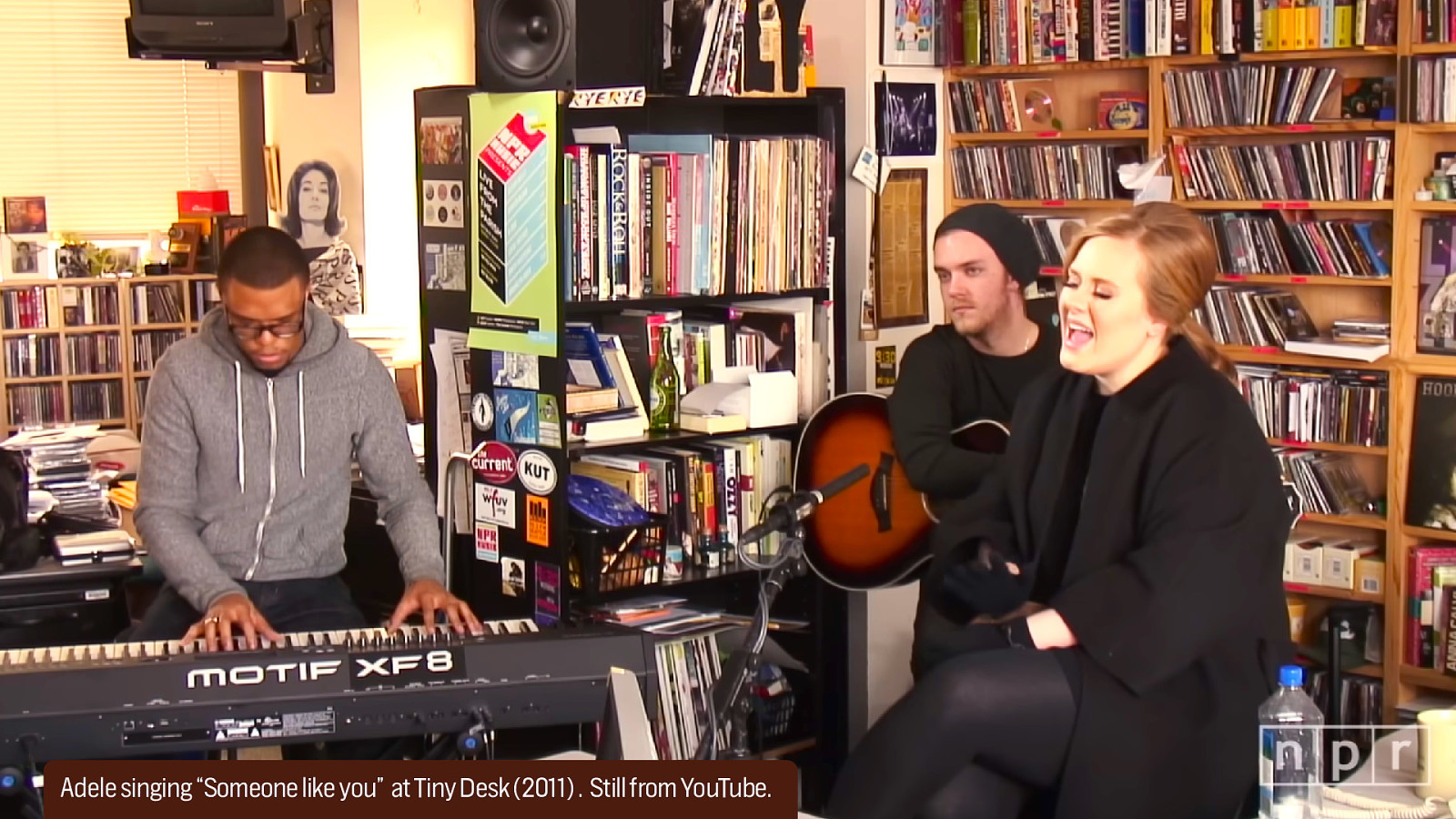
Or it may help us feel not alone when our hearts are broken, for instance when Adele sings “Someone like you”.
Slide 101
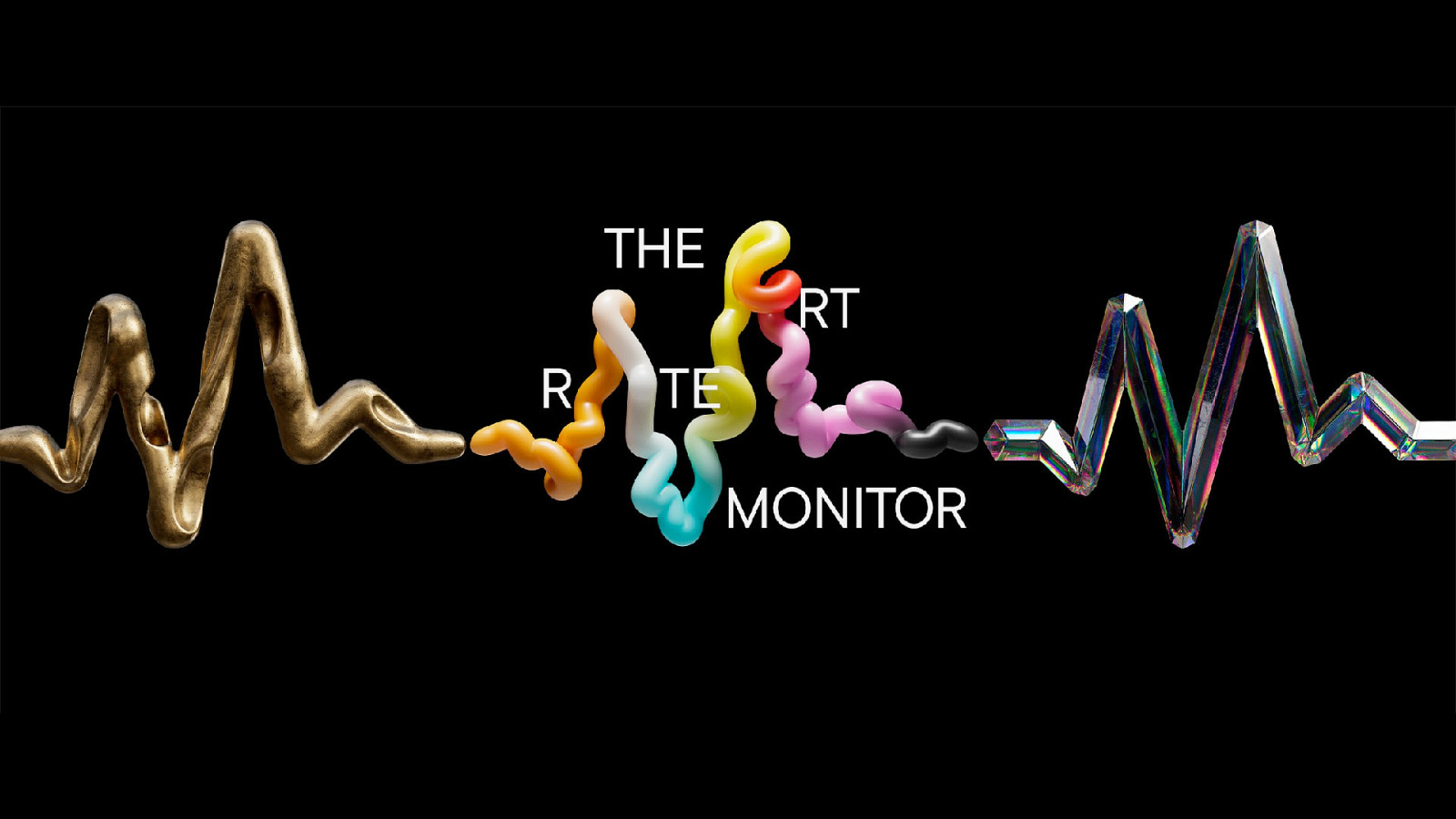
The Art Gallery of Ontario in Toronto thinks art can evoke emotions too, so they let visitors take a heart monitor with them.
Slide 102
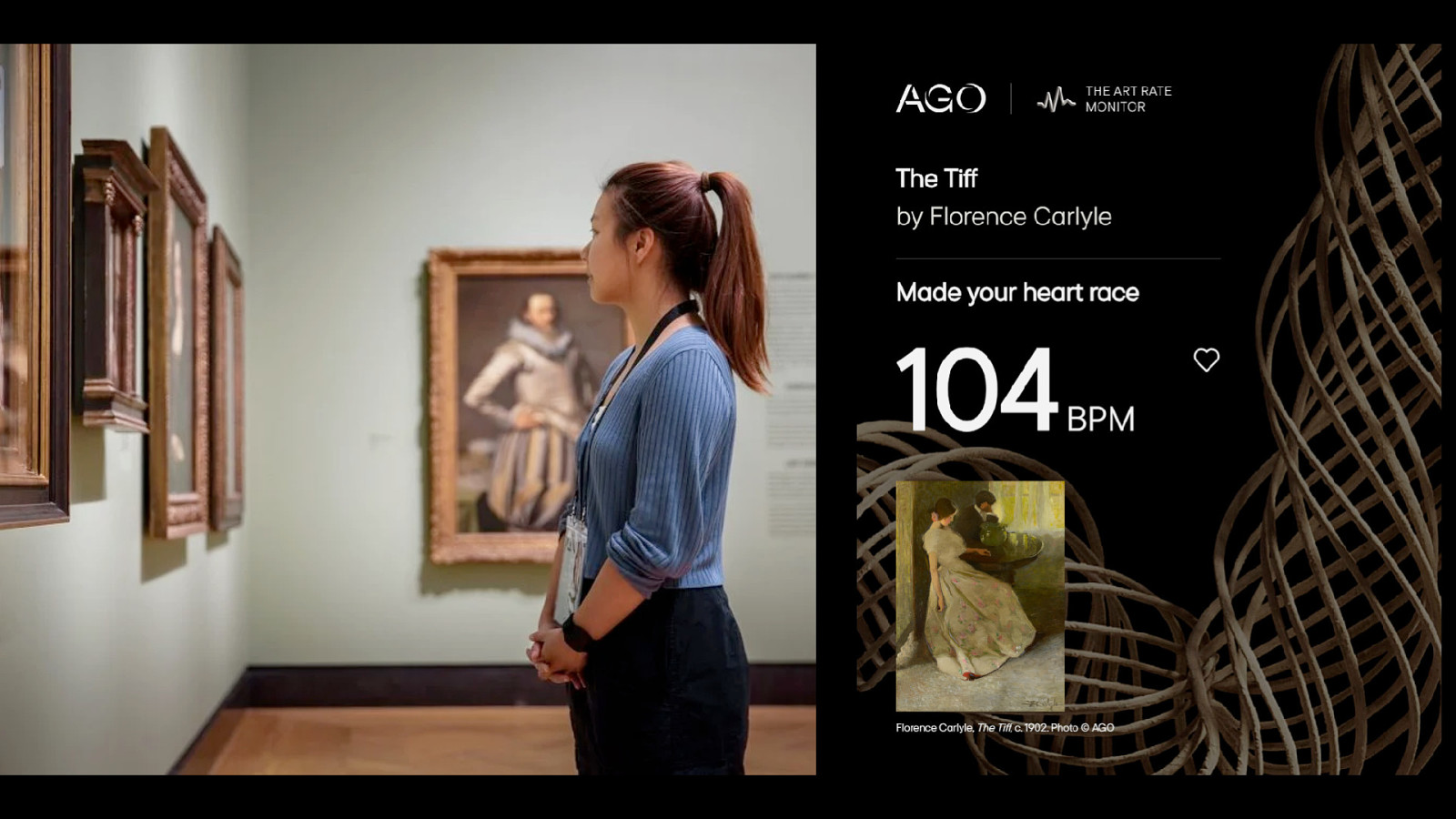
It measures your heartbeat while you walk around and tells you afterwards which touched you the most.
Slide 103

Art can take a stance
Art can also take a chance.
Slide 104
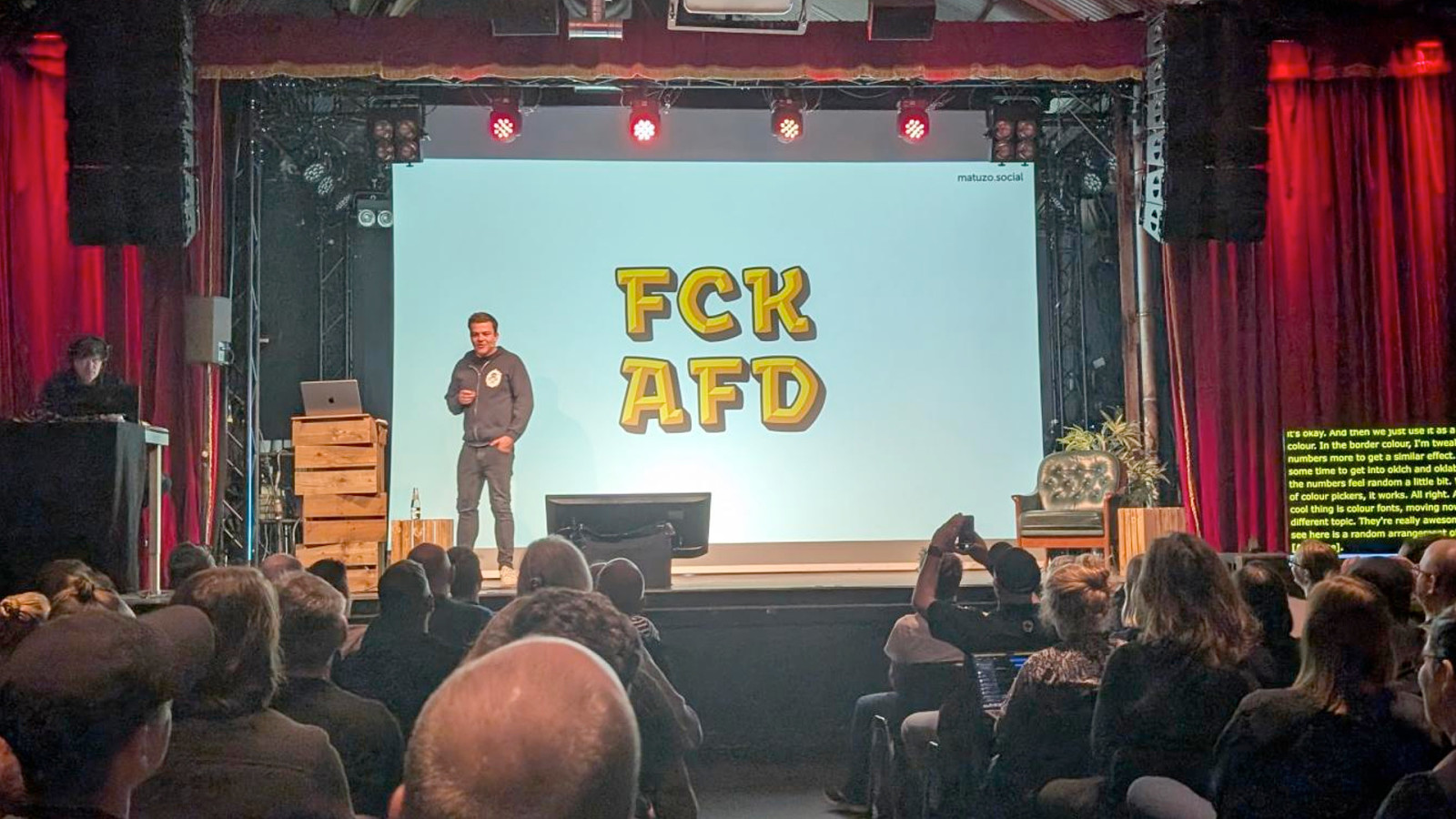
For instance, the examples you choose in your font demos…
Slide 105
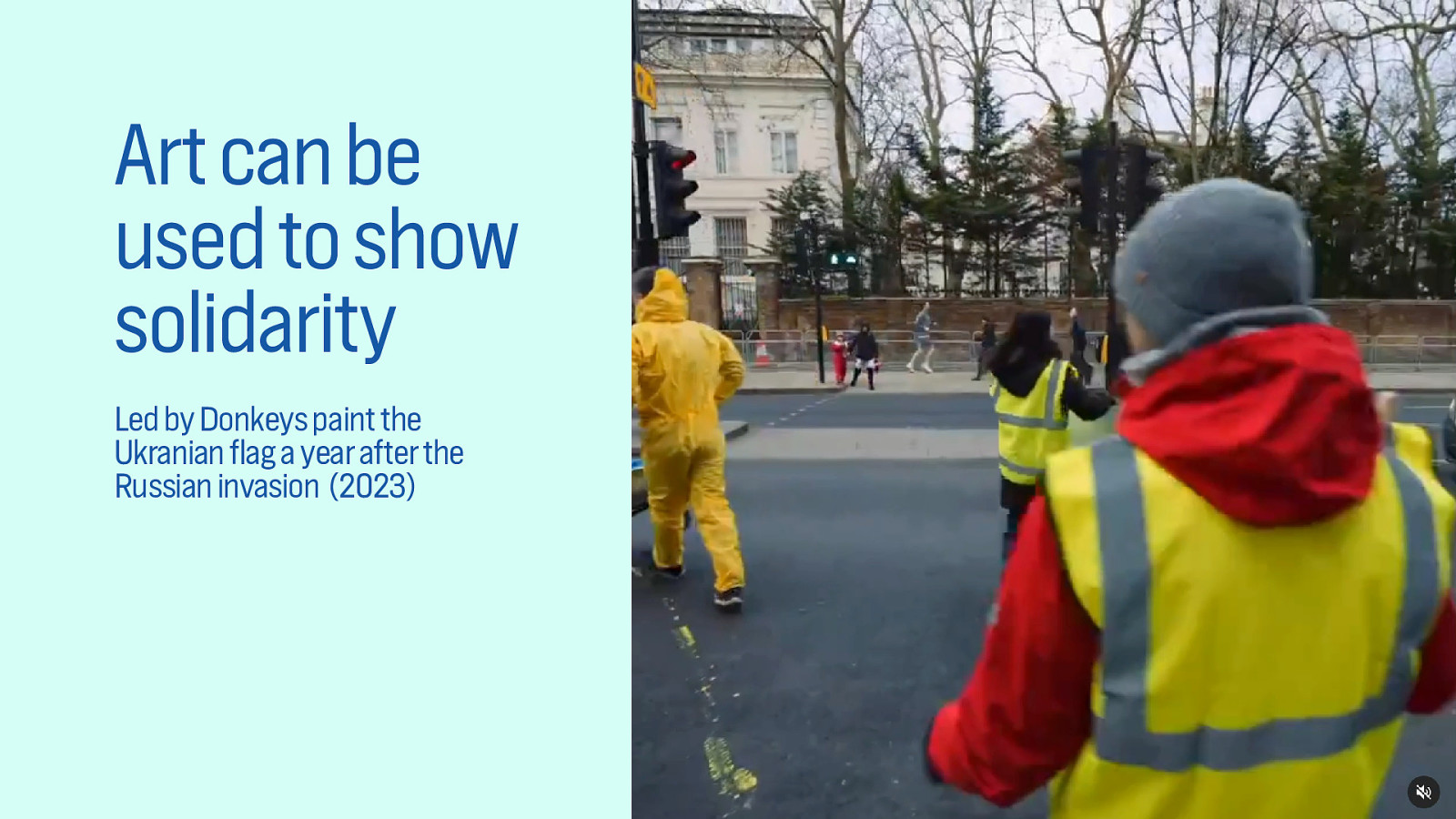
Or art can be used to show solidarity. Last year, a year after the Russian invasion of Ukraine, Led By Donkeys took large bags of washable yellow and blue paint to the street in front of the Russian embassy, stopped the cars for a few minutes and poured the paint onto the streets, a colour on each side. Then, when the cars continued, a huge Ukrainian flag appear.
Slide 106
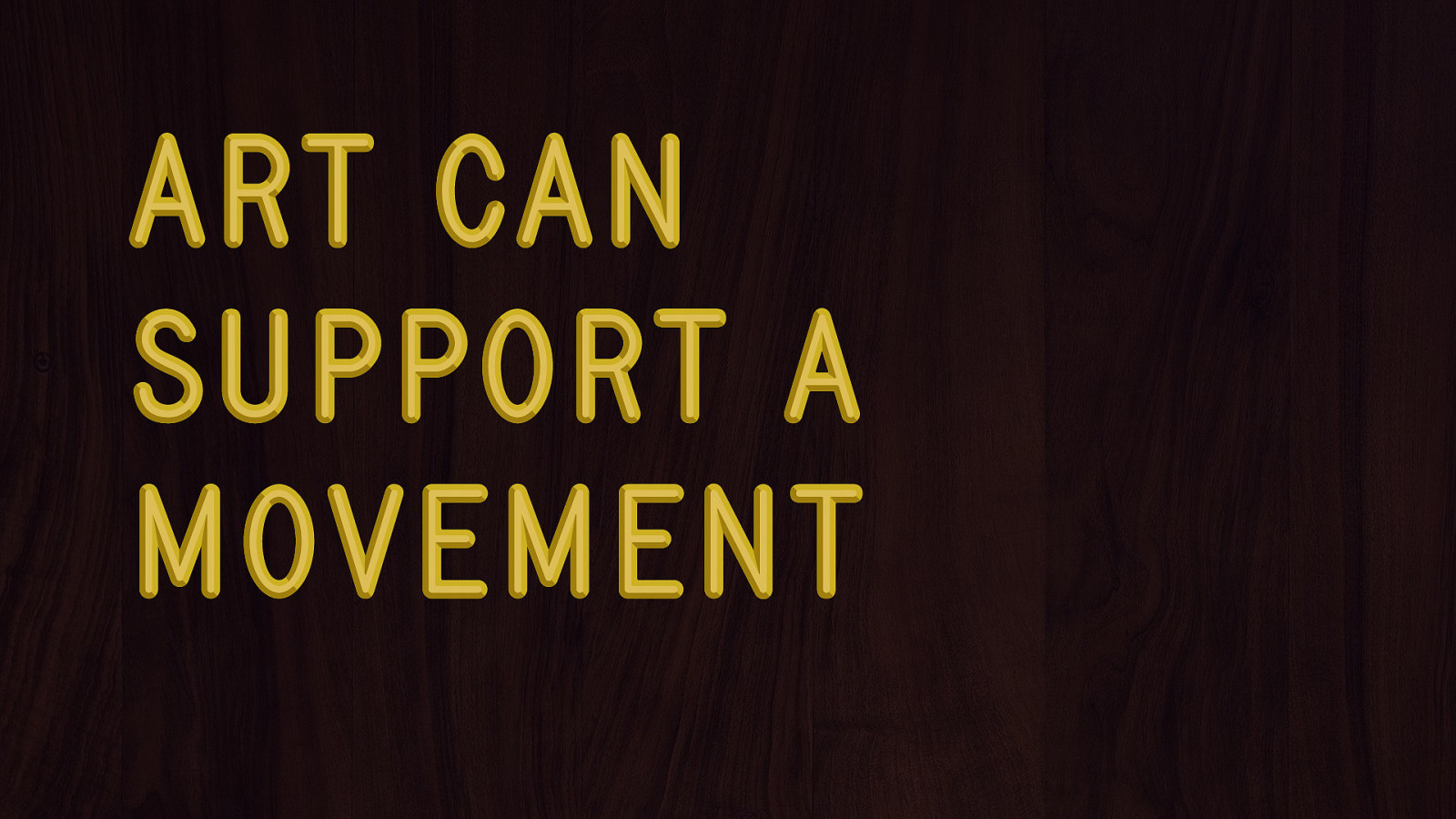
Art can support a movement
Slide 107
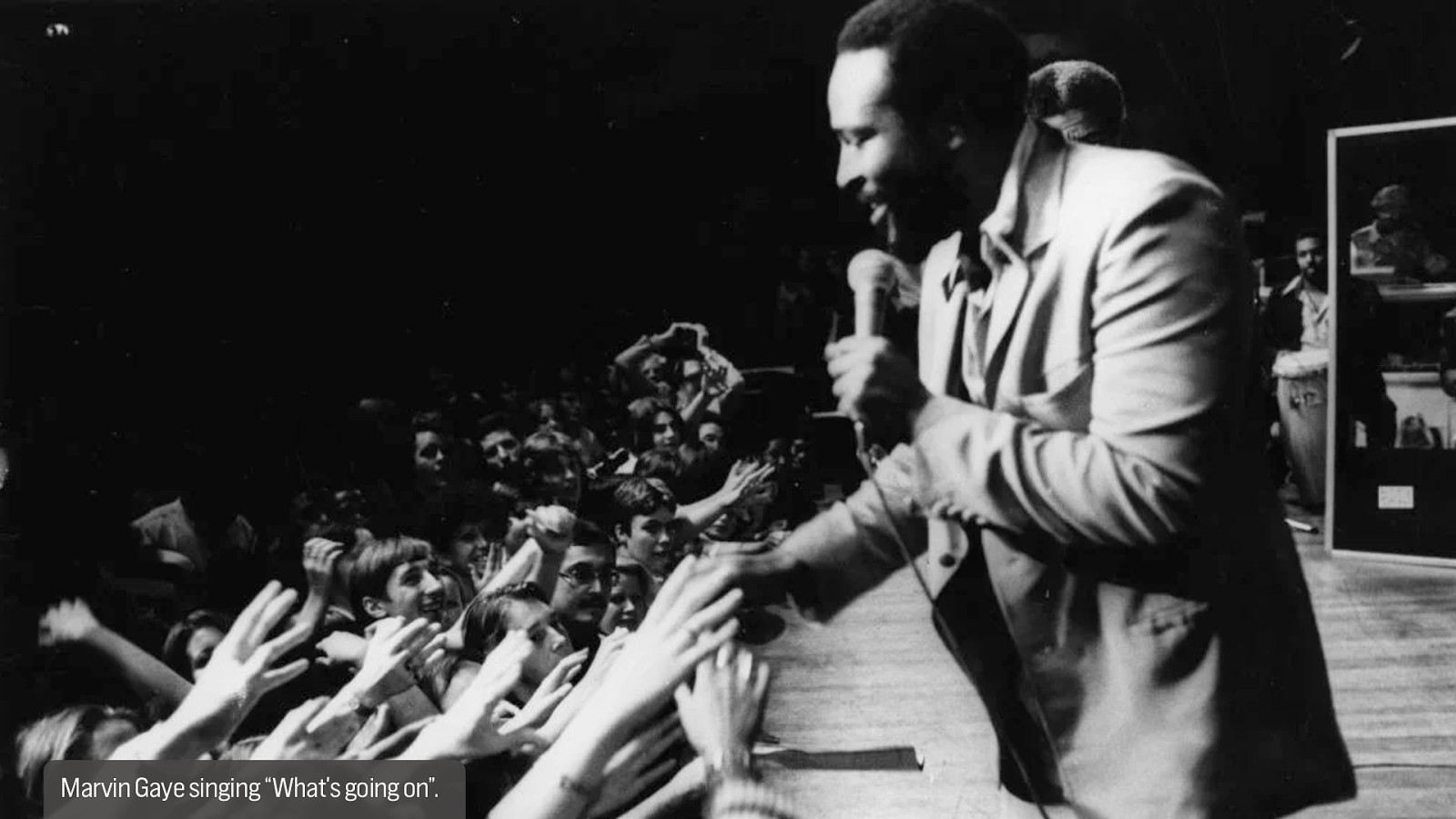
Marvin Gaye made “What’s going on” in protest of the war in Vietnam.
Slide 108
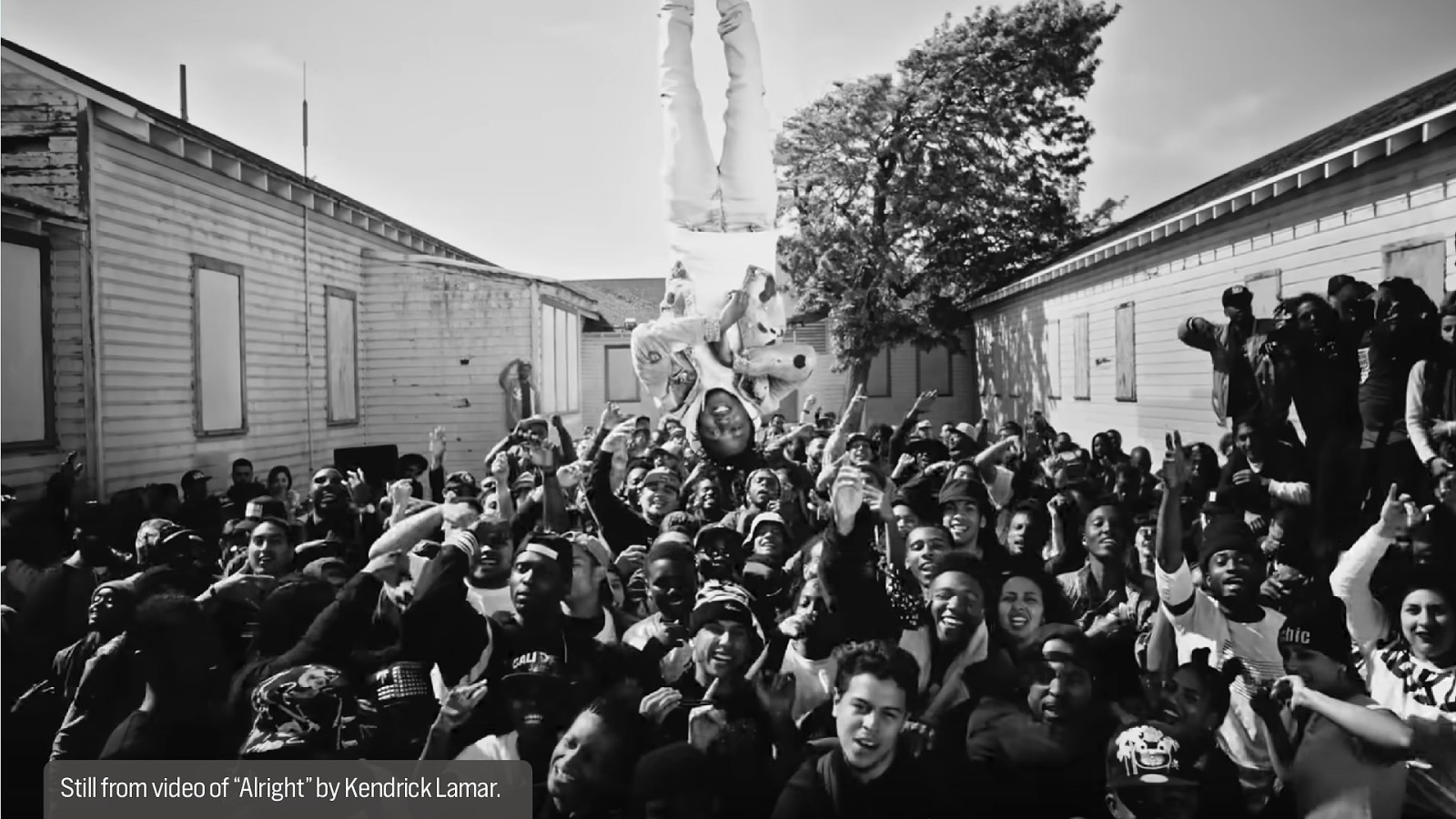
Kendrick Lamar made his song “Alright” about police violence to black folks in the US, and it was a song of hope, but also, it became an anthem of the Black Lives Matter movement in 2015, with people chanting the lyrics all over the states.
Slide 109
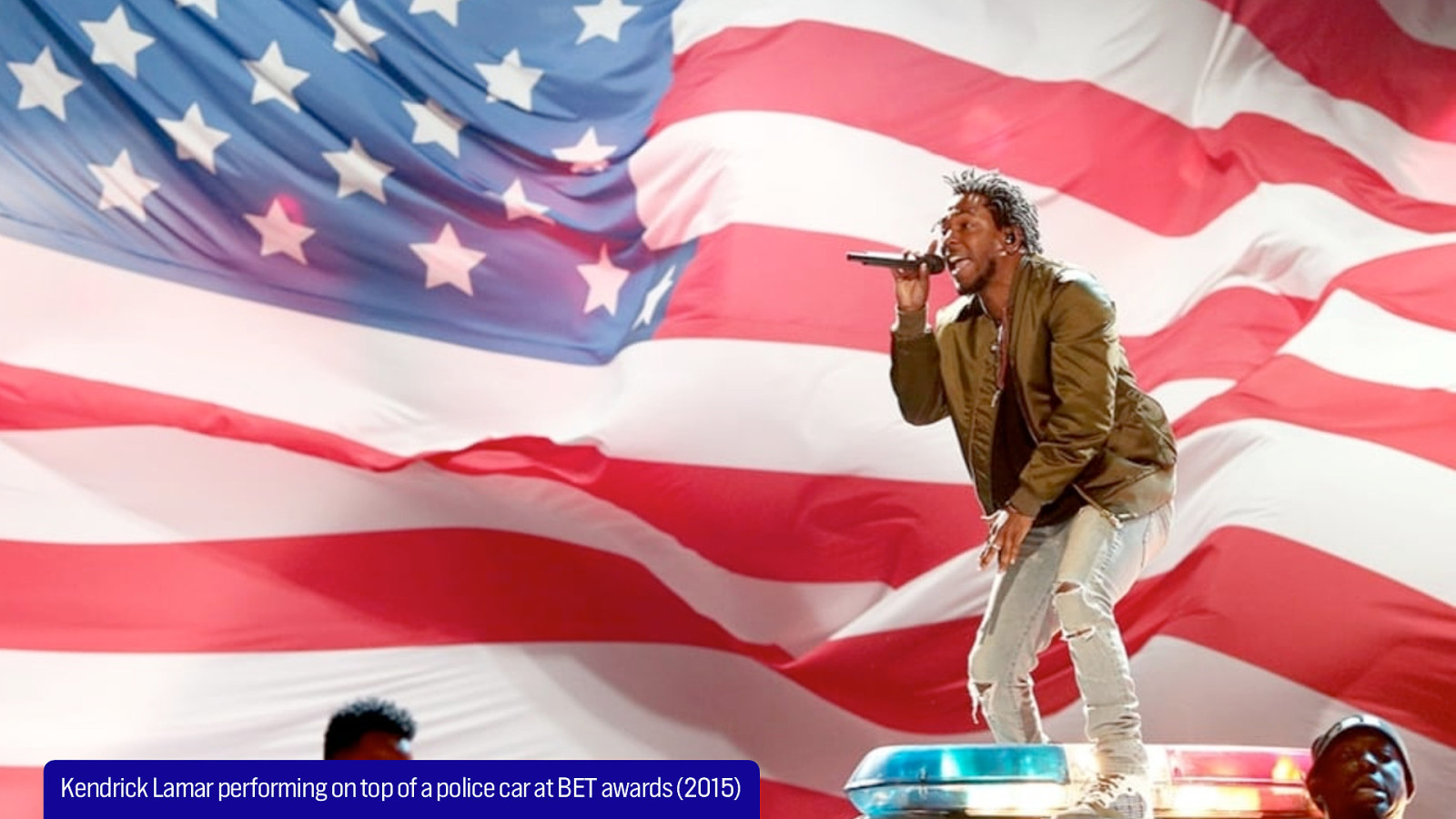
He also performed it on top of a police car at the BE awards in 2015.
Slide 110

In an interview with TMZ he explained…
“Me being on a cop car, that’s a performance piece after these senseless acts”
Slide 111
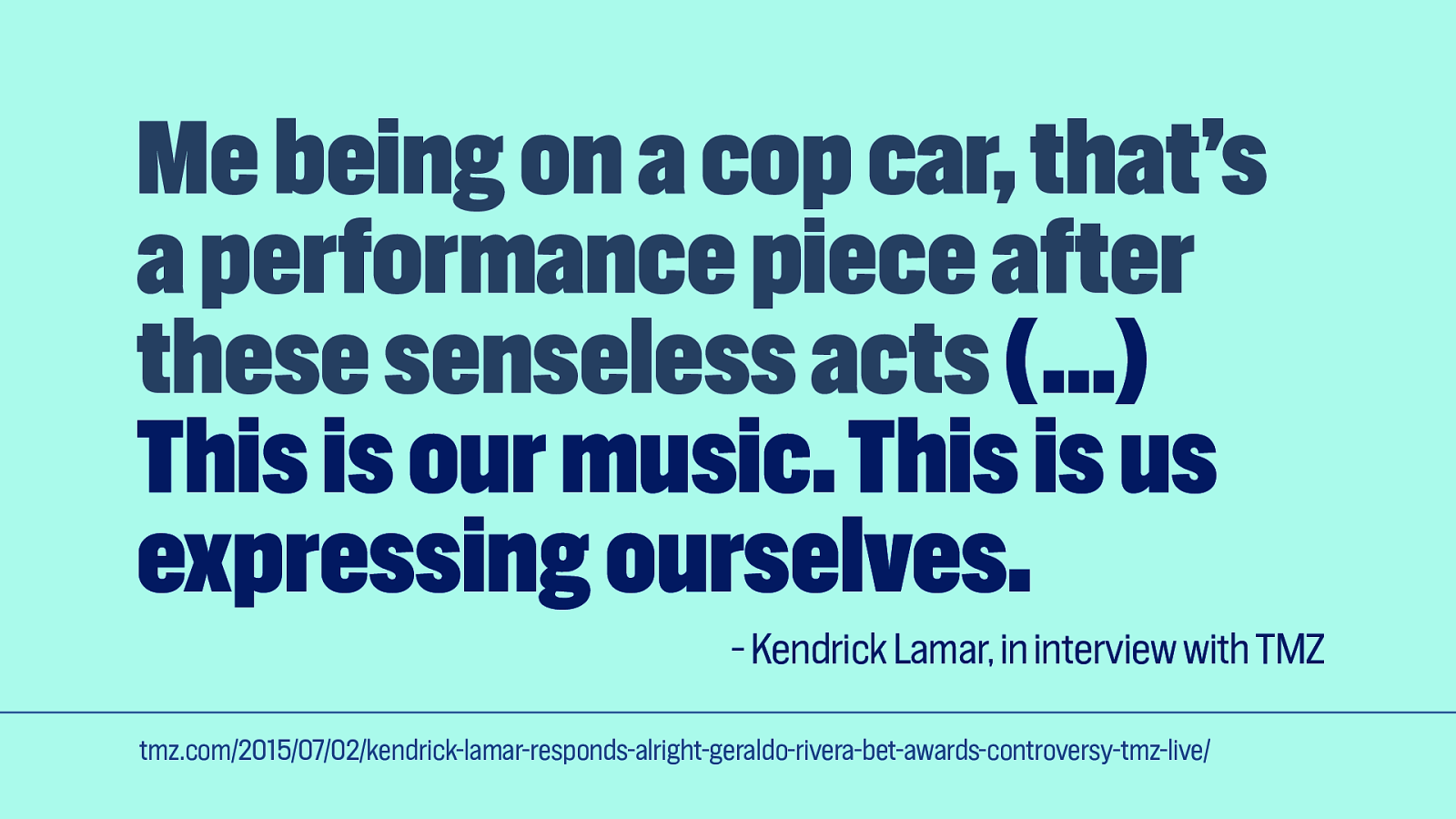
“This is our music. This is us experssing ourselves”
Slide 112
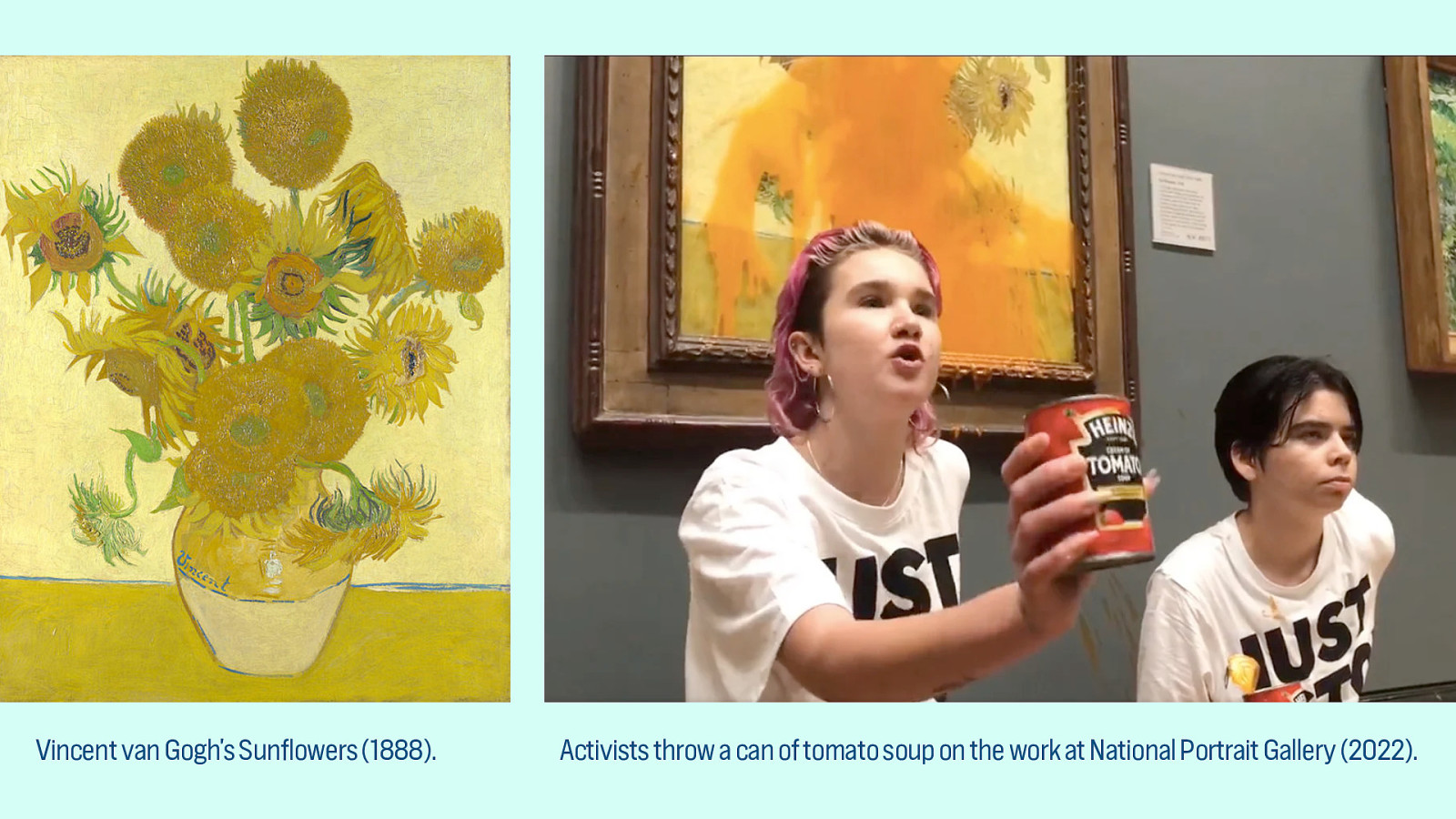
Sometimes the artist’s arent’ involved or aware of their work becoming part of a movement.
Vincent van Gogh’s painted these “Sunflowers” in 1888, they are at the National Portrait Gallery in London. Activists throw a can of tomato soup on the work in 2022.
Slide 113
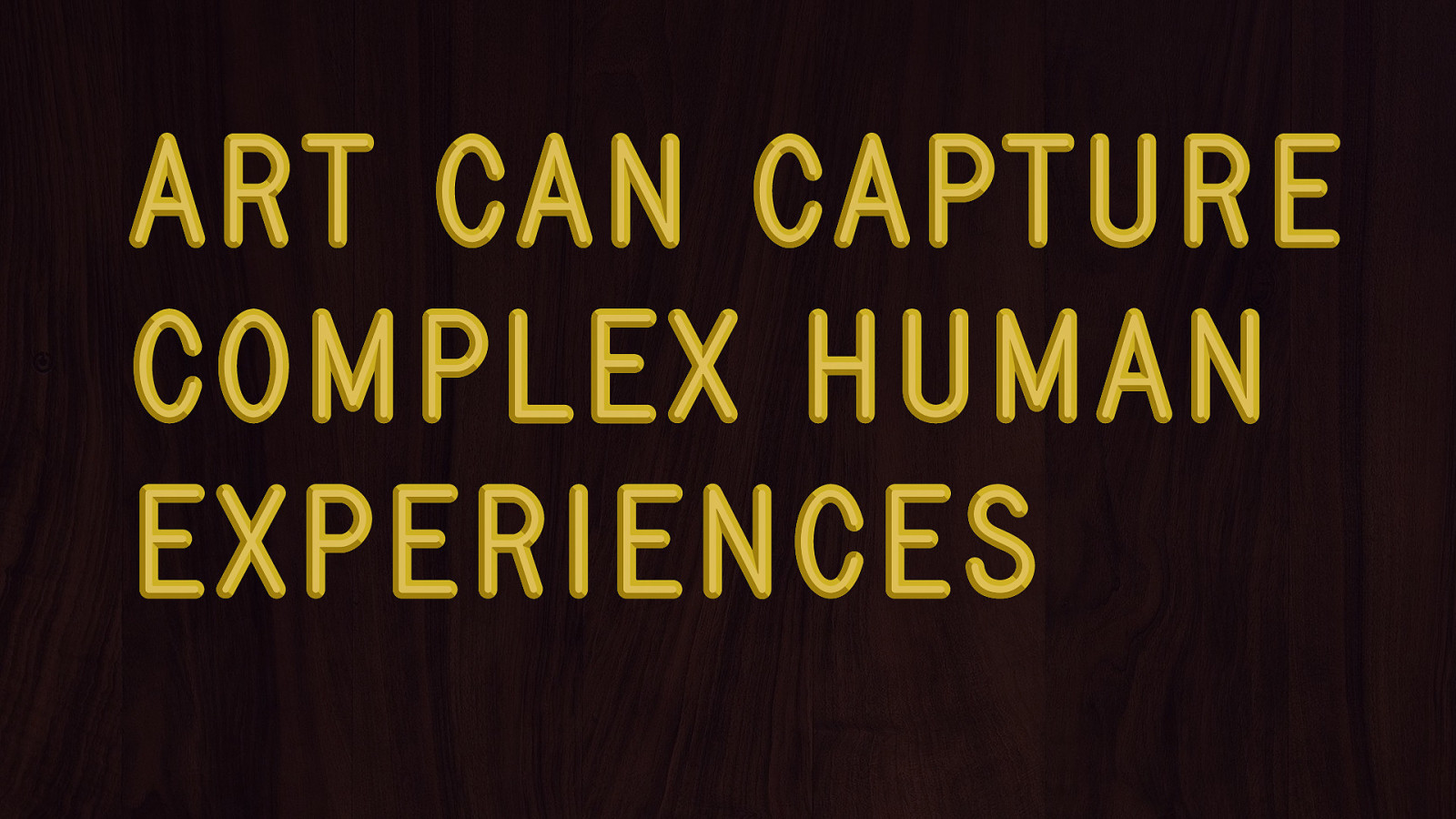
Art can capture complex human experiences
The world is a complicated place… feelings and experiences are hard to express.
Slide 114
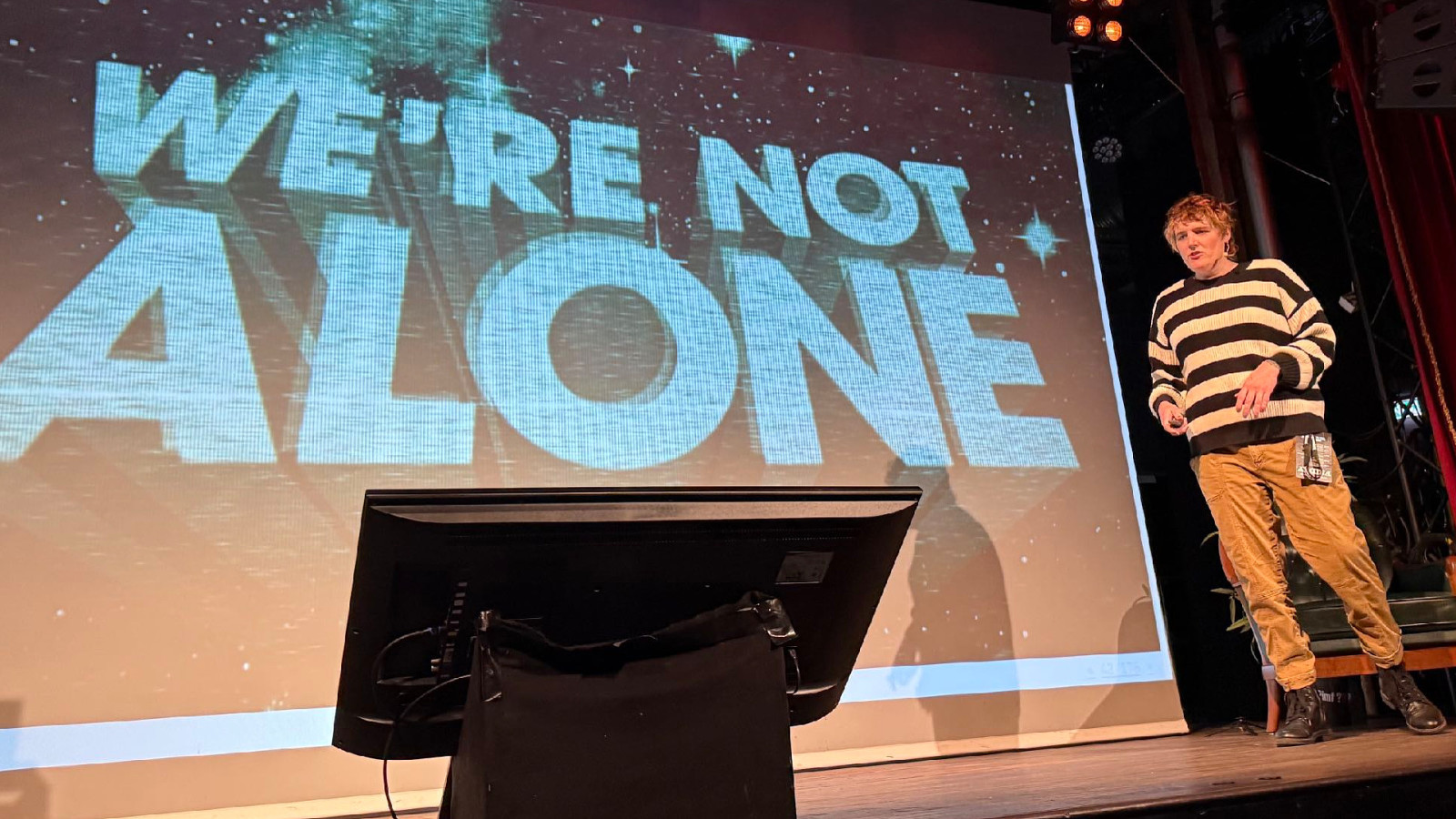
but as Mia said, we’re not alone.
Art can uniquely capture these coplex feelings.
Slide 115
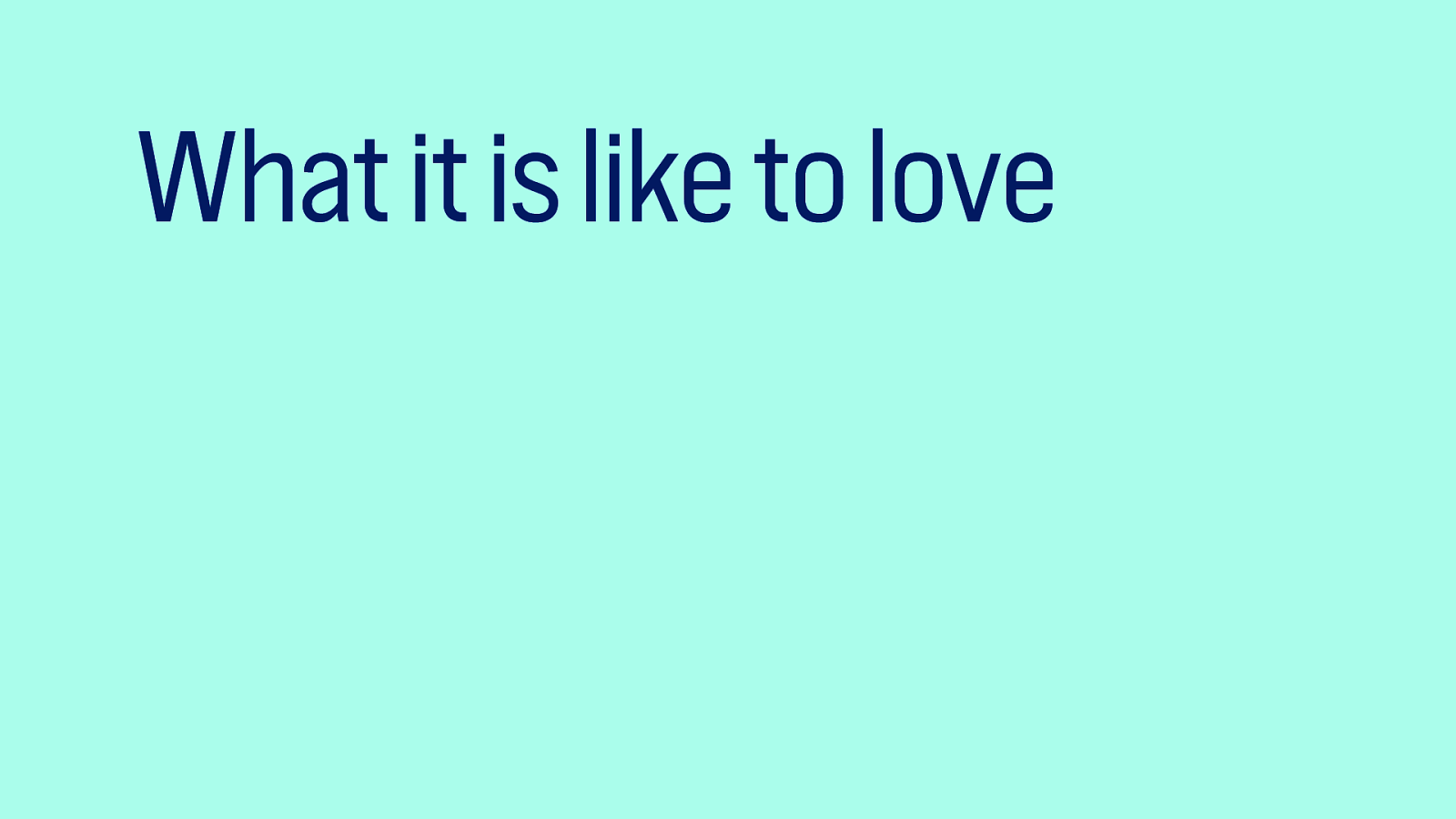
Feelings like what it is like to love.
Isn’t pretty much all pop music about that?
Slide 116
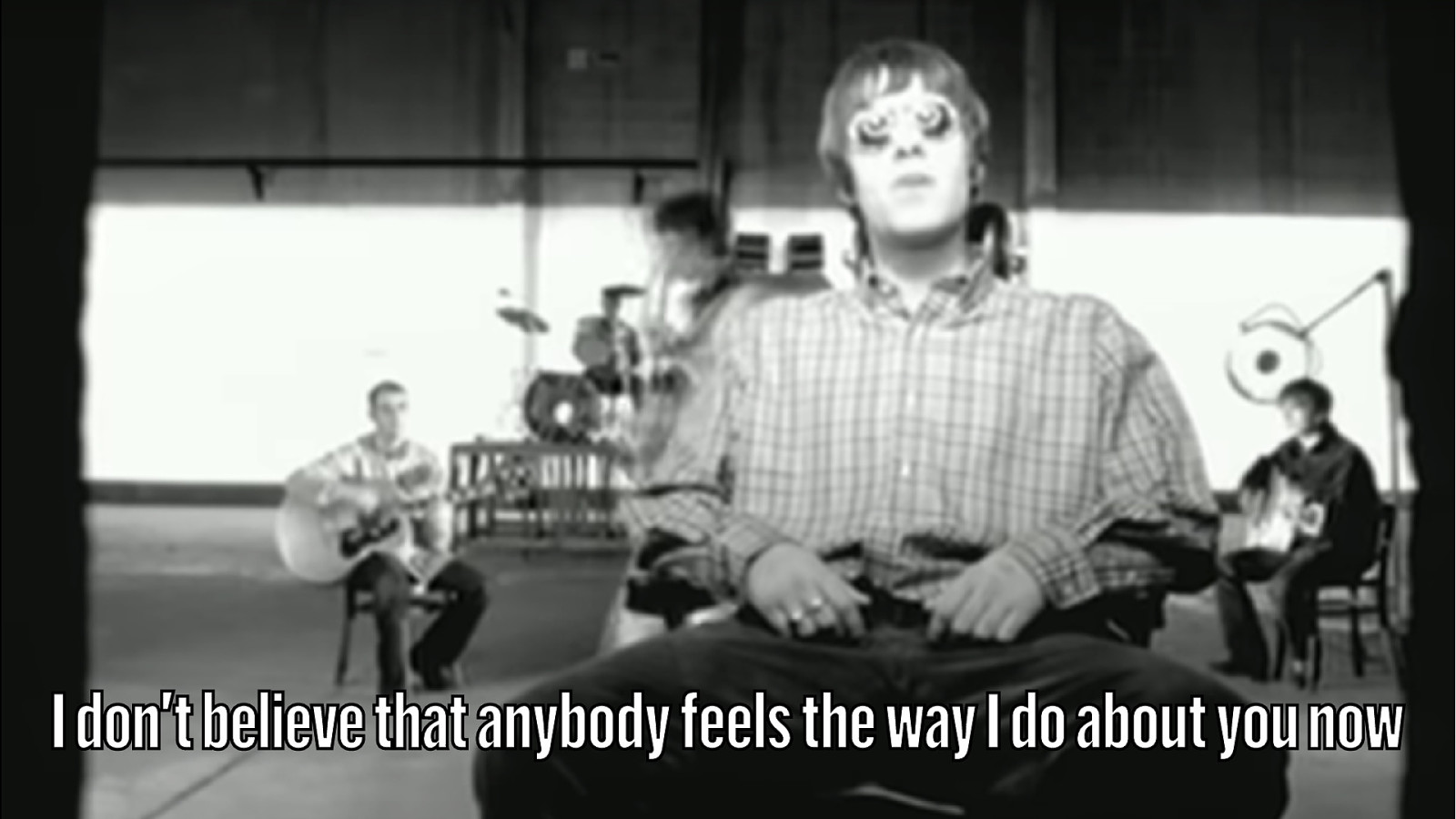
(Screenshot from Oasis’ video for Wonderwall, with lyrics “I don’t believe that anybody feels the way I do about you now”)
Slide 117
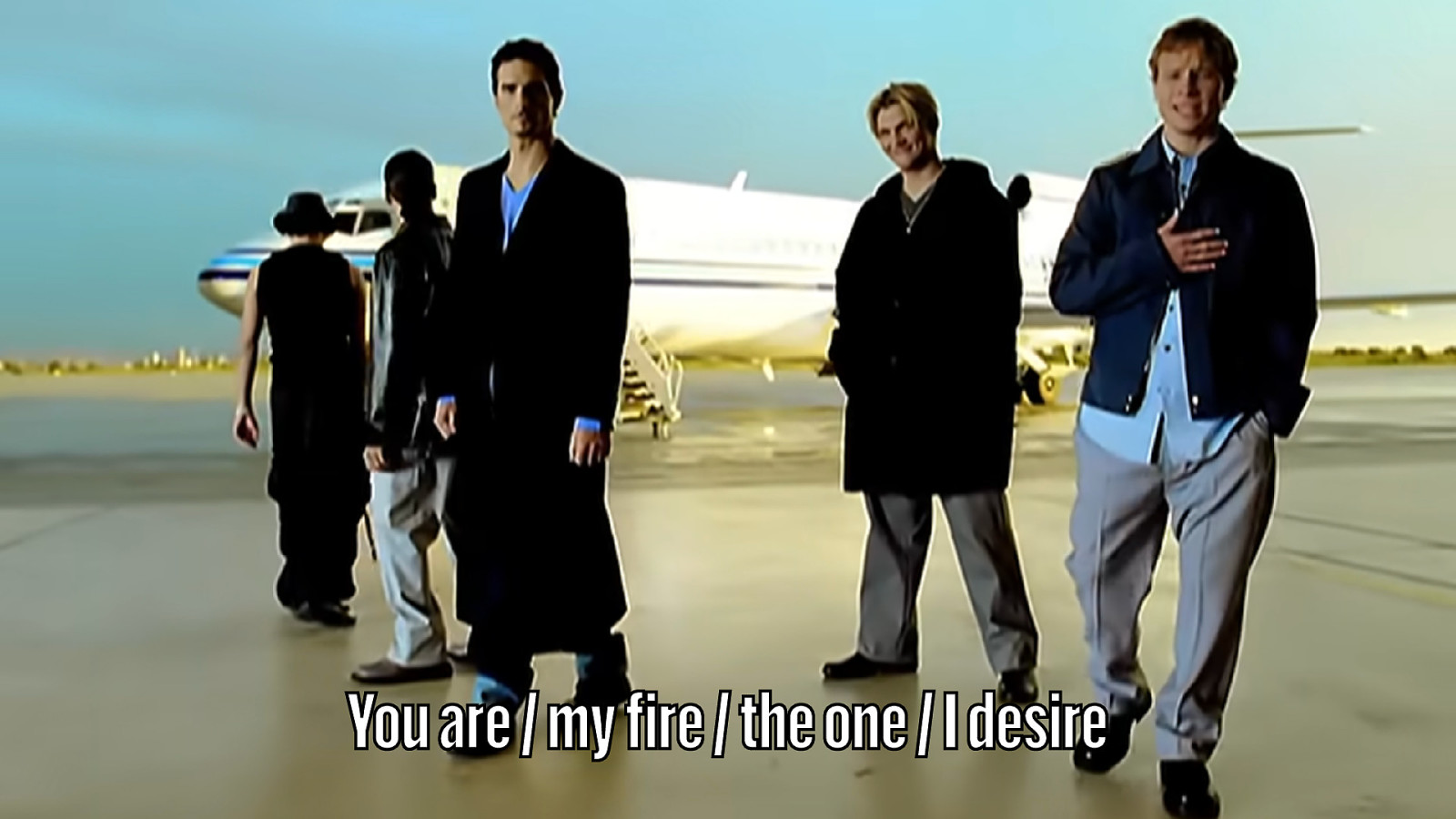
(Screenshot from the Backstreet Boys’ video for Want It That Way, with lyrics “You are / my fire / the one / I desire”)
Slide 118
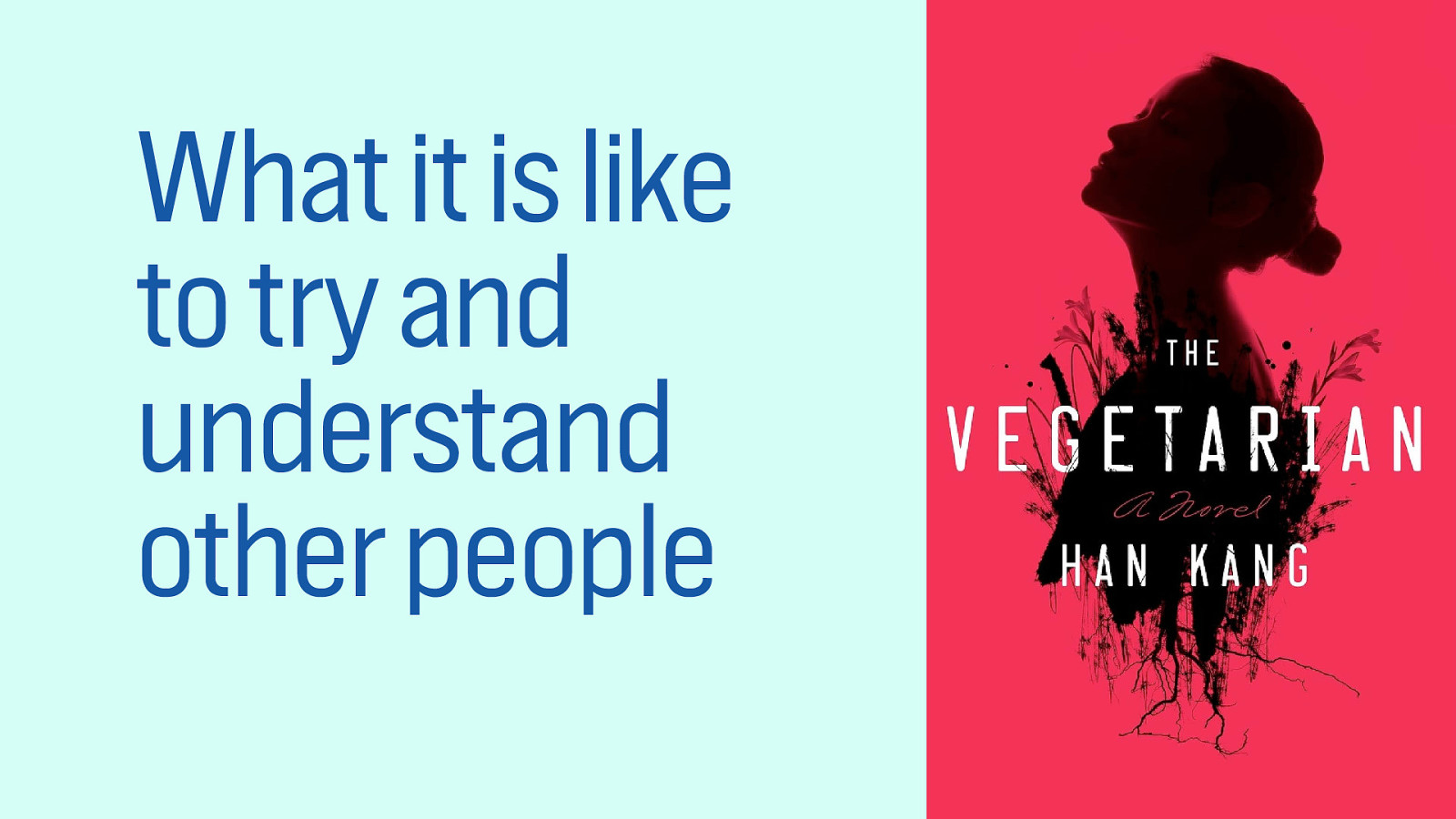
The novel “The Vegetarian”, by Han Kang, who just got the Nobel prize for literature, is about what it is like to try and understand other people. The protagonist has violent dreams about animal violence one night, and decides to call quits on eating meat as of the next day. This completely changes her relationship to everyone and everything around her.
Slide 119
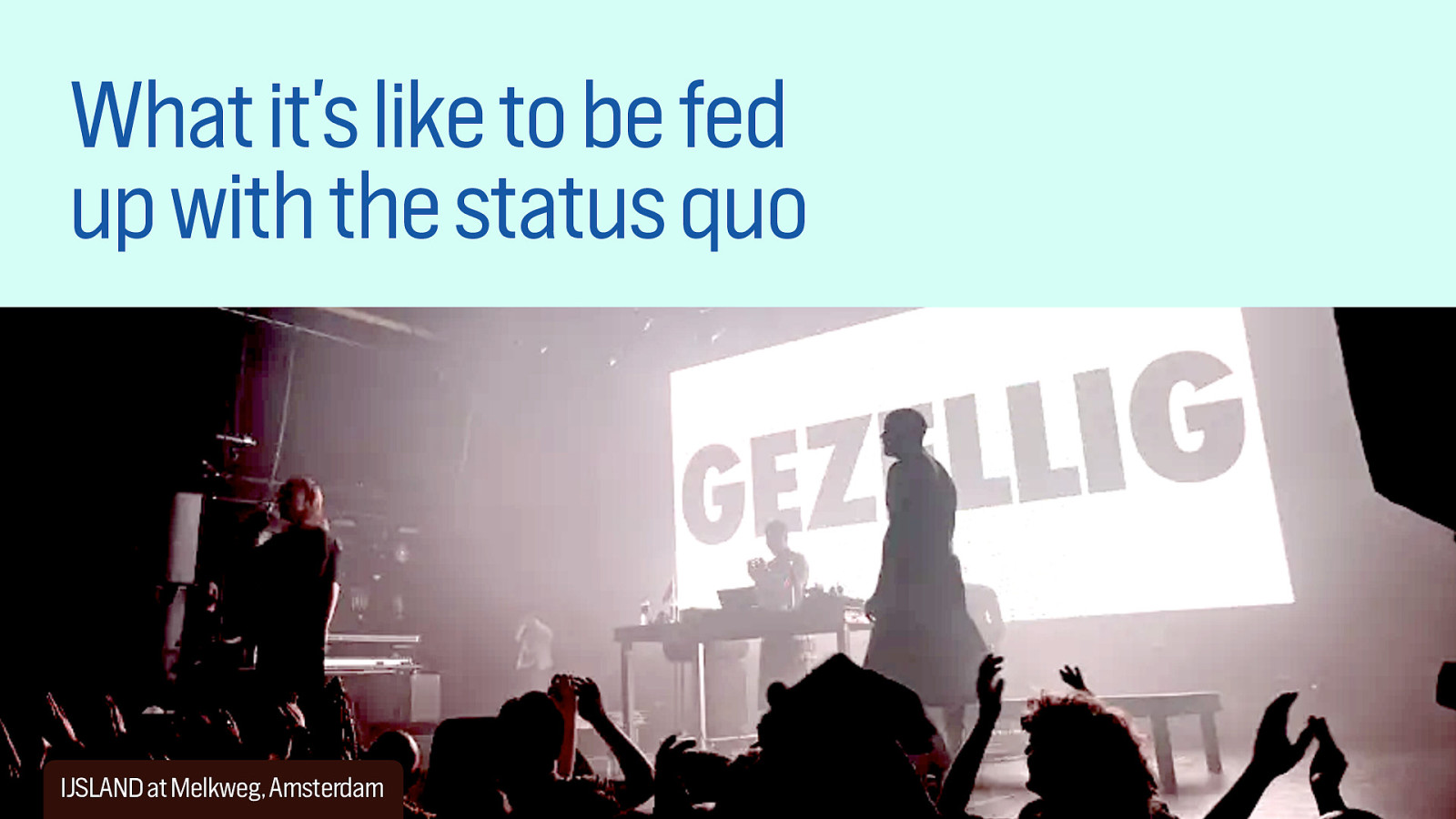
Two Dutch rappers formed a temporary group this year called IJSLAND to make a conceptual album about the status quo.
And wow what a status quo we have… a looming WW3, wide normalisation of senseless anti-immigrant rhetoric, hyper capitalism and transphobia. Their album is about this and makes noise about the situation, and it talks about their and our own hypocrisy when it comes to solving the problems.
Slide 120
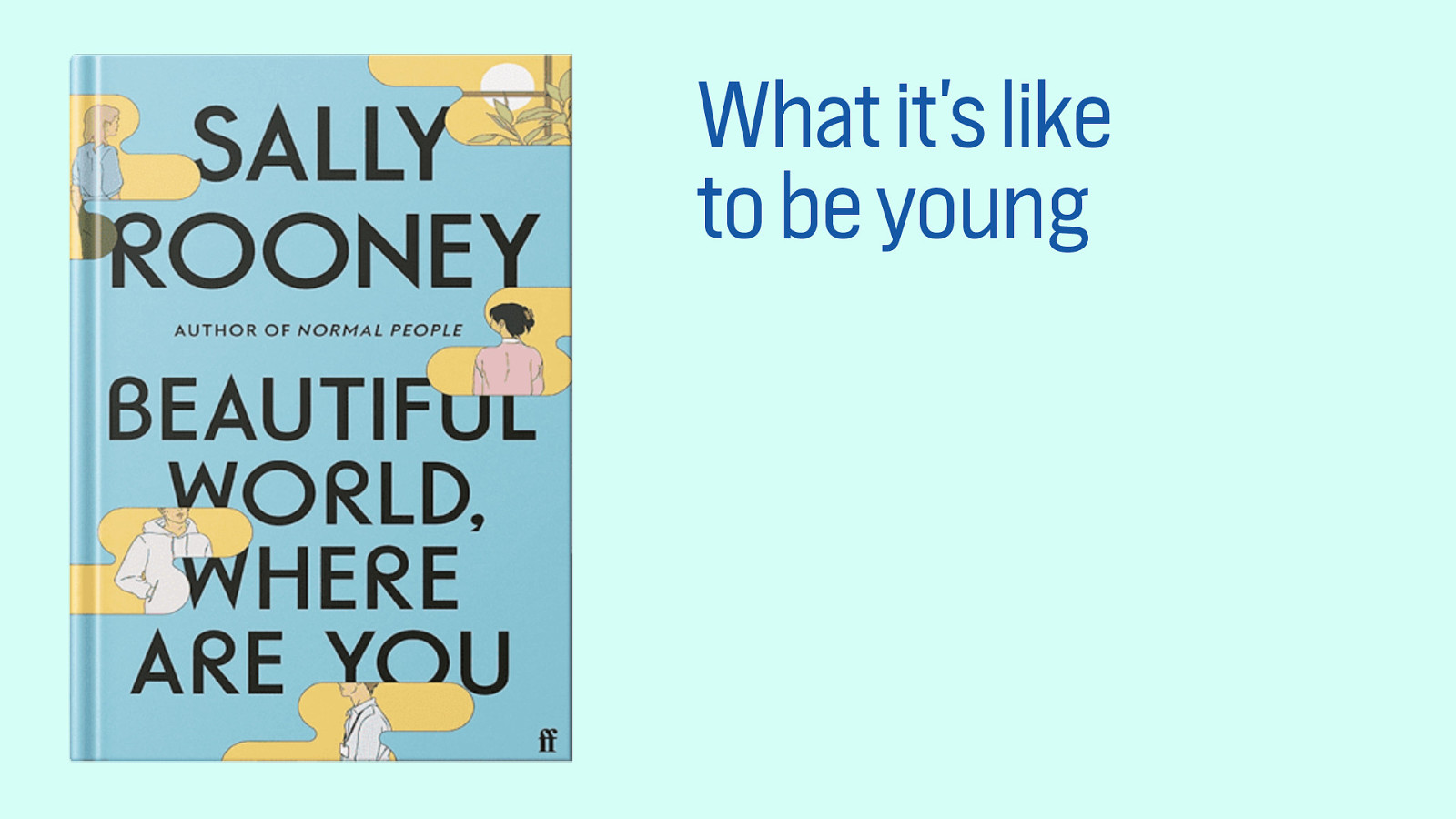
And art can capture experiences like what it’s like to be young, like a lot of Sally Rooney’s work does.
Slide 121
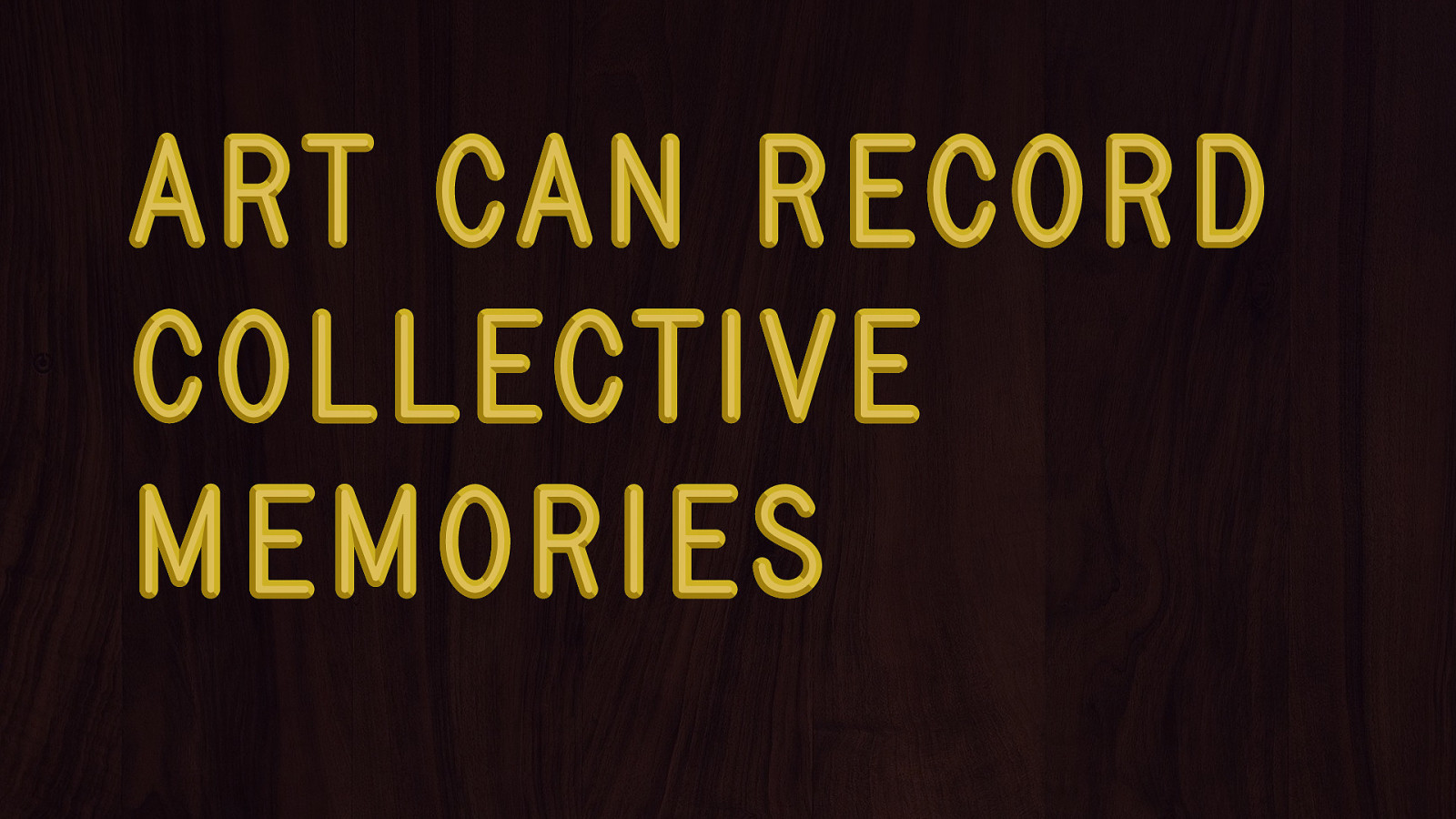
Art can record collective memories
Slide 122
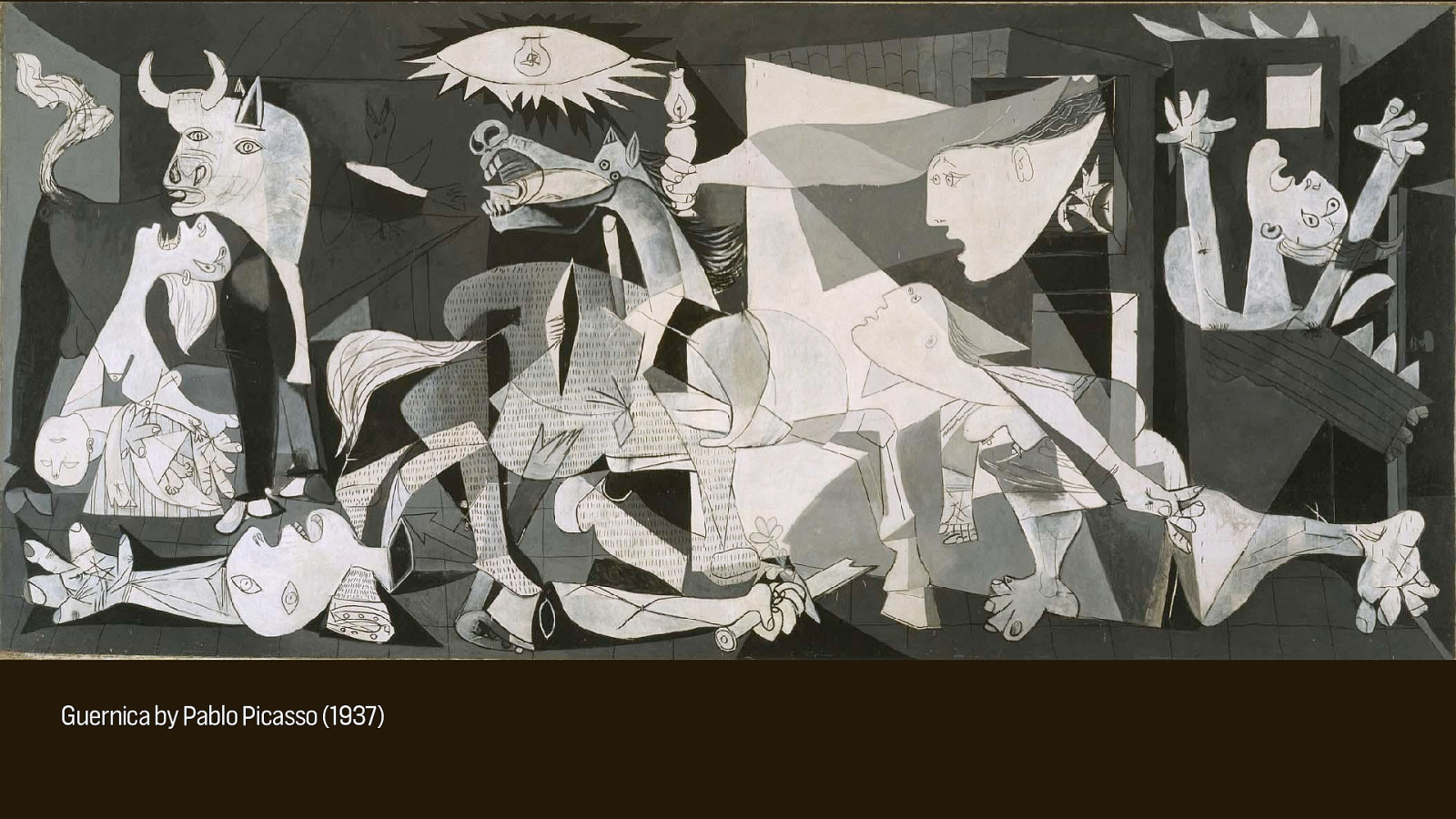
Guernica by Picasso is seen as the ‘most moving and powerful anti-war painting’ in art history, it features a dead baby, dismembered soldier and flames. The city of Guernica was bombed that year for about 2 hours, killing mostly women and children, as the men were out to fight on behalf of the Republicans.
Fun fact: a tapestry copy of it hangs at the entrance of the Security Council at the United Nations Headquarters.
Slide 123
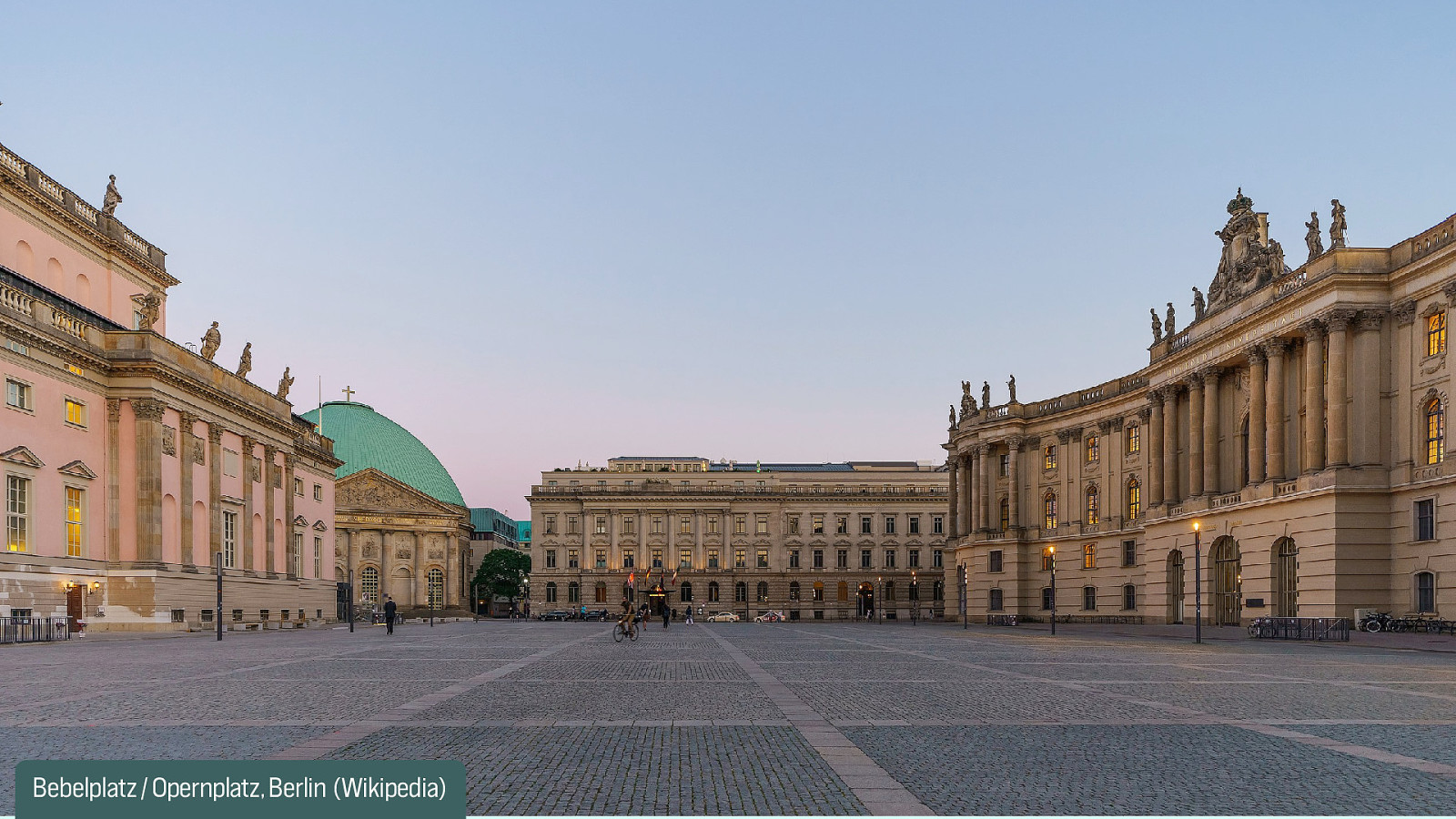
On the Bebelplatz, here in Berlin, on 10 May 1933, a nazi student union burned over 30,000 books.
Slide 124
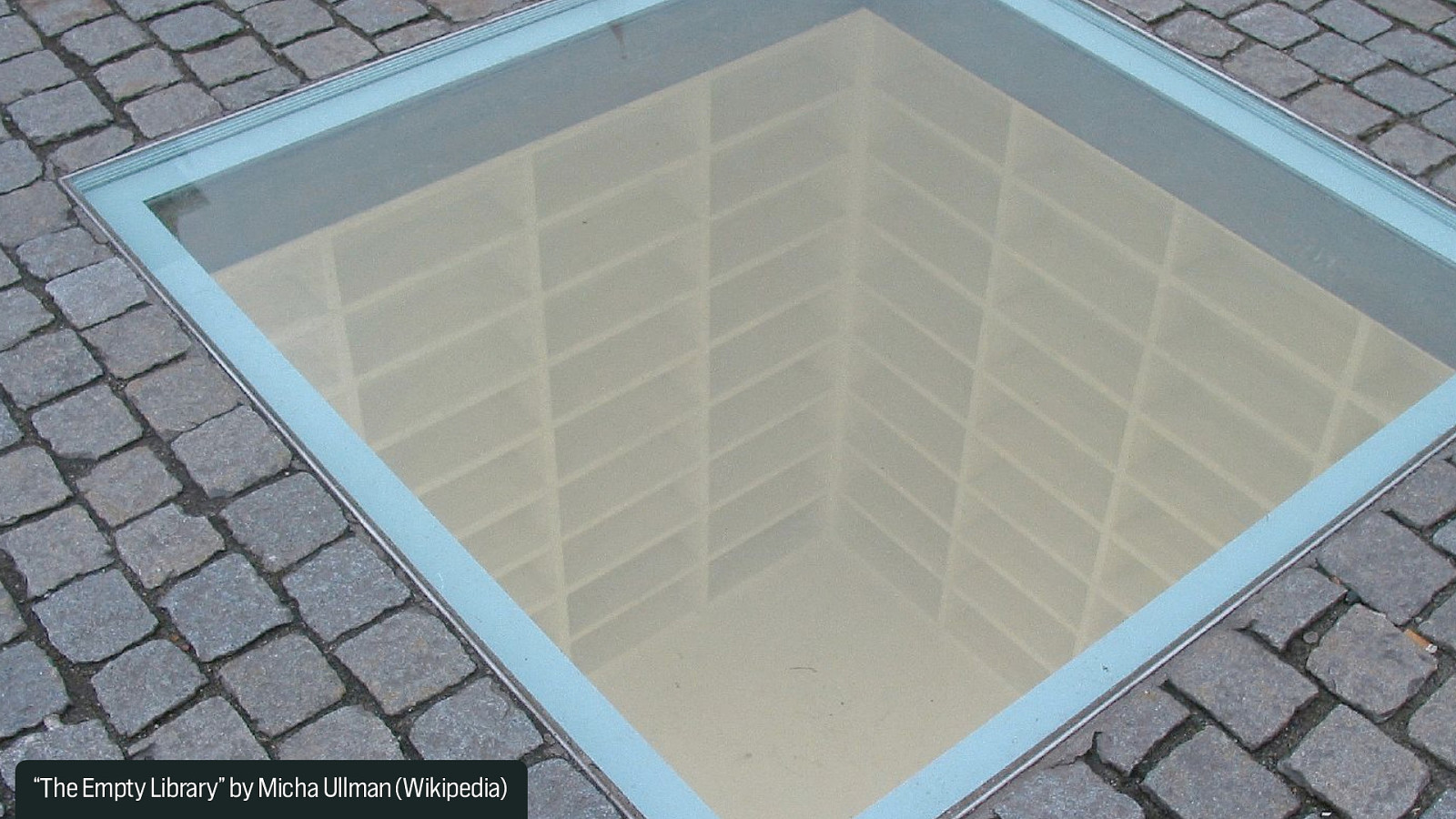
An art installation captures some of this history, it’s a lot of empty book shelves with space for 30,000 books, called “The Empty Library”, made by Micha Ullman (Wikipedia)
Slide 125
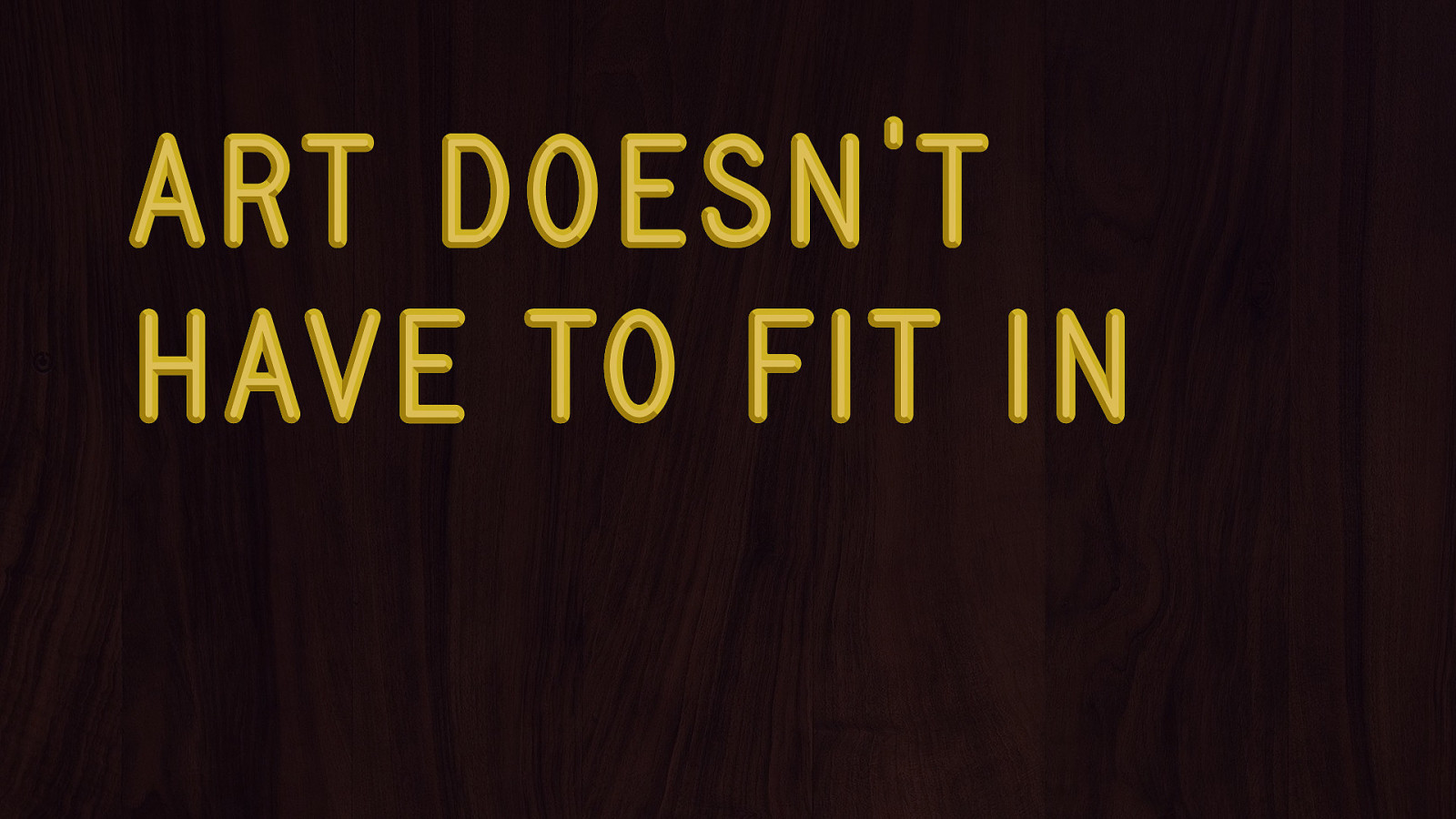
Art doesn't have to fit in
Slide 126
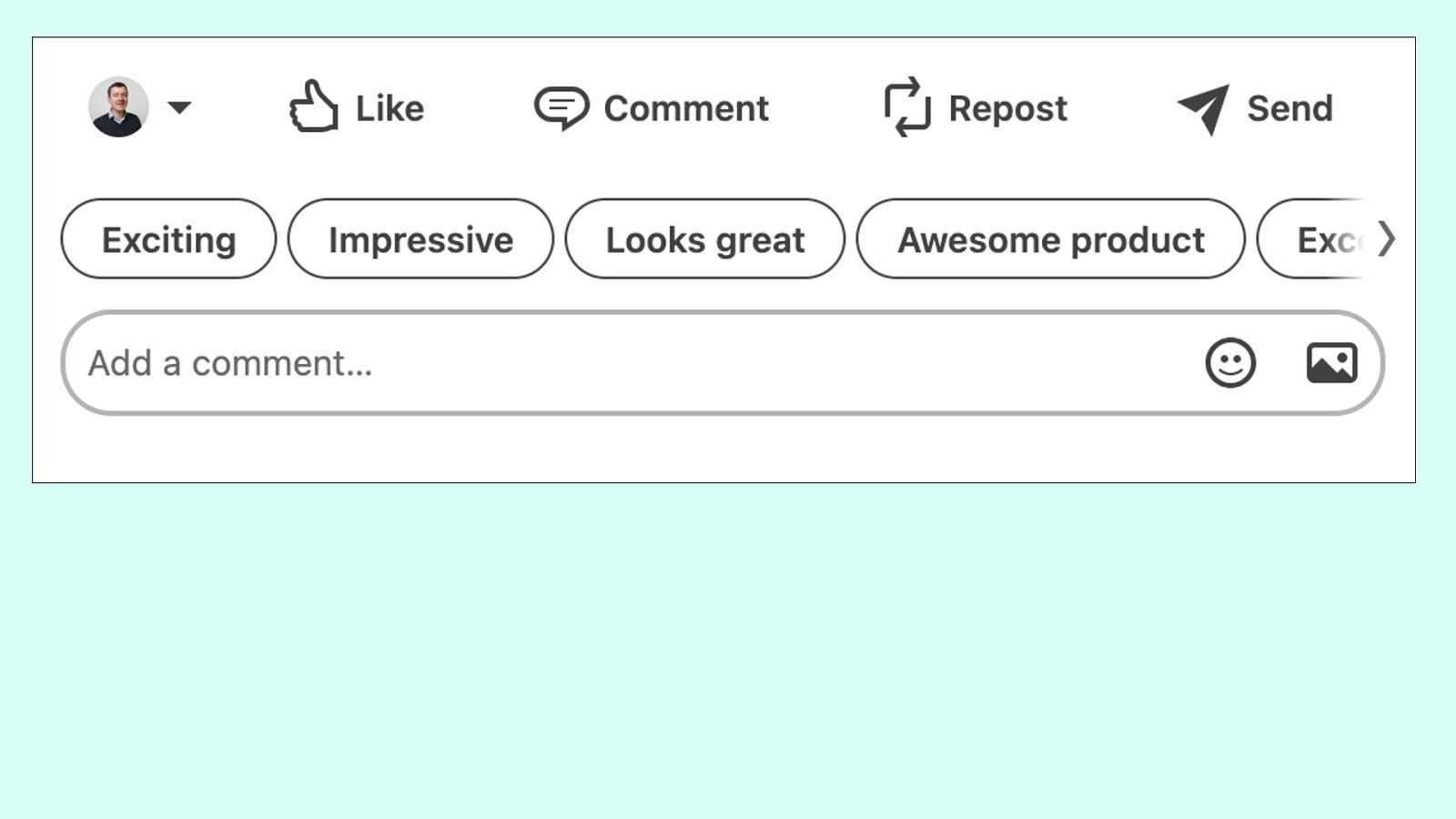
You know how, one LinkedIn, we all try to fit in? It even helps with this, it gives you little boxes to click so you can reply in the most normal way.
If we want to be as normal as we possibly can. But LinkedIn isn’t normal, we have more to say to one another than the kind of high-fiving LinkedIn forces upon us.
AI does this a lot, it can help us talk like business people are supposed to.
Slide 127
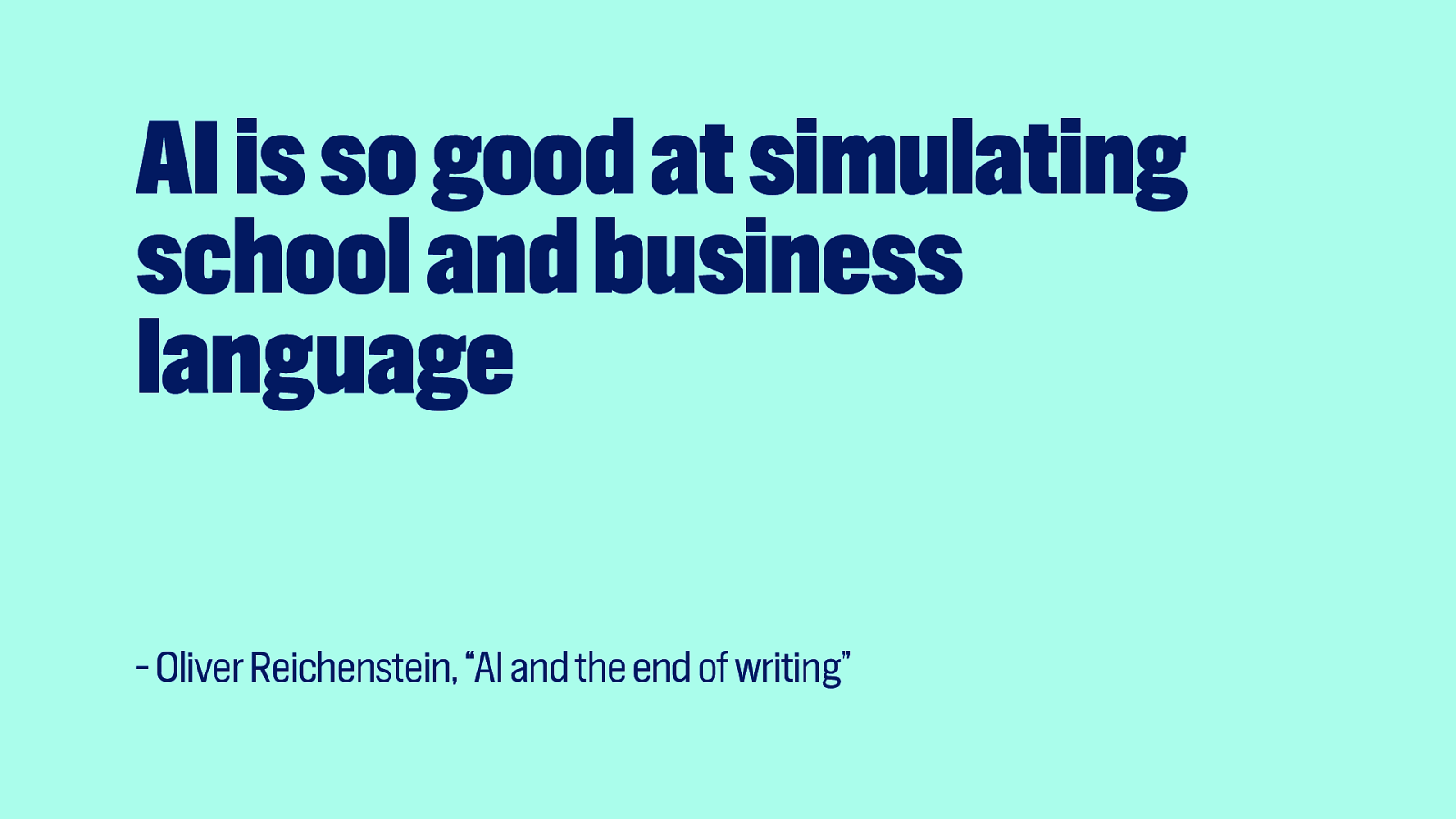
Oliver Reichenstein, of the brilliant iA Writer app, wrote in “AI and the end of writing”, that AI is so good at simulating school and business language…
Slide 128
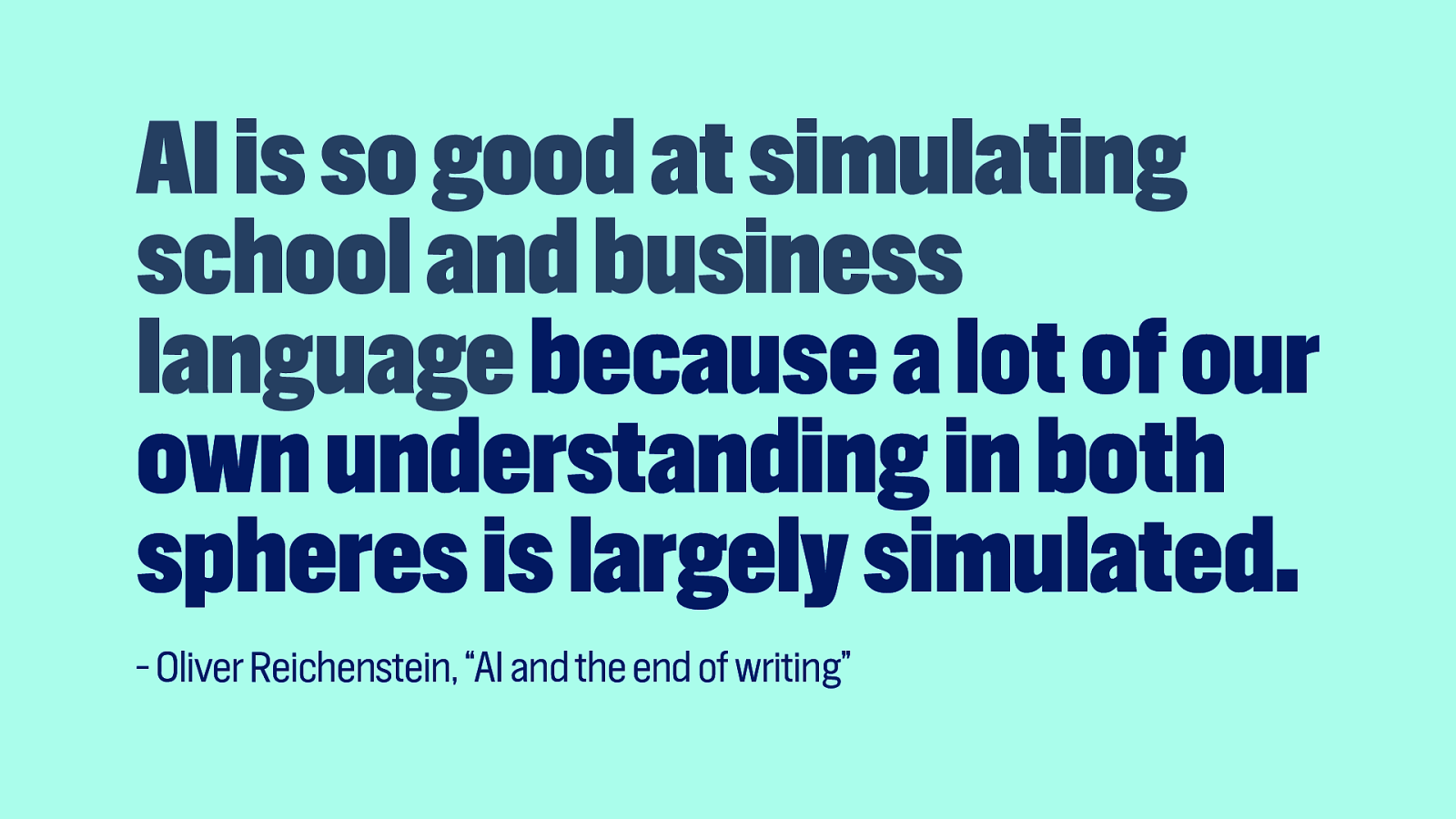
… because a lot of our own understanding in both spheres is largely simulated.
Slide 129
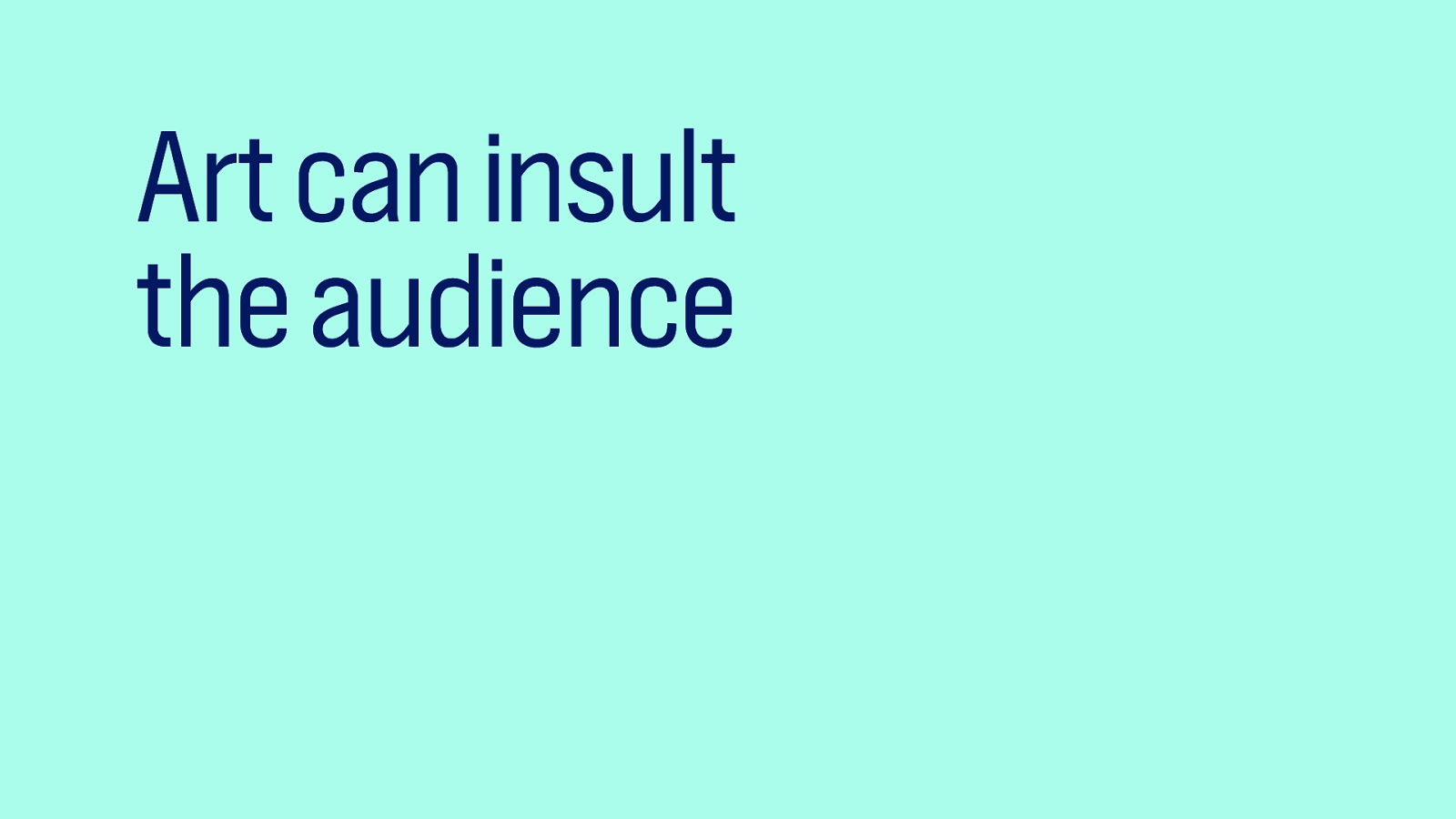
Art can alos insult the audience. There’s a play called “Offending the audience” by Handke, where actors mostly just shout at the audience and try to insult them.
Slide 130
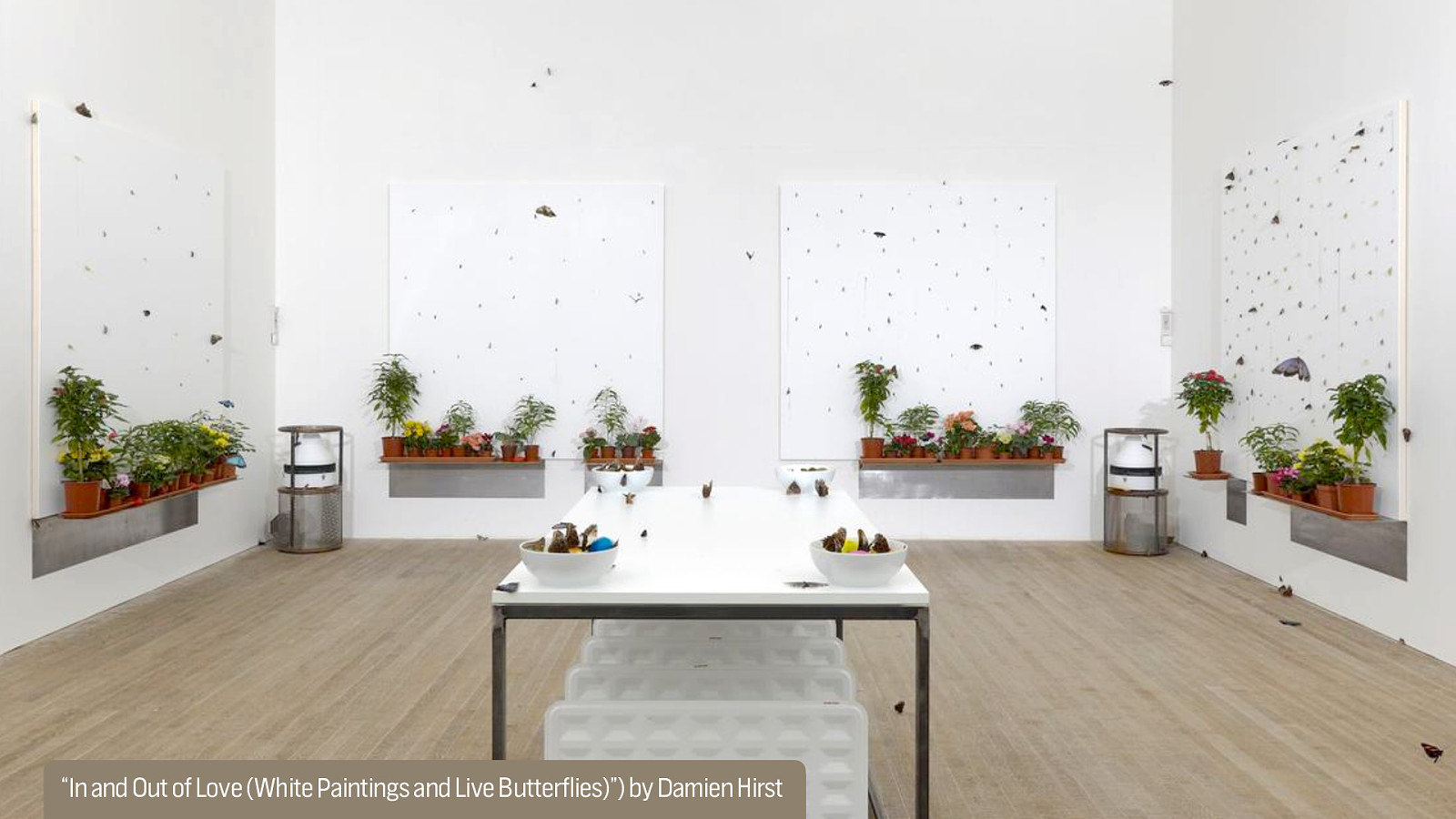
In the live art installation “In and Out of Love (White Paintings and Live Butterflies)”), Damien Hirst put 10,000s butterflies, and put glue on the walls, so that over time, they all stuck and died. Animal cruelty organisations were rightly mad at this.
Slide 131
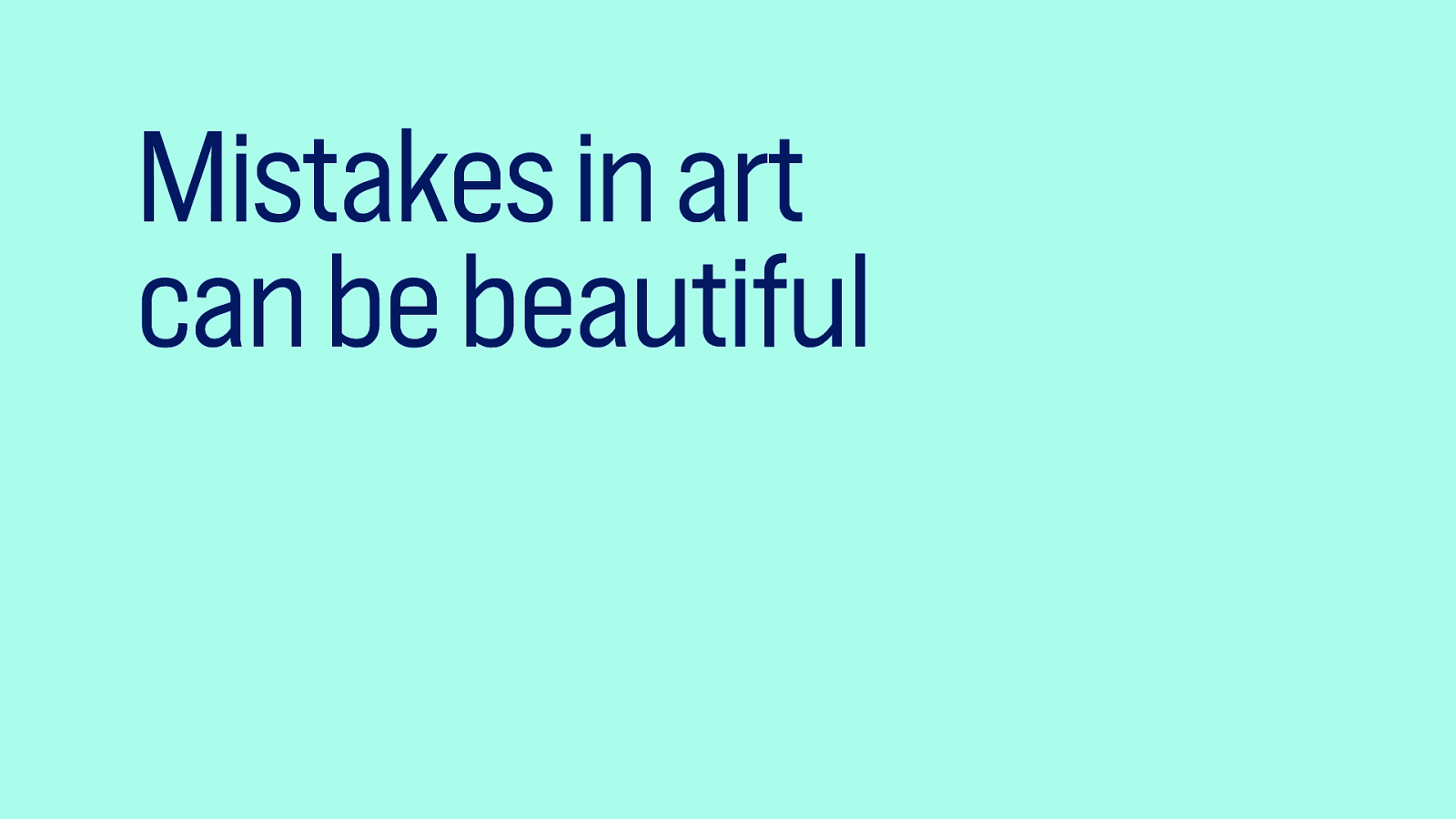
And one more thing about fitting in… generative AI tools like to make things that come across as perfect, but that kind of ignores that mistakes in art can indeed be beautiful. It’s often imperfection that makes art interesting.
Slide 132
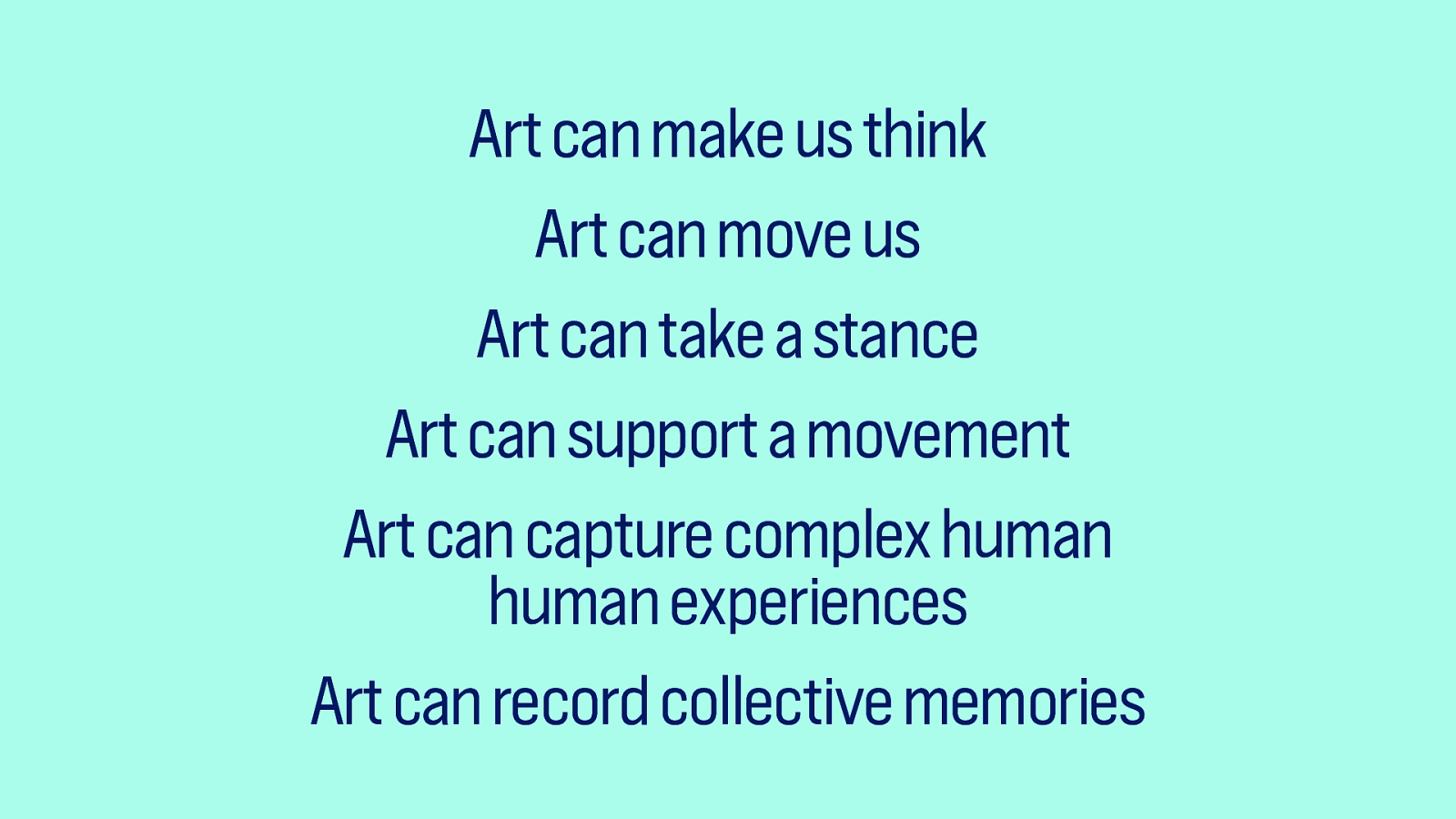
Okay, so in summary:
- Art can make us think
- Art can move us
- Art can take a stance
- Art can support a movement
- Art can capture complex human human experiences
- Art can record collective memories
Slide 133
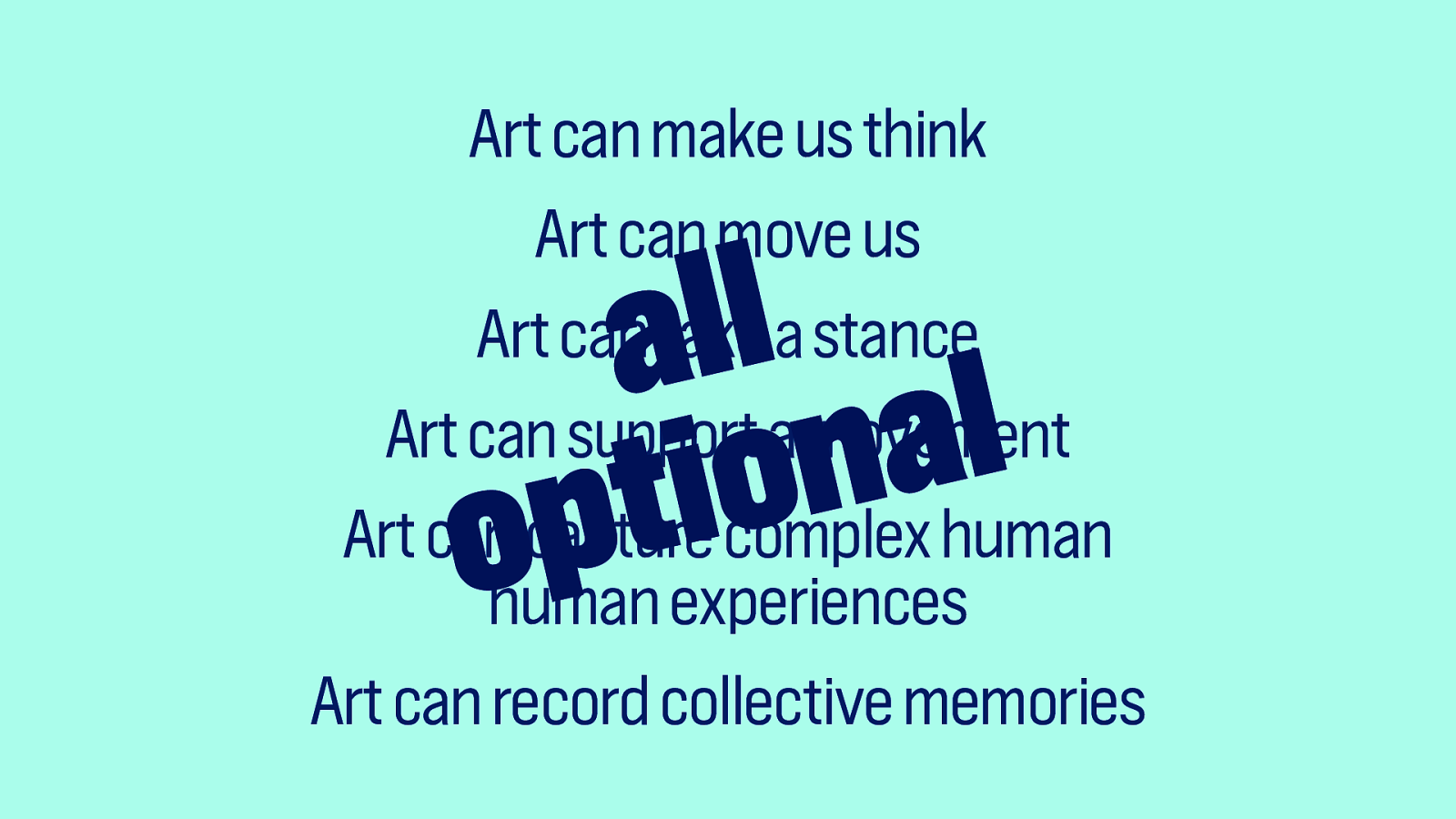
Note these are optional, art doesn’t have to do any of those things, it’s just things art is capable of bringing about. Which is a lot.
Slide 134
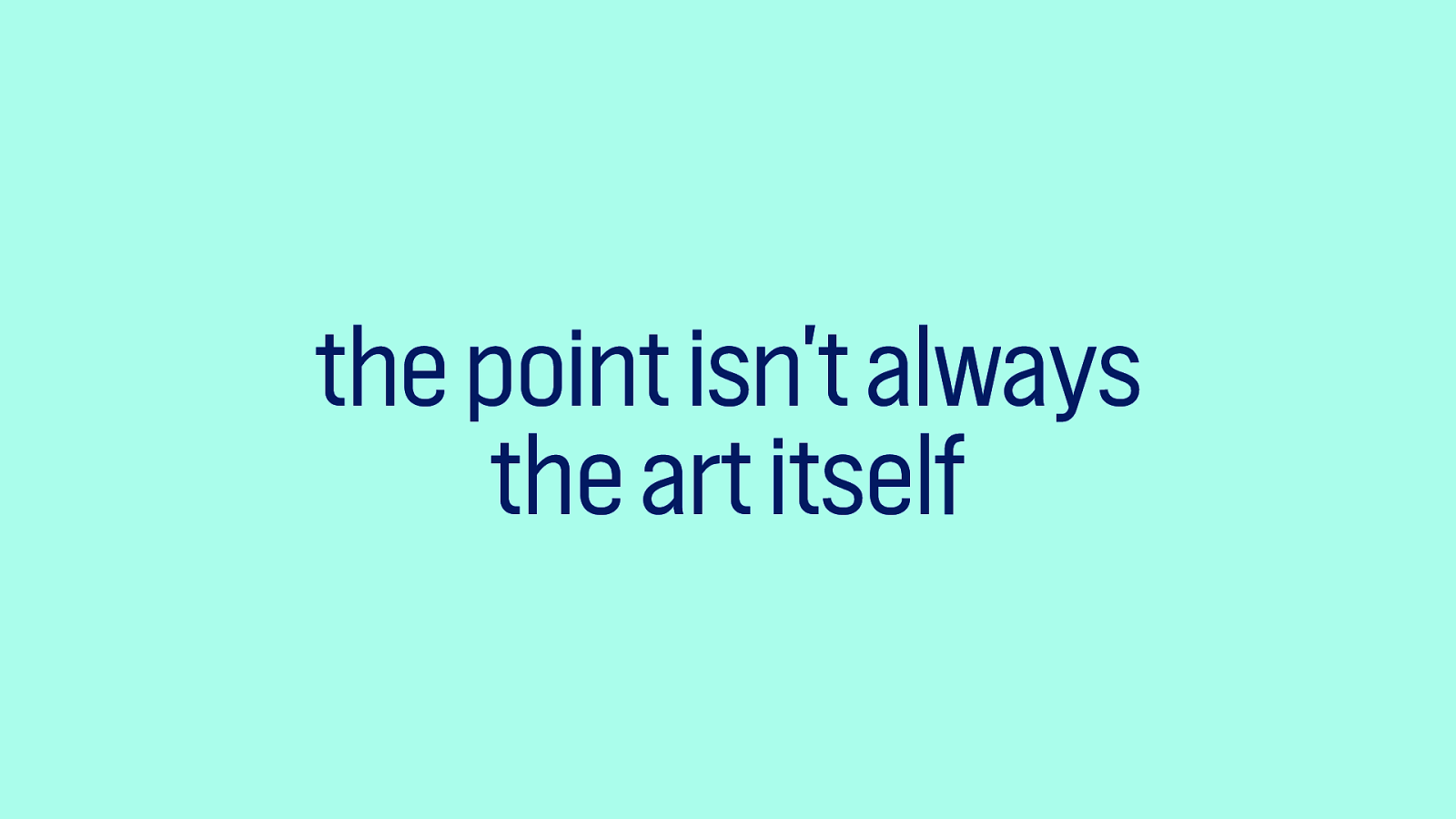
And that brings me to an important thing:
the point isn’t always the art itself.
Slide 135

There’s an artist, they might have intentions, might reflect… maybe they did research, had particular skills or world views… all of those things can make their way into the art, like the artifact itself.
It’s really hard to reproduce most of those with a system. That’s because it’s too much entropy! There’s an element of surprise to, like, where people go, where they are born, who they talk to throughout their live.
AI companies carefully, well I think carefully, curate the data sets they train on. But this… this is a dataset that would be impossible to gather, not even if we cover any inch of the planet with data centres.
Slide 136
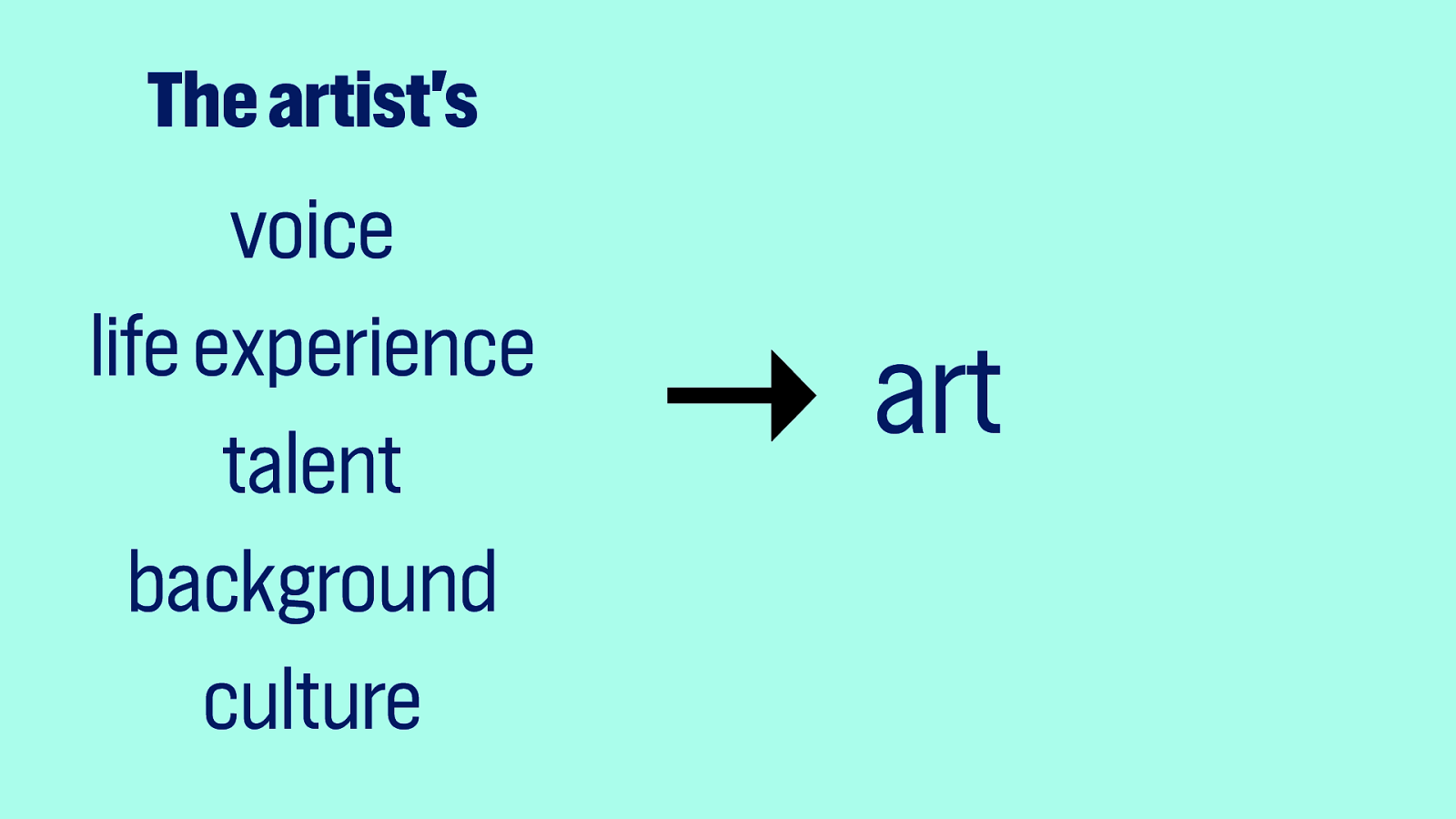
A person’s unique voice, their life experience, talents, backgrounds, culture… it could all end up in the art someone makes.
Slide 137
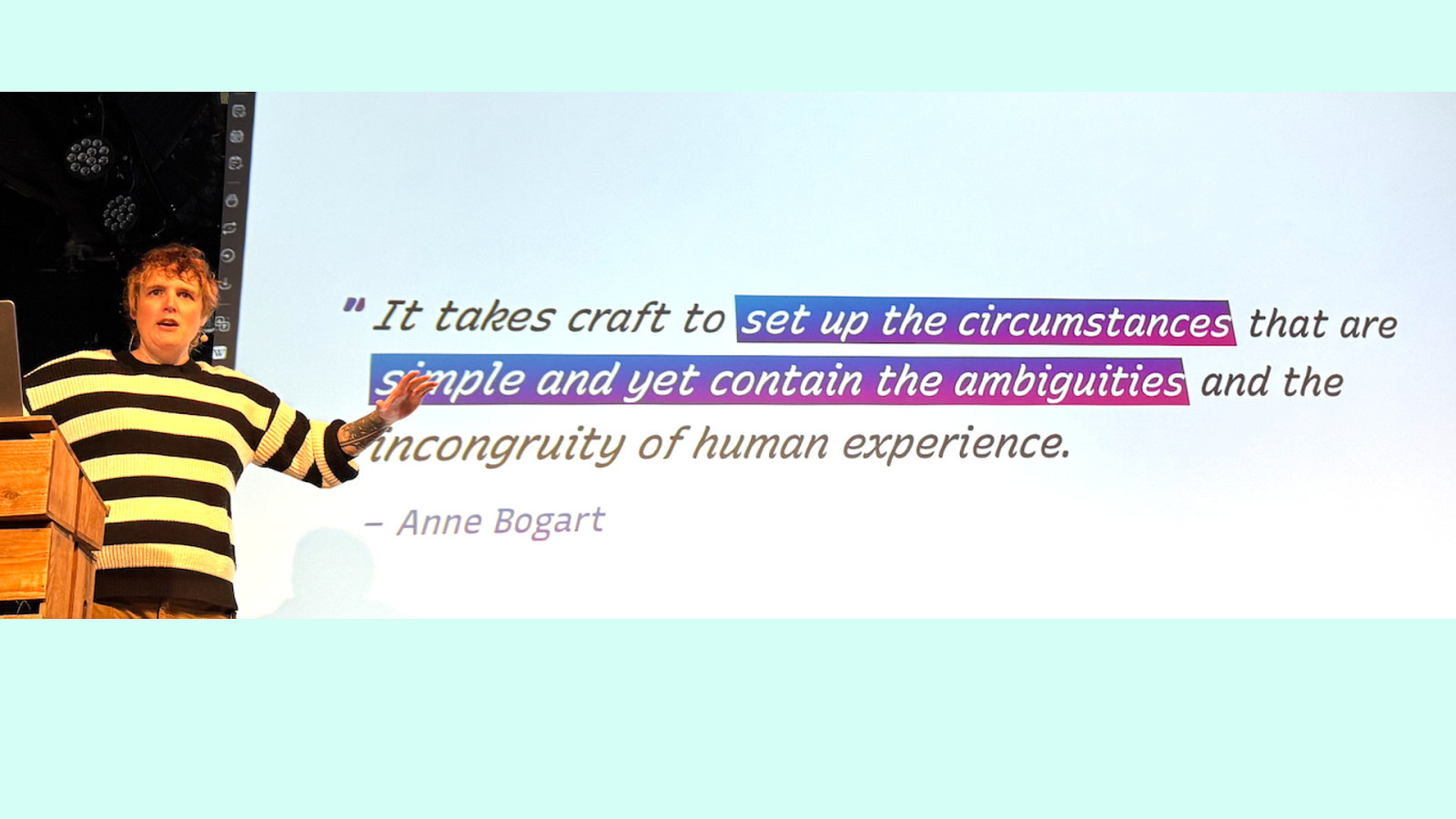
Art can be hard to make, as Mia said that Anne Bogart said: ‘it takes craft to set up the circumstances that are simple and yet contain the ambiguities and the incongruity of human experience”.
Slide 138
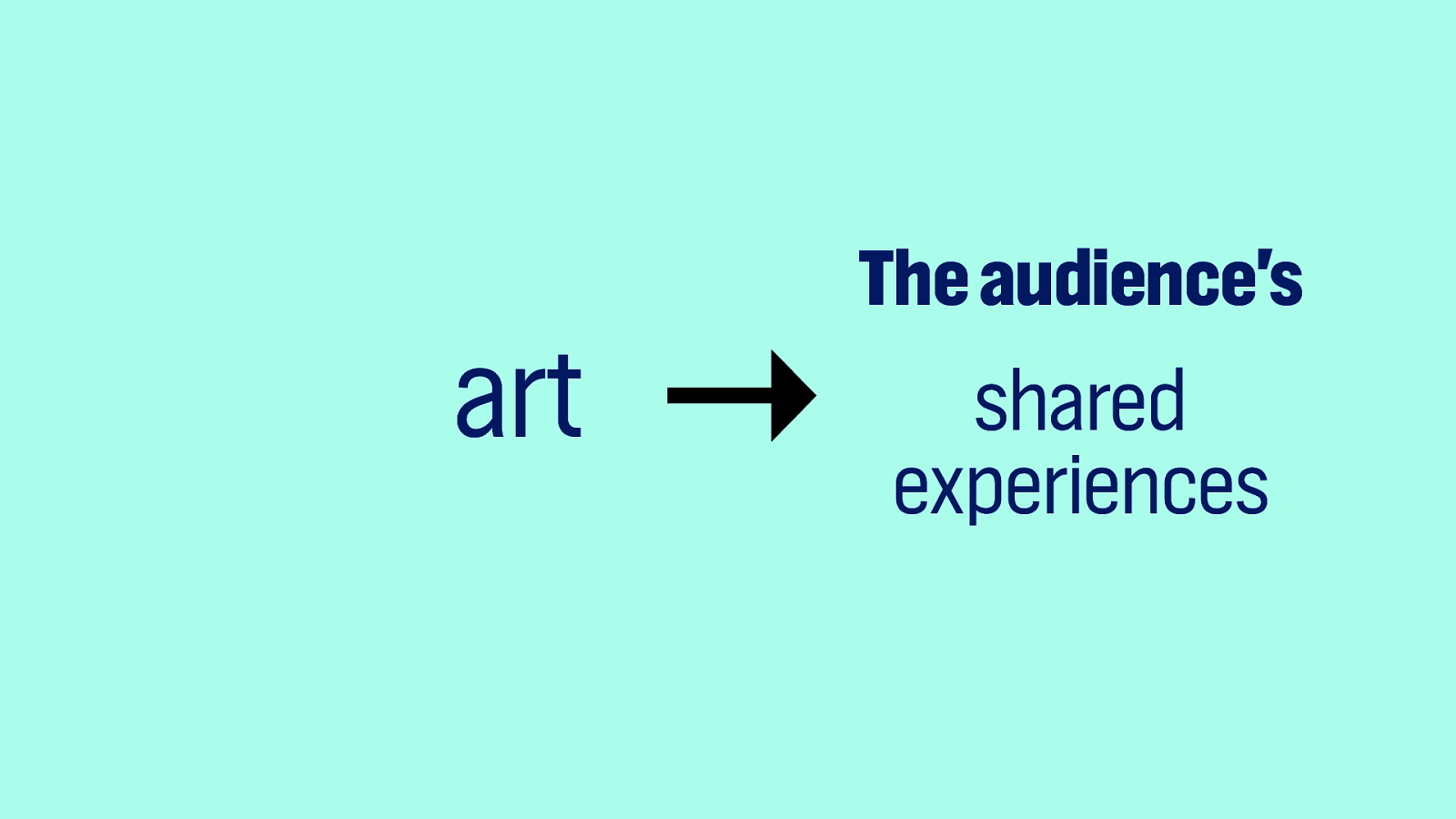
And there’s something on the other side of art too… there’s things that go into art, like I just discussed, but also things that come out of it.
Like an audience’s shared experience.
Slide 139
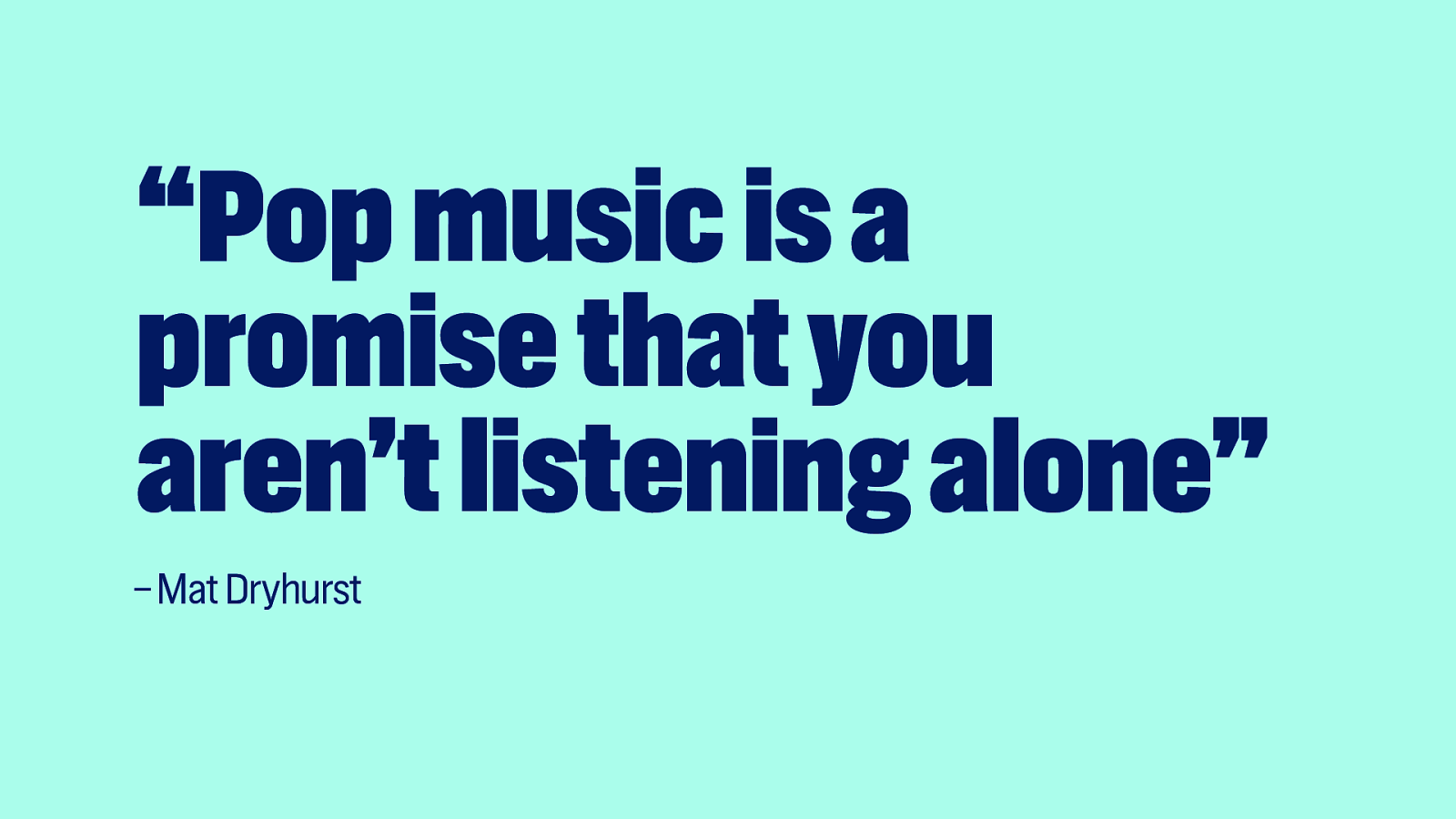
Pop music is a promise that you aren’t listening aloen.
Slide 140
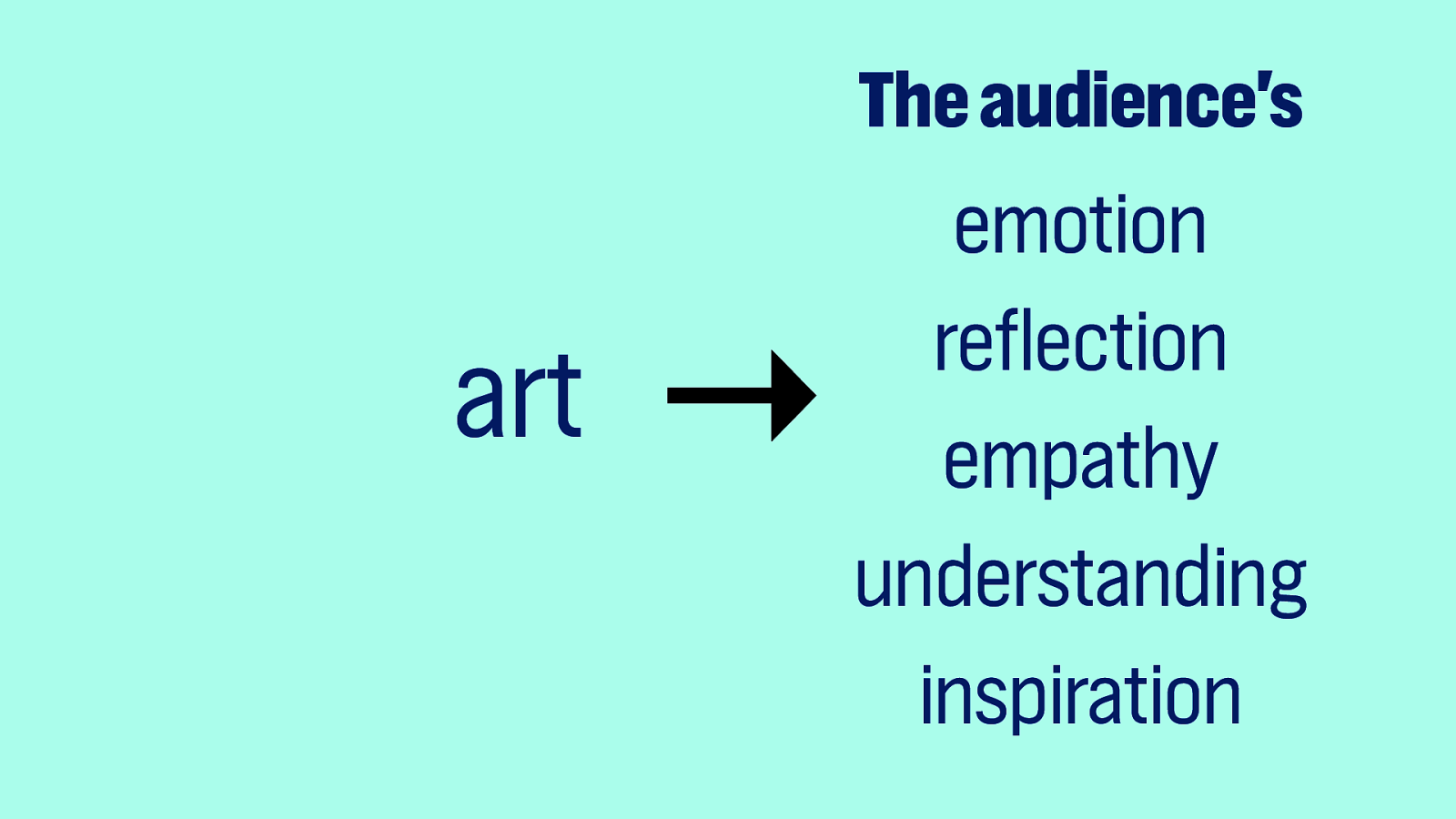
Art could inflict lots on the people experiencing it: emotions, reflections, empathy and understanding towards others… inspiration…
Slide 141

and that made me think of a metaphor, sorry, bit of an overused metaphor, but hear me out.
An iceberg in the sea usually has MOST of the iceberg under the surface level, there’s only a tip that we can see that’s above.
Maybe that tip is the artwork, and everything else, arguably the most important bits and the hardest to capture in training data, is invisible, and under the sea.
Slide 142

It’s largely not about the artifact… if we bought 4 more urinals, they wouldn’t be as significant as Duchamp’s first. That was the special time in art history, that he decided to send that one in.
Slide 143
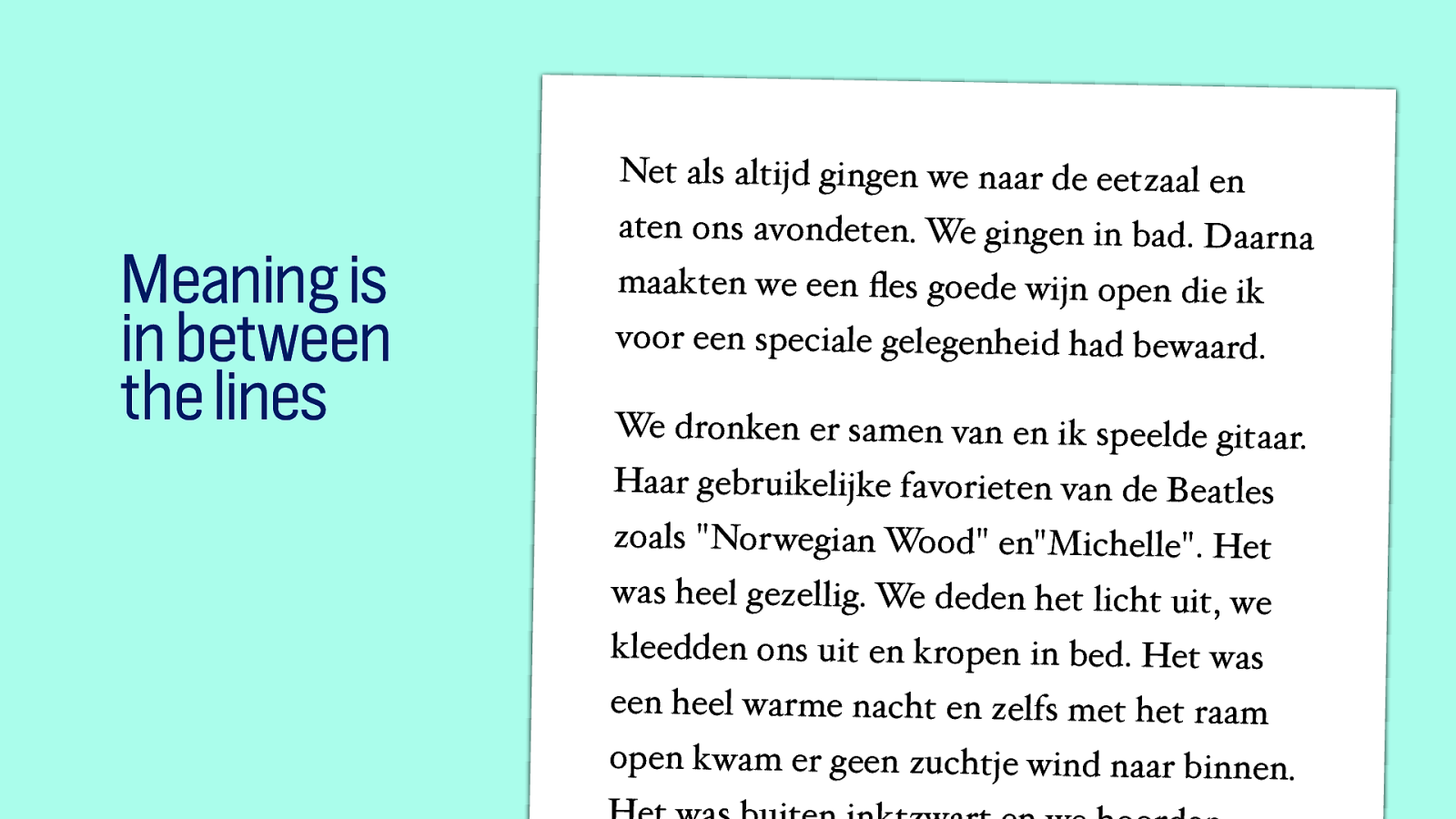
Meaning is often not in the lines, it’s between the lines.
Slide 144
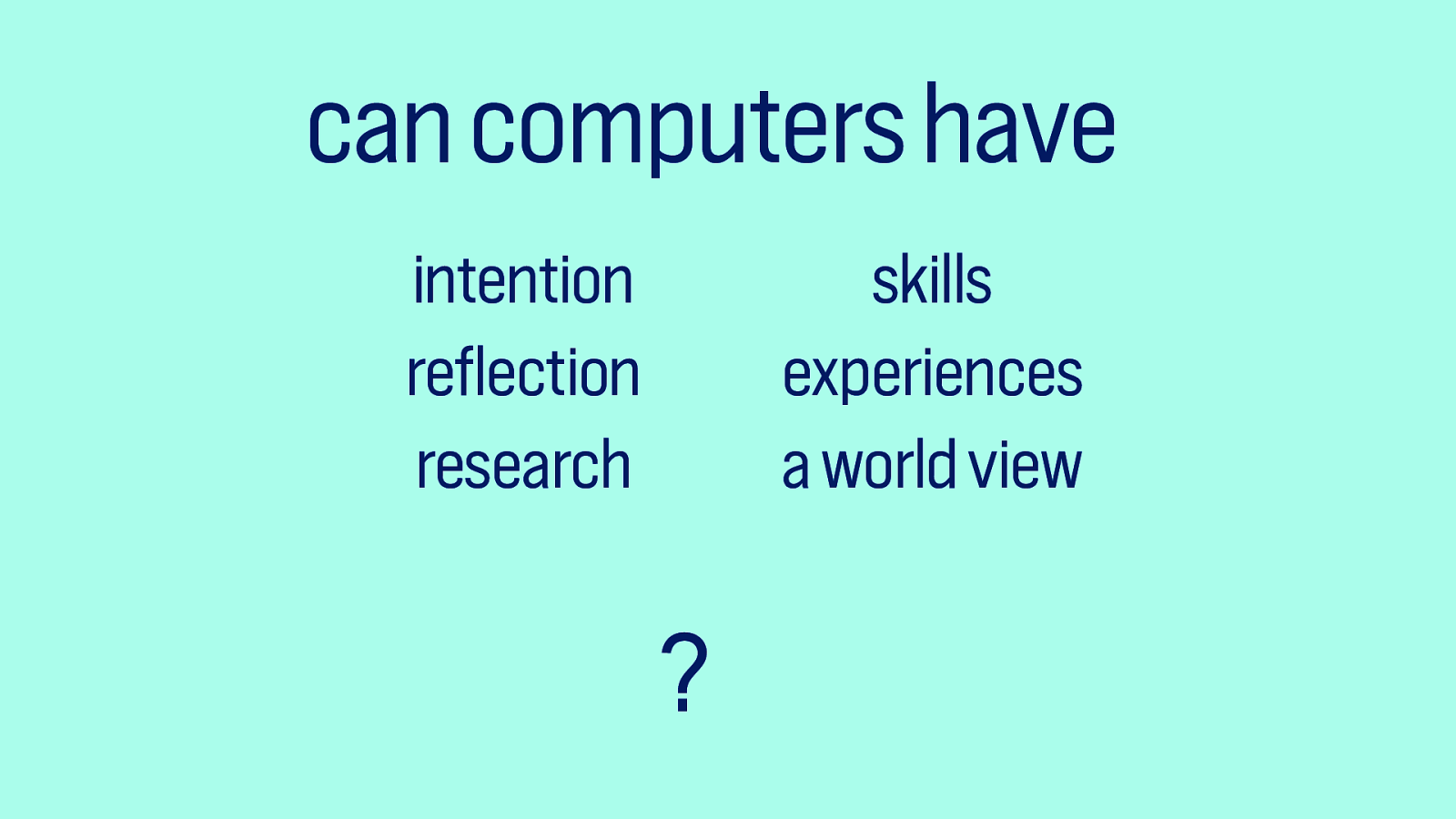
My question for you… can computers have intention? skills? reflections? experiences? research? a world view?
Slide 145

And to be clear, computers are fantastic tools.
I love techno music, and while there’s analog techno, I am glad software exists, I love what Tobi has been doing here in the last few days.
Slide 146
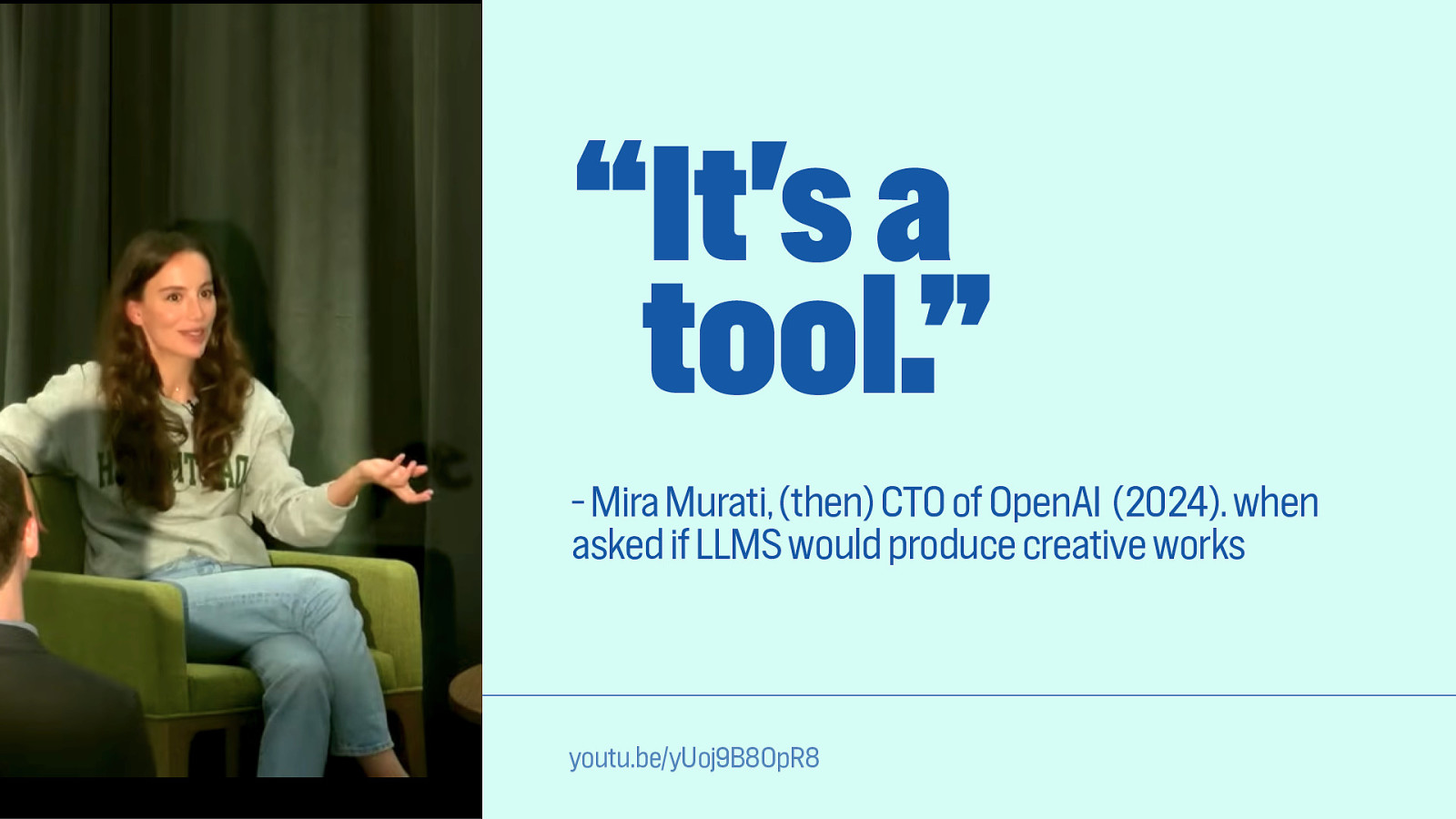
When Mira Murati, (then) CTO of OpenAI, was asked if LLMs would produce film scripts and stuff, she answered “it’s a tool”.
And I think she’s right, it’s a tool, like pencils are.
Rembrandt or Van Gogh probably had a specific brand of paint, and pencils and brushes… but was there hype about which brand? Did the pencil companies get to claim his creativity as theirs?
Slide 147

Okay, so, tools… yes they’re great. But when we want to use AI tools specifically, as part of a production process, there are some open questions I can’t ignore. I’ll go through them real quick.
Slide 148

First, environmental impact. This year, big tech is letting go of their net zero goals and buying / using nuclear power plants to meet the power demands of their data centres. People who live near them see their household energy rates go up.
I can’t emphasise how serious this problem is, as we’re currently so far from meeting the Paris goals, and not meeting it threatens our ability to live (and compute) on this planet.
Slide 149
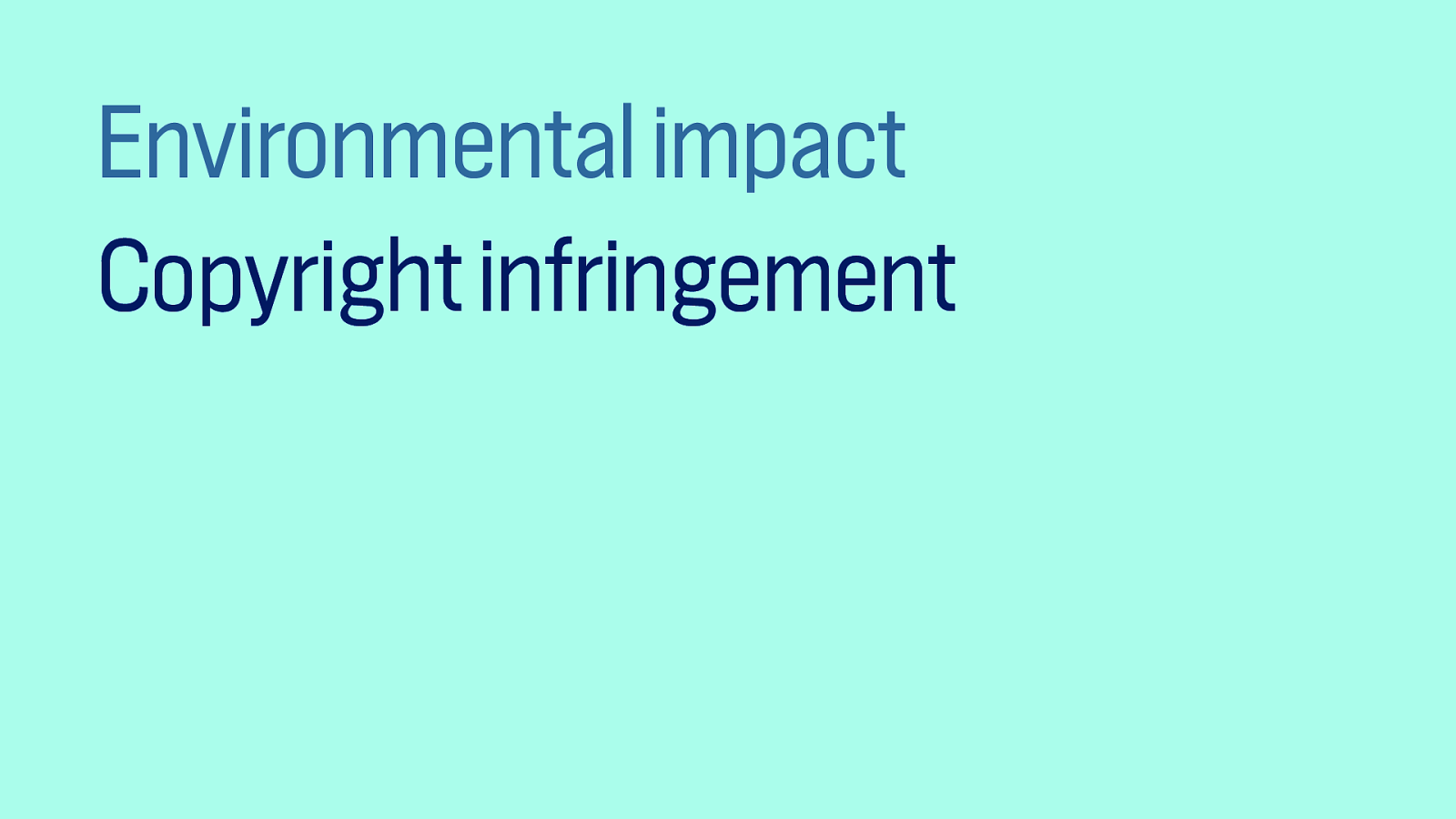
There’s also the issue of copyright infringement in training data.
Slide 150

OpenAI told the UK House of Lords Communications and Digital committee that it would be impossible to train today’s leading AI models without using copyrighted materials. Hm… but that doesn’t seem to make violating copyright fiar.
Slide 151
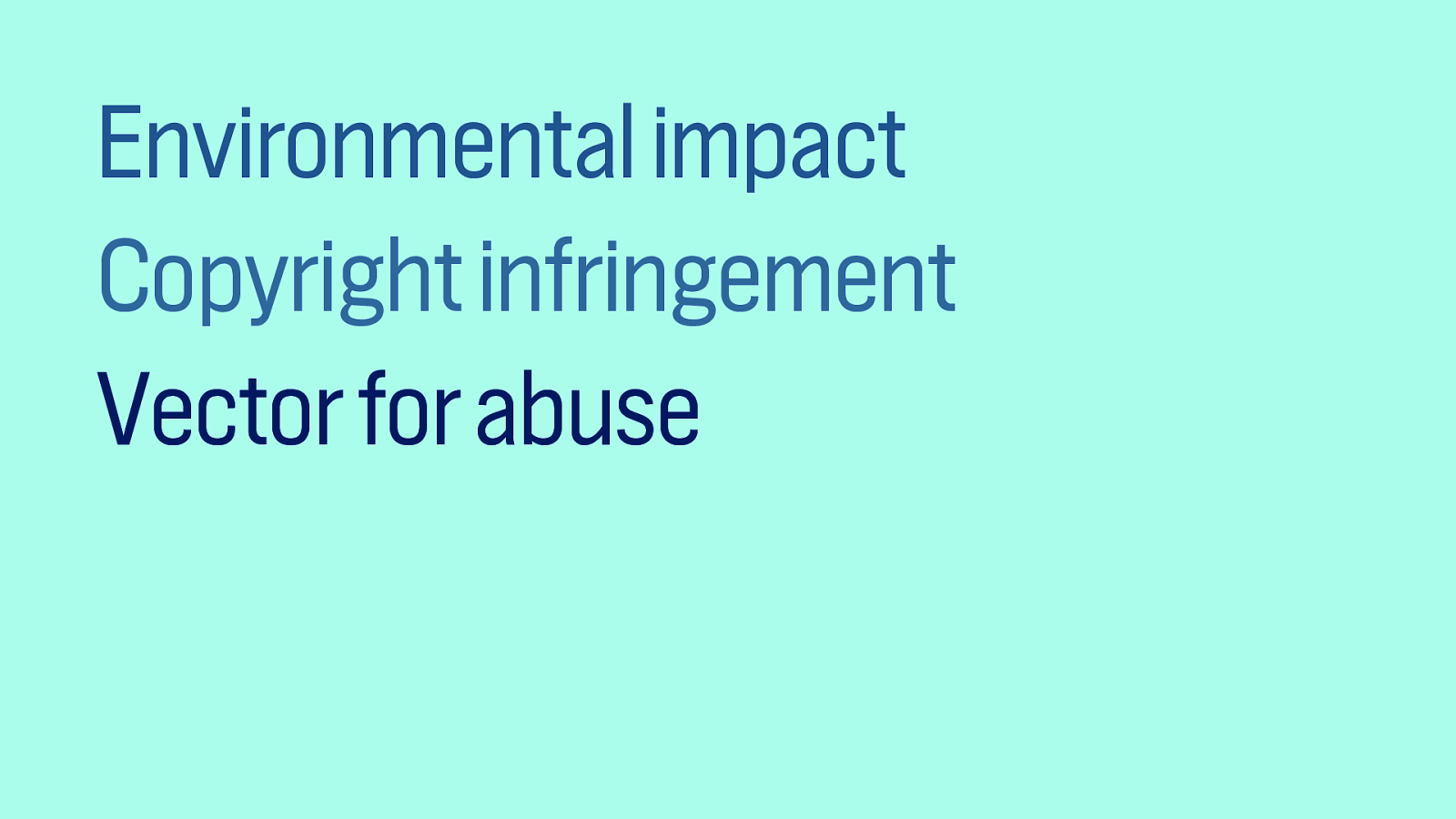
Generative AI is also a vector for abuse, with fake news currently widely supporting dictatorships and the extreme right, and AI pornography featuring people, usually women, who did not want or agree to be in that.
Slide 152
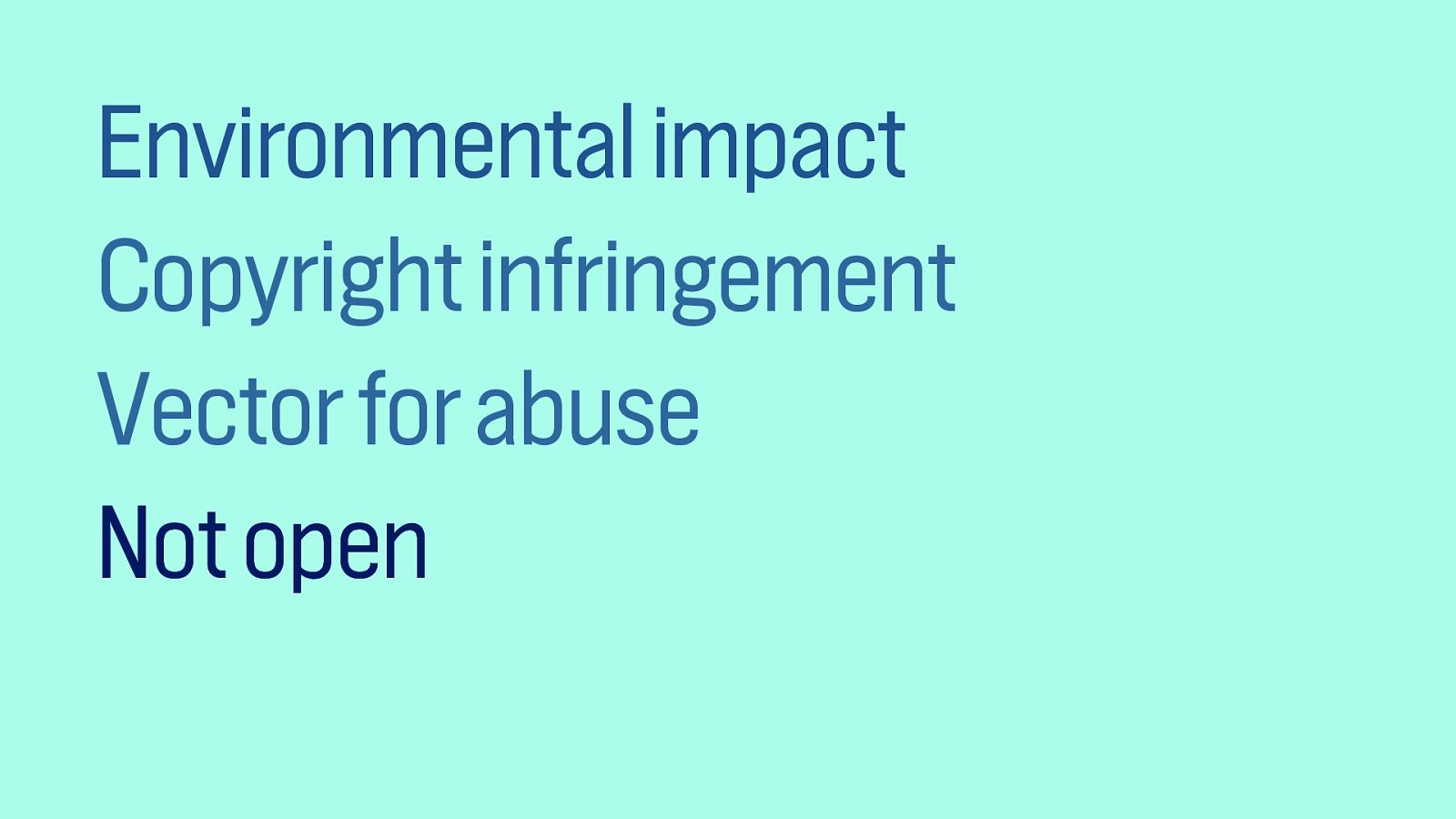
It’s also not open. That’s a problem for researchers who want to look at issues like bias.
Slide 153
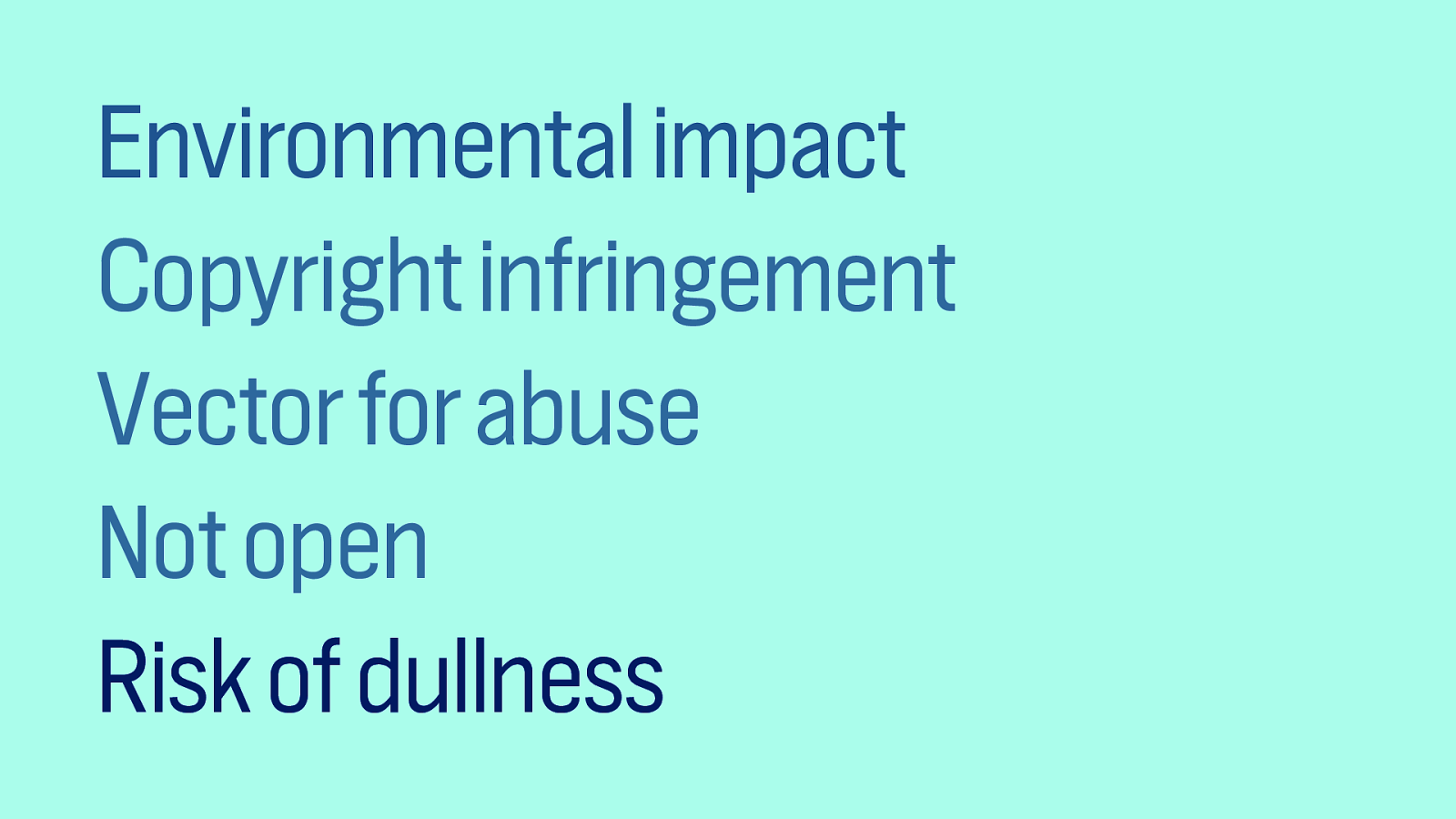
And lastly, probably the most important for today’s talk: risk of dullness.
Slide 154
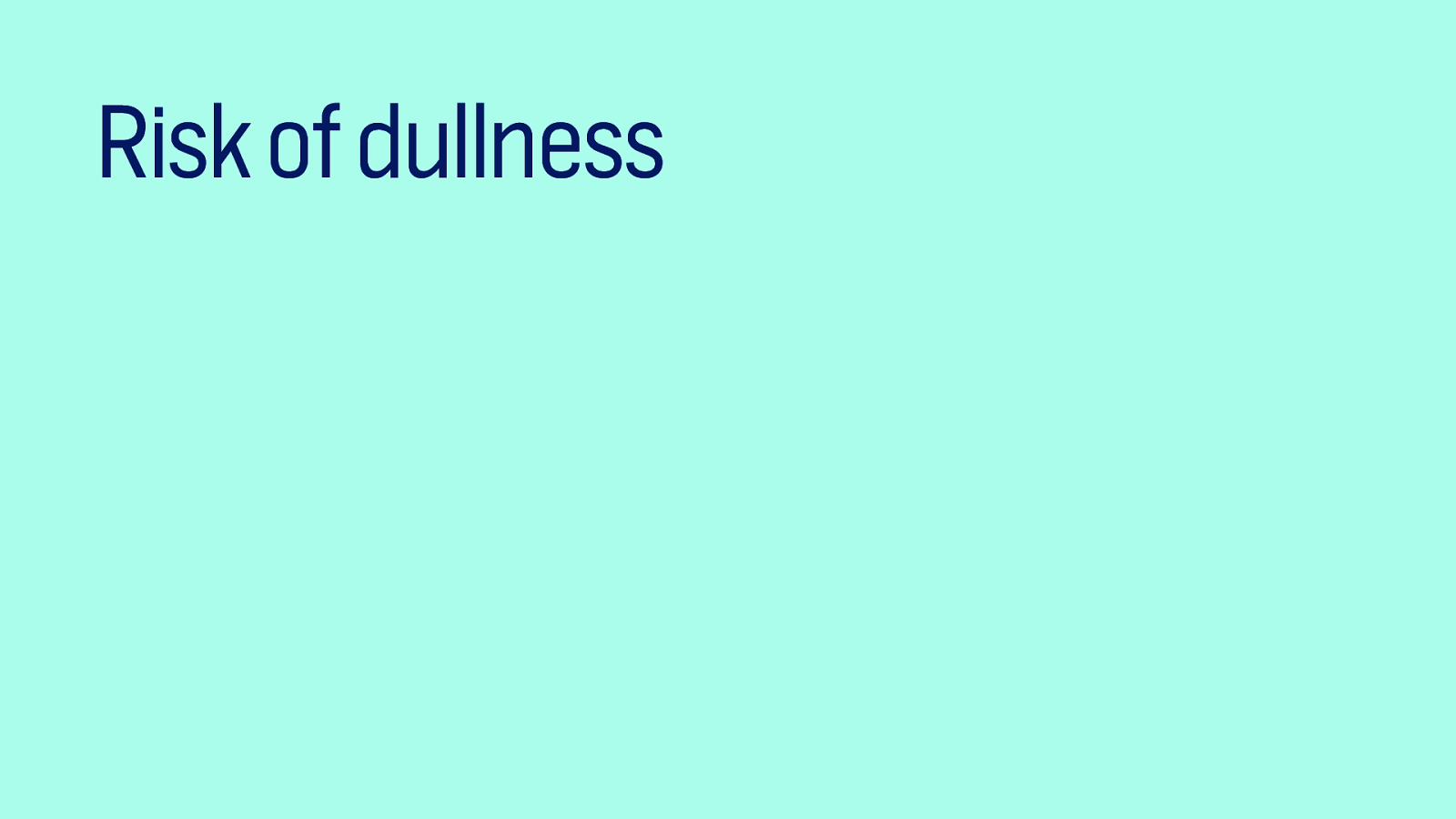
When I look the AI generated images or texts people put on LinkedIn today, I still feel it’s easy to recognise, from far away, how they were produced.
I love creativity, not dullness!
Slide 155
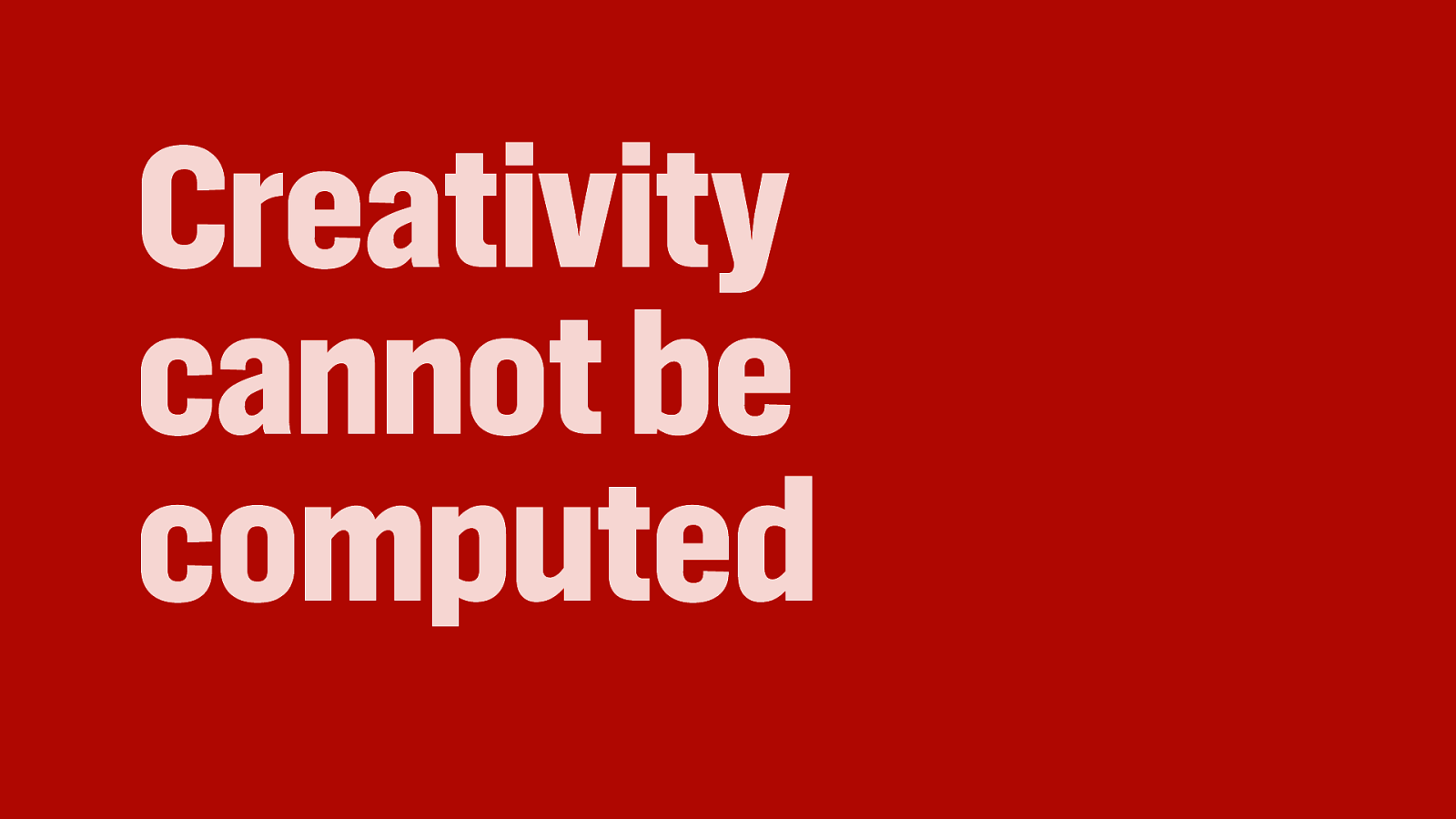
Ok, moving to conclusions: while some art can be automated, I think creativity cannot be computed.
Slide 156
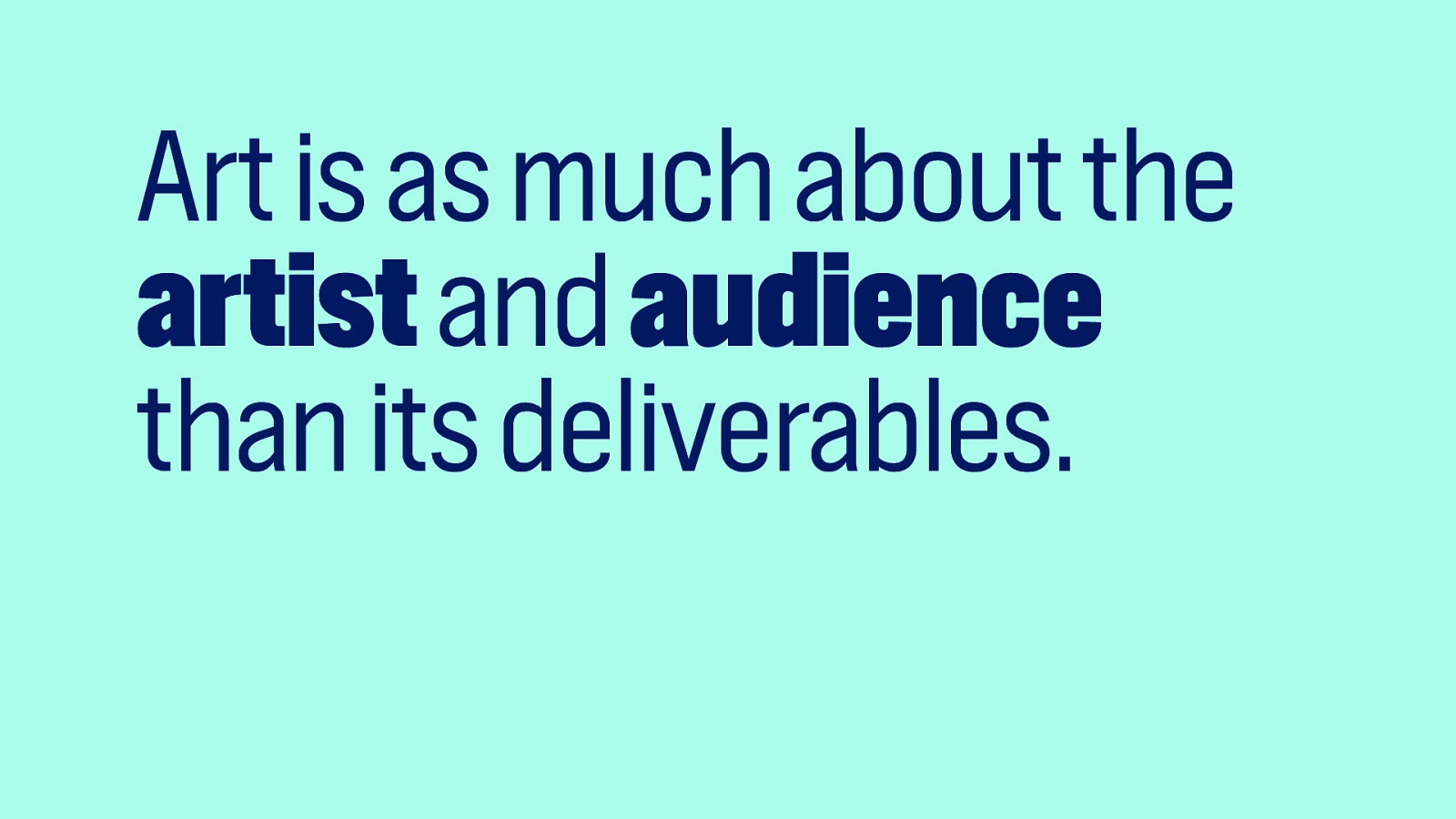
Art is as much about the artist and audience than it is about its deliverables.
Slide 157

Lovelace keeps haunting me in my dreams… it’s this possibility of exaggerated ideas… there’s a lot of hype and it may just be the case that it is not be entirely true that AI can be creative.
Slide 158

Of course, we can use computers to express ourselves creatively.
Slide 159
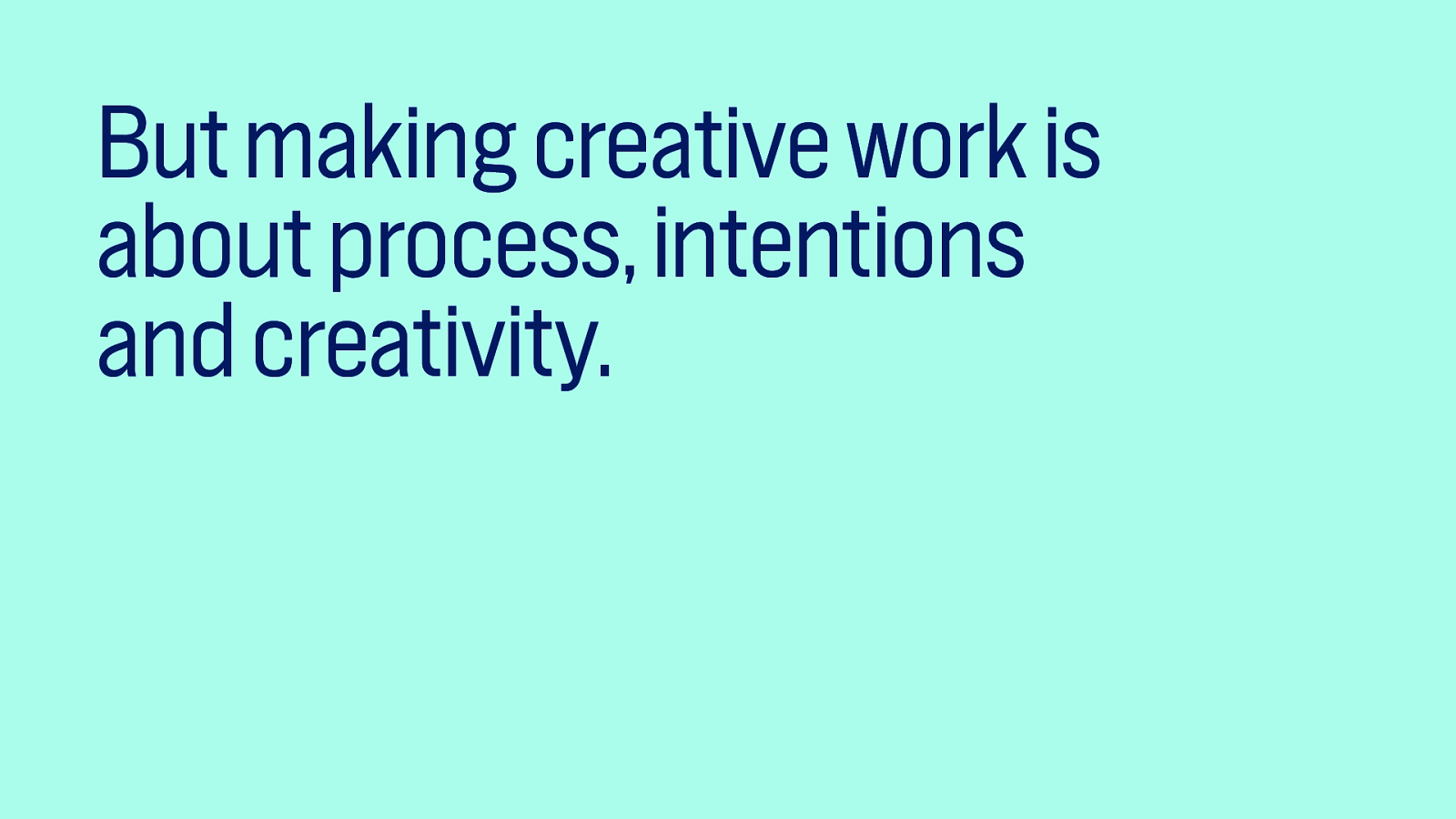
But making creative work is about process, intentions and creativity.
Slide 160
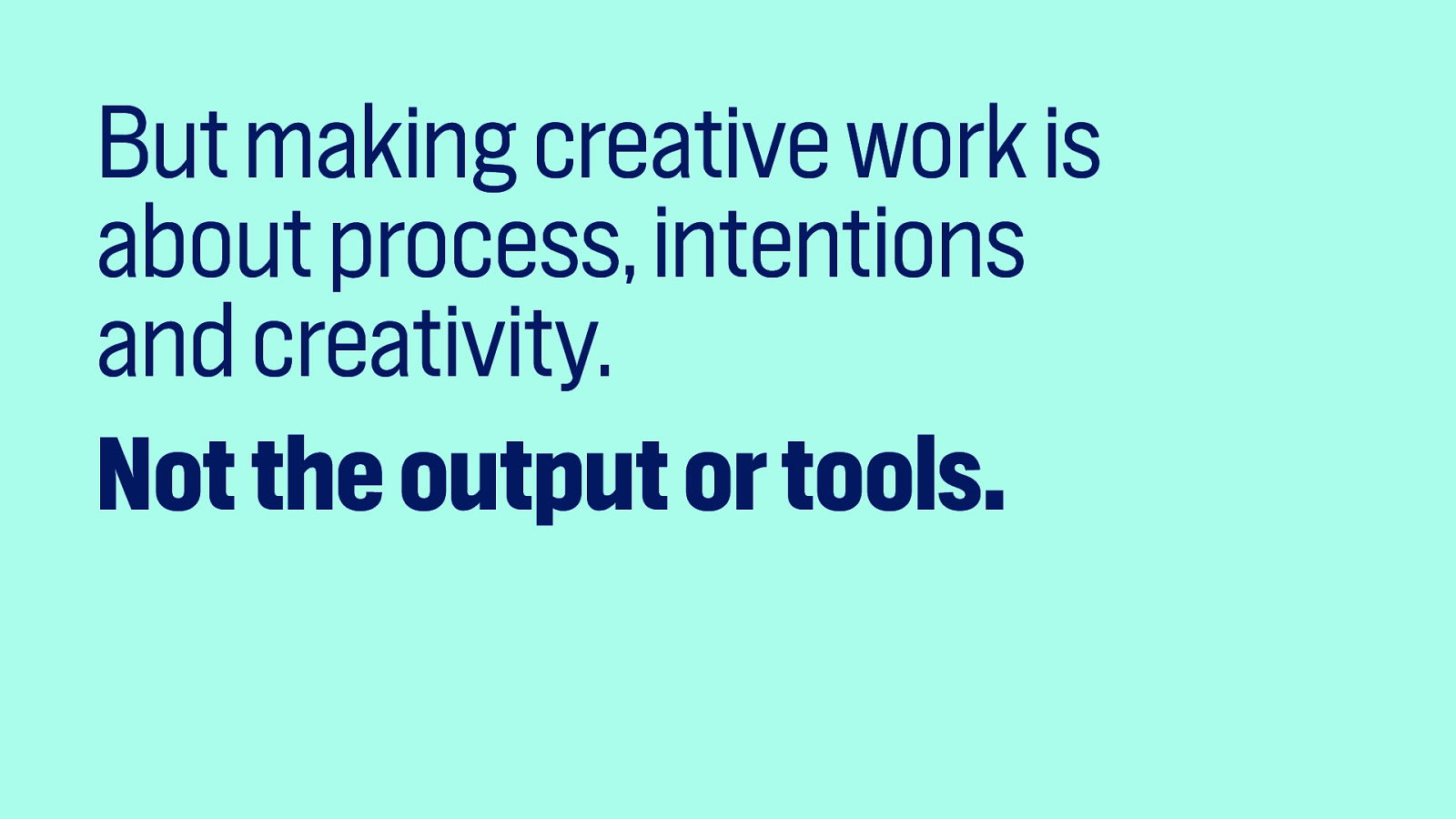
Not the output or tools.
Slide 161
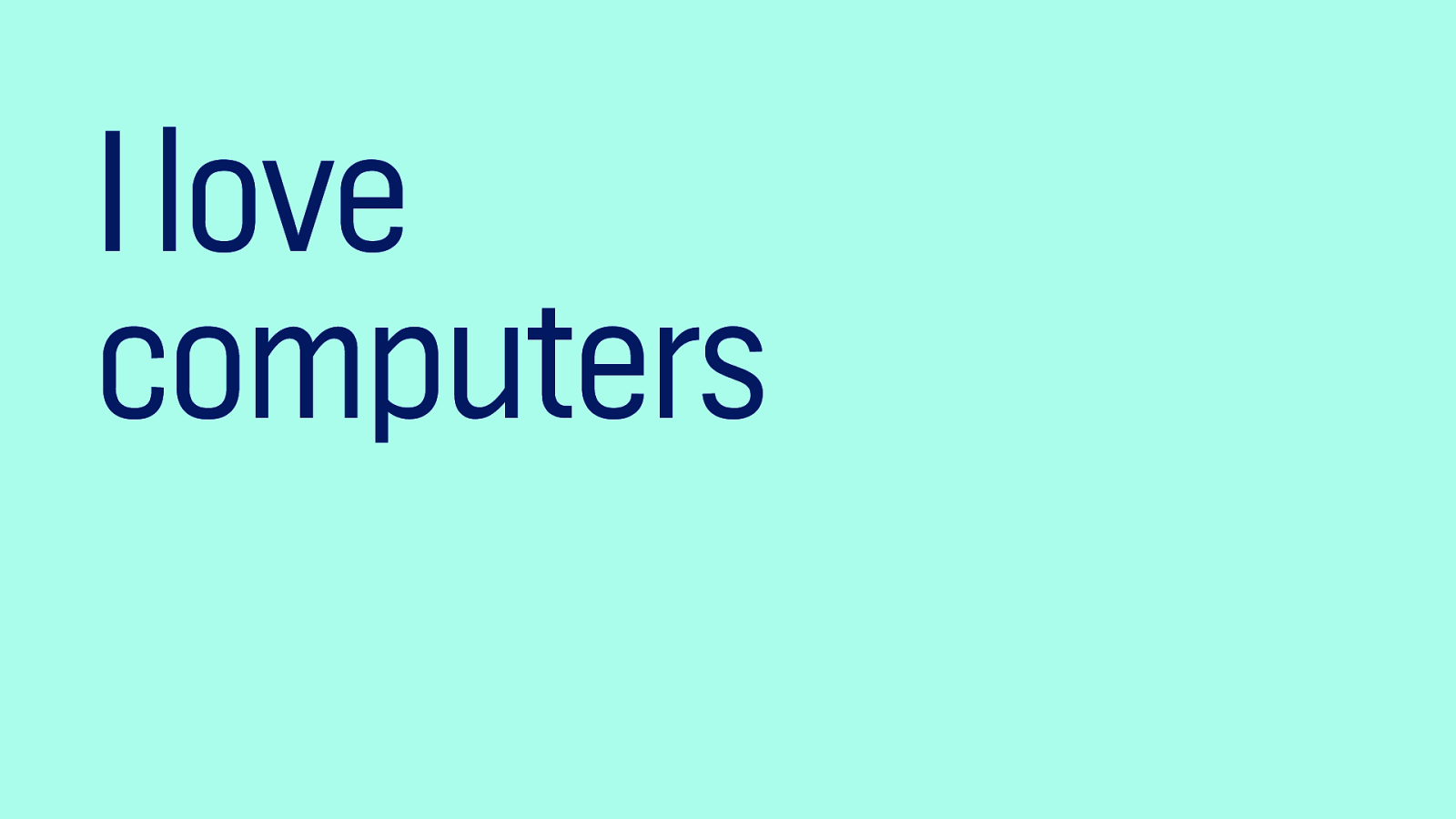
I love computers
Slide 162
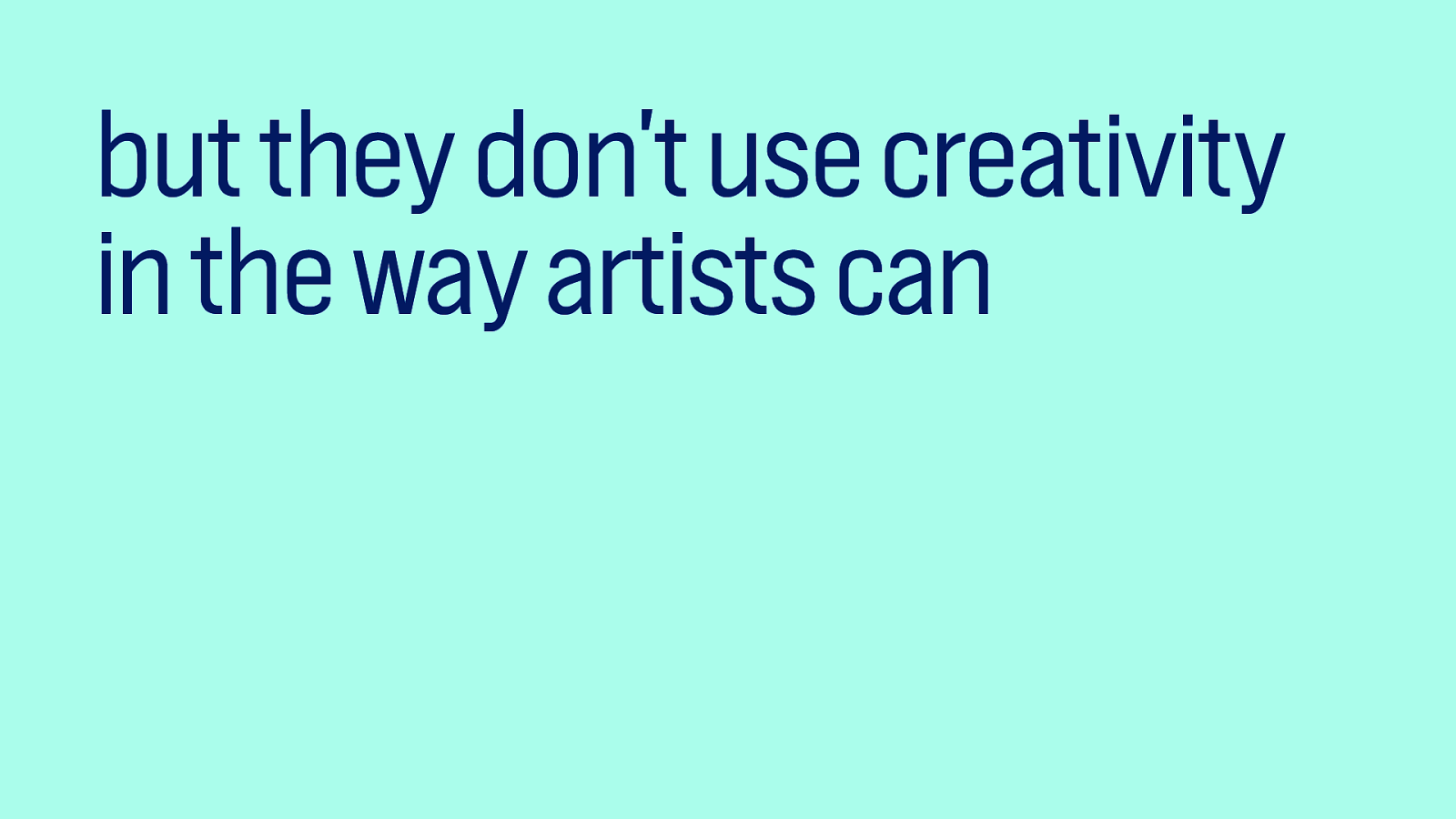
but they don’t use creativity in the way artists can
Slide 163
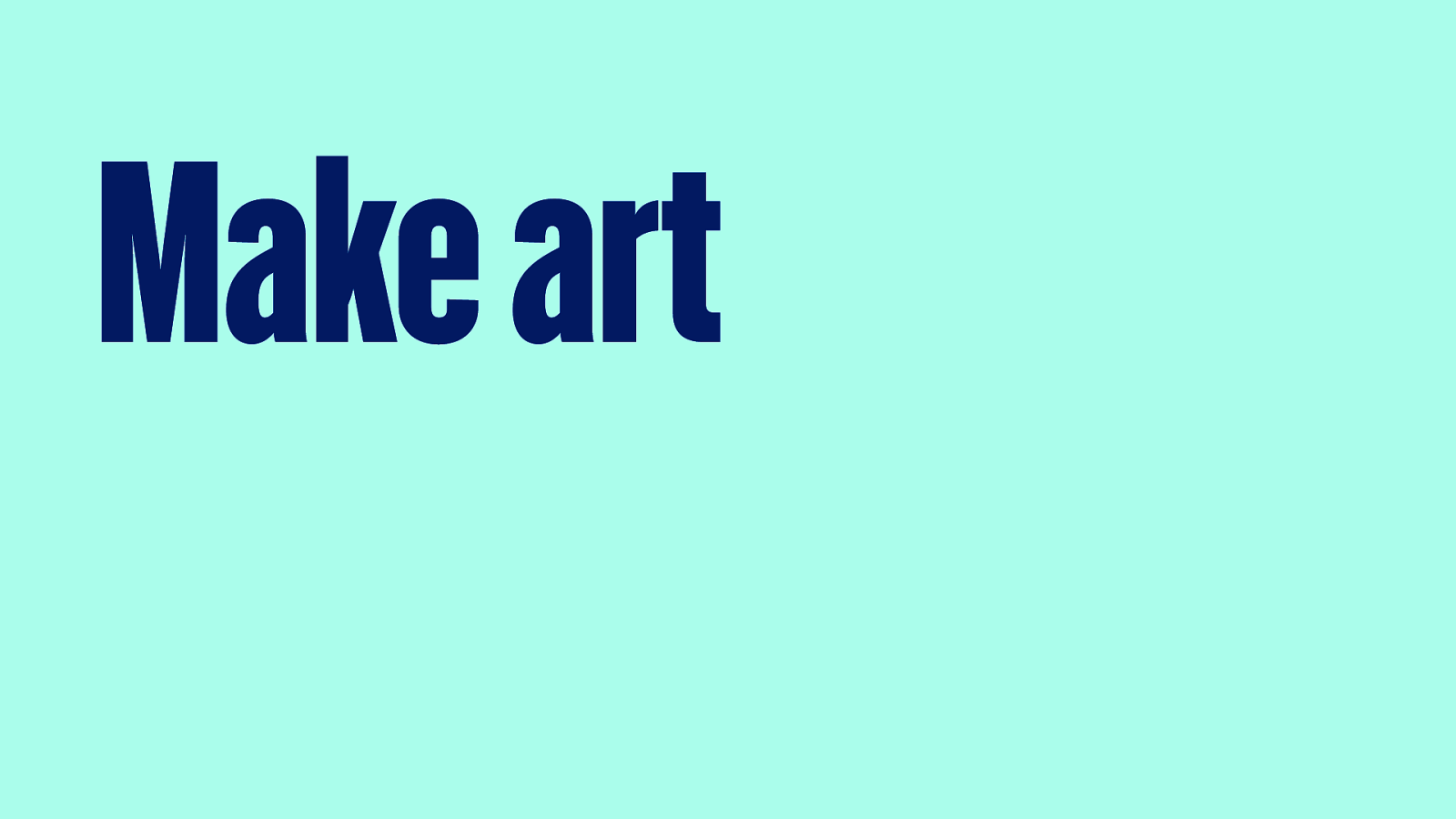
So my advice is two-fold. First, make art. Join a choir or pottery class. Start painting, make weird novelty websites.
Slide 164
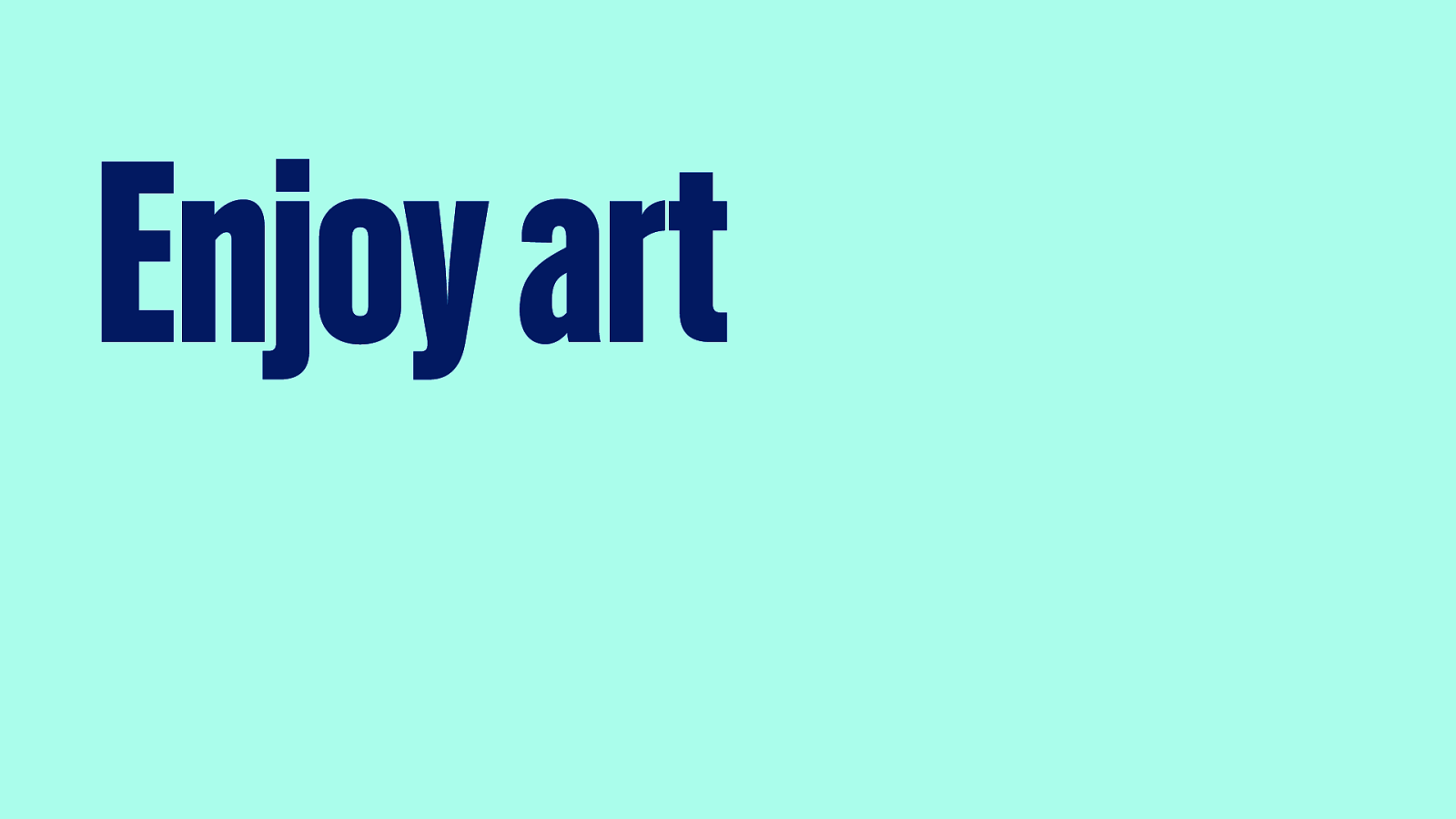
And second: enjoy art. Get out to your local theaters, museums, music venues… they are the best thing to spend your money on.
Slide 165
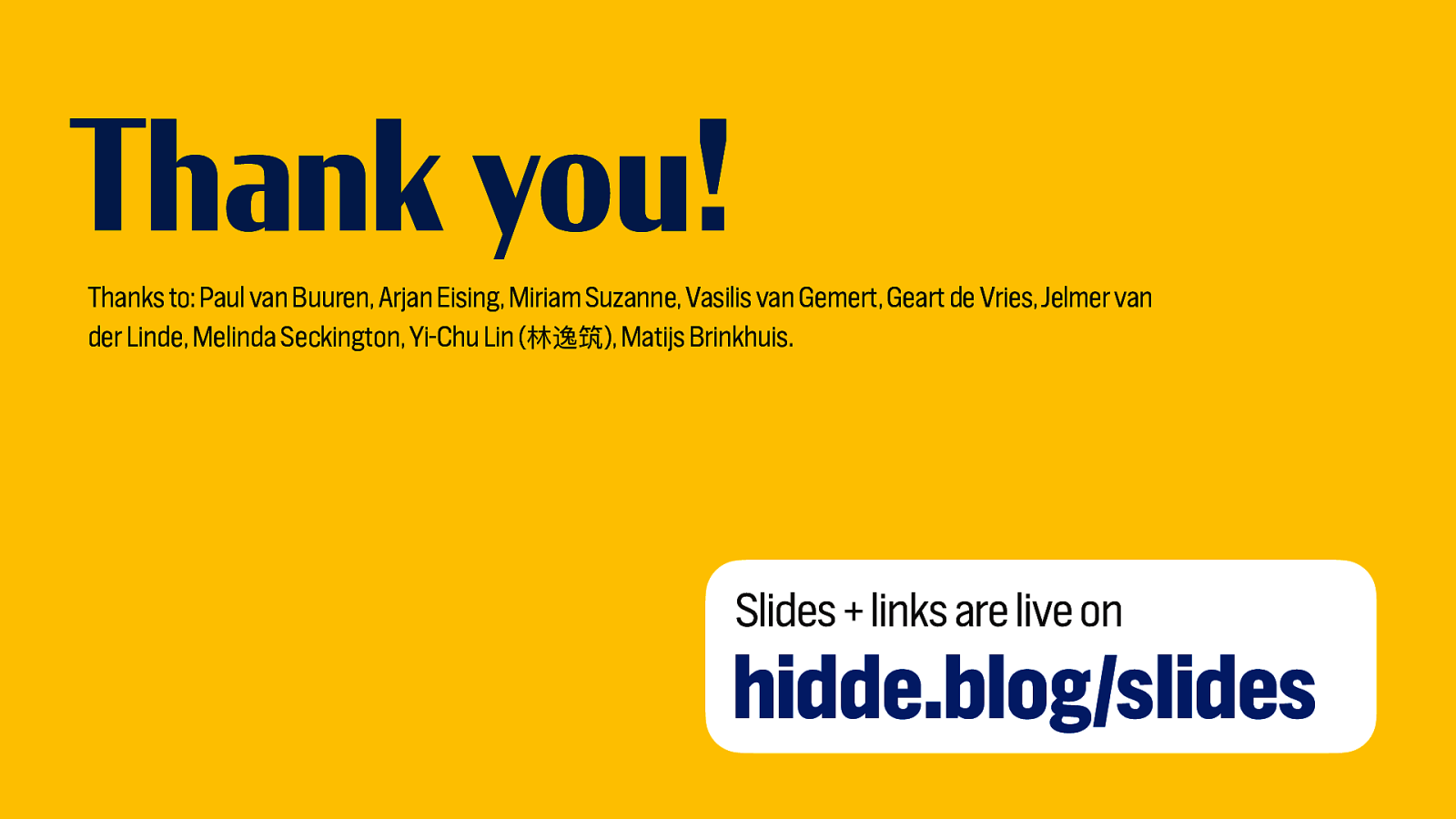
Thank you! My slides are live!
Slide 166

Books Du Sautoy, The Creativity Code. Boden, Creativity and art (2010). Hofstadter, Fluid Concepts and Creative Analogies: Computer Models Of The Fundamental Mechanisms Of Thought (2008).